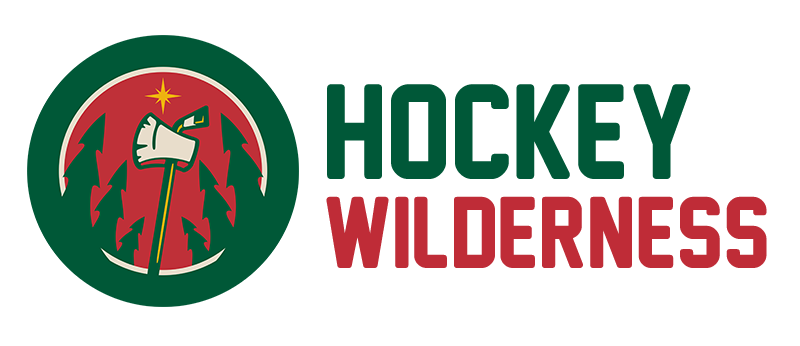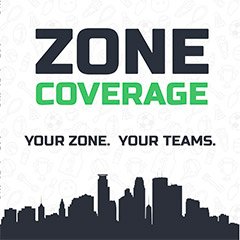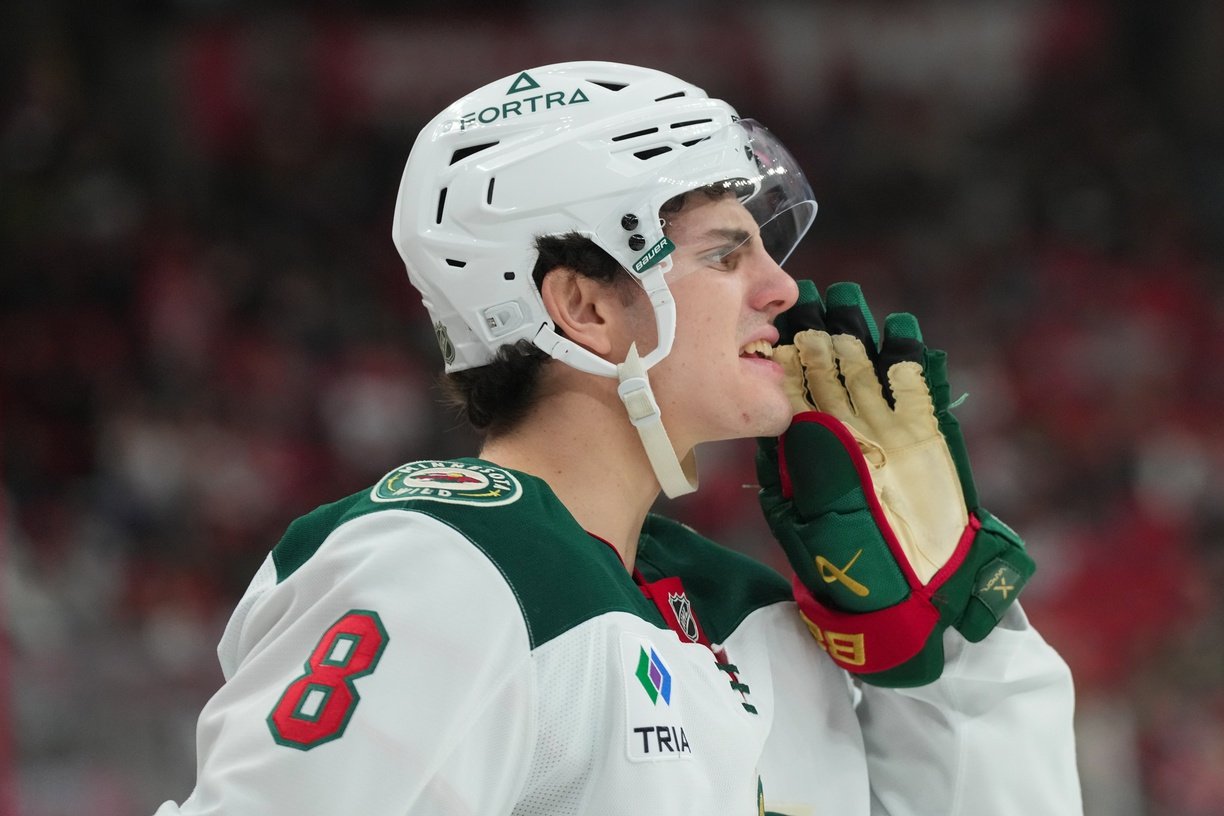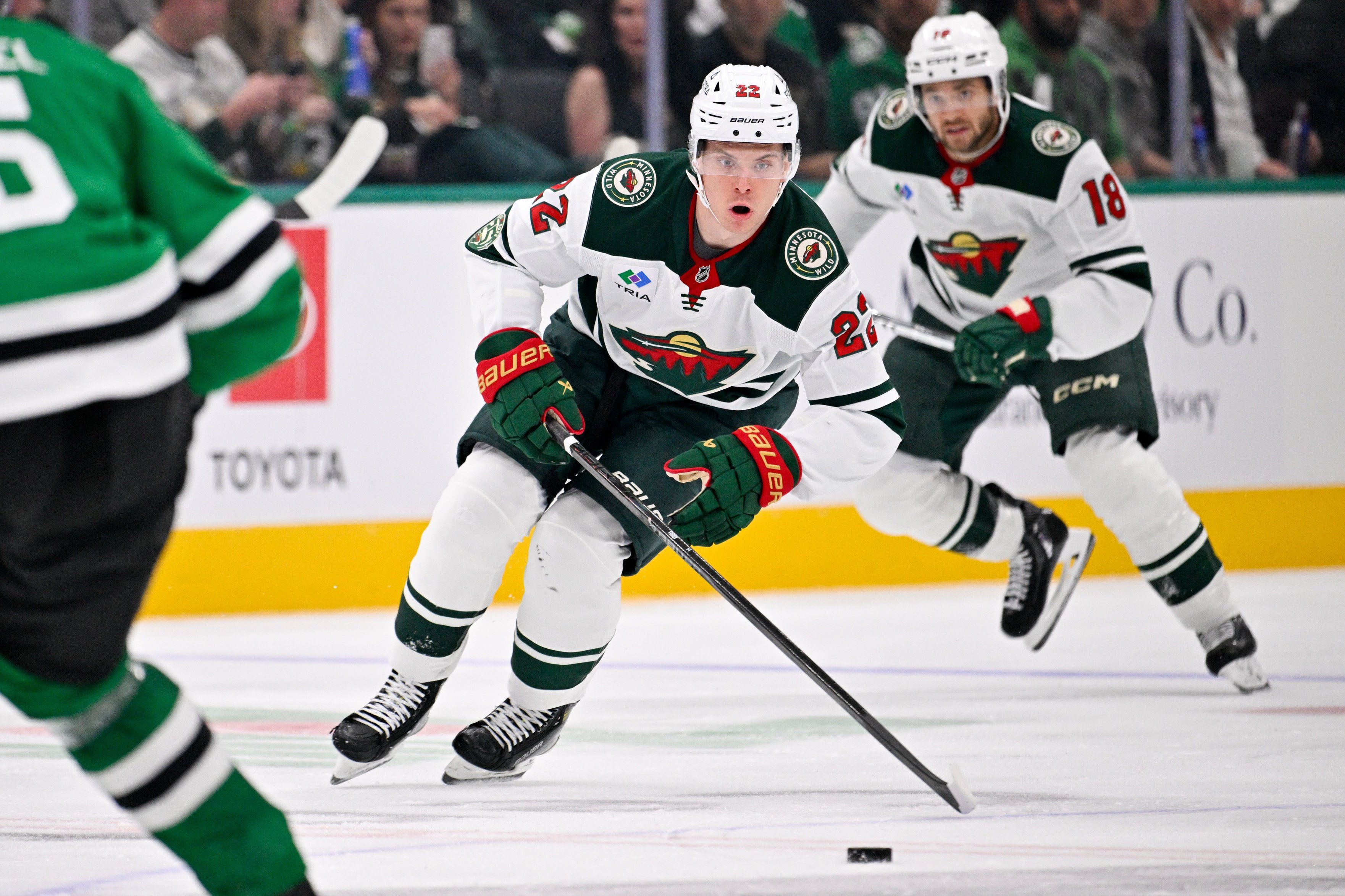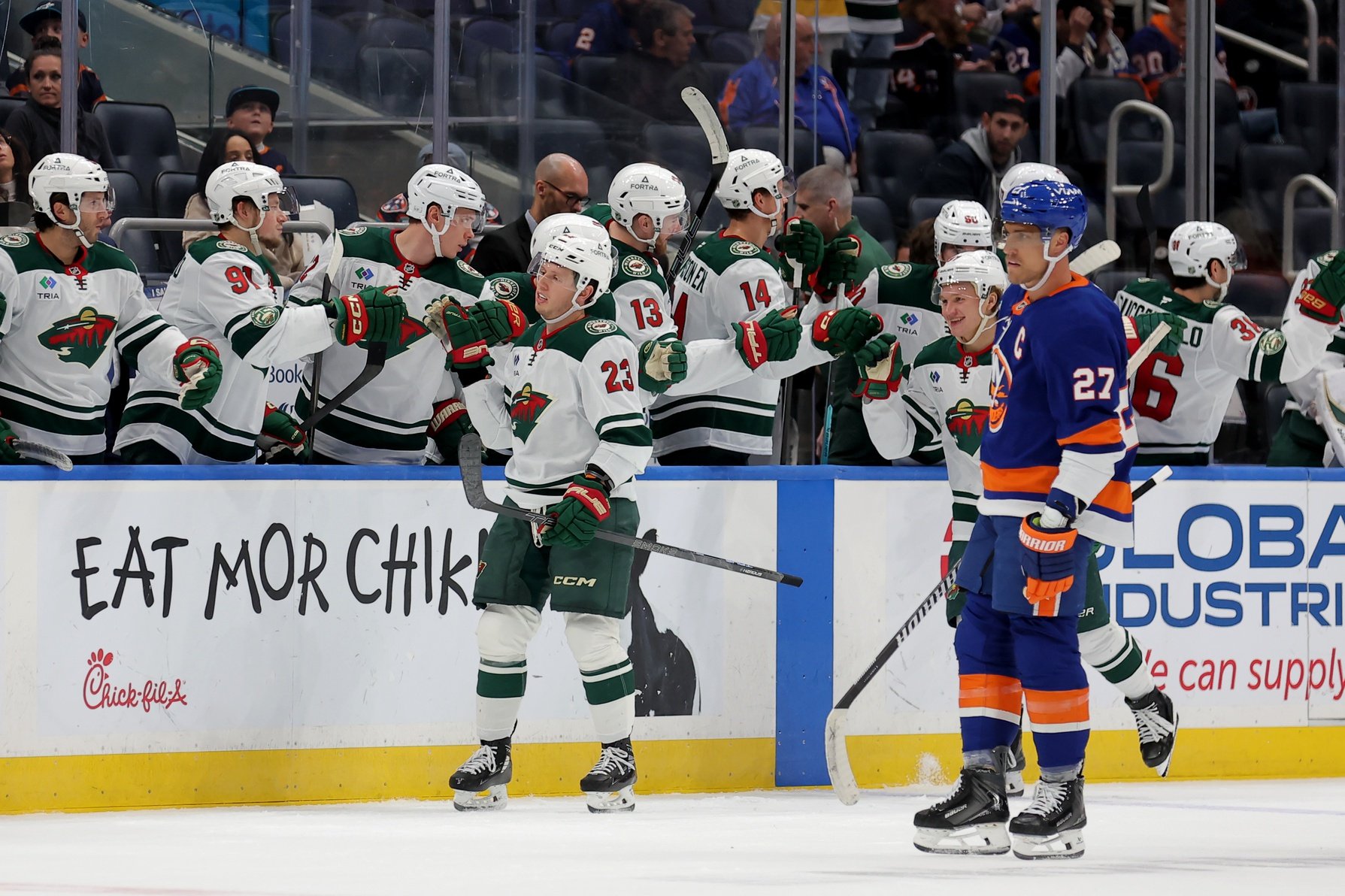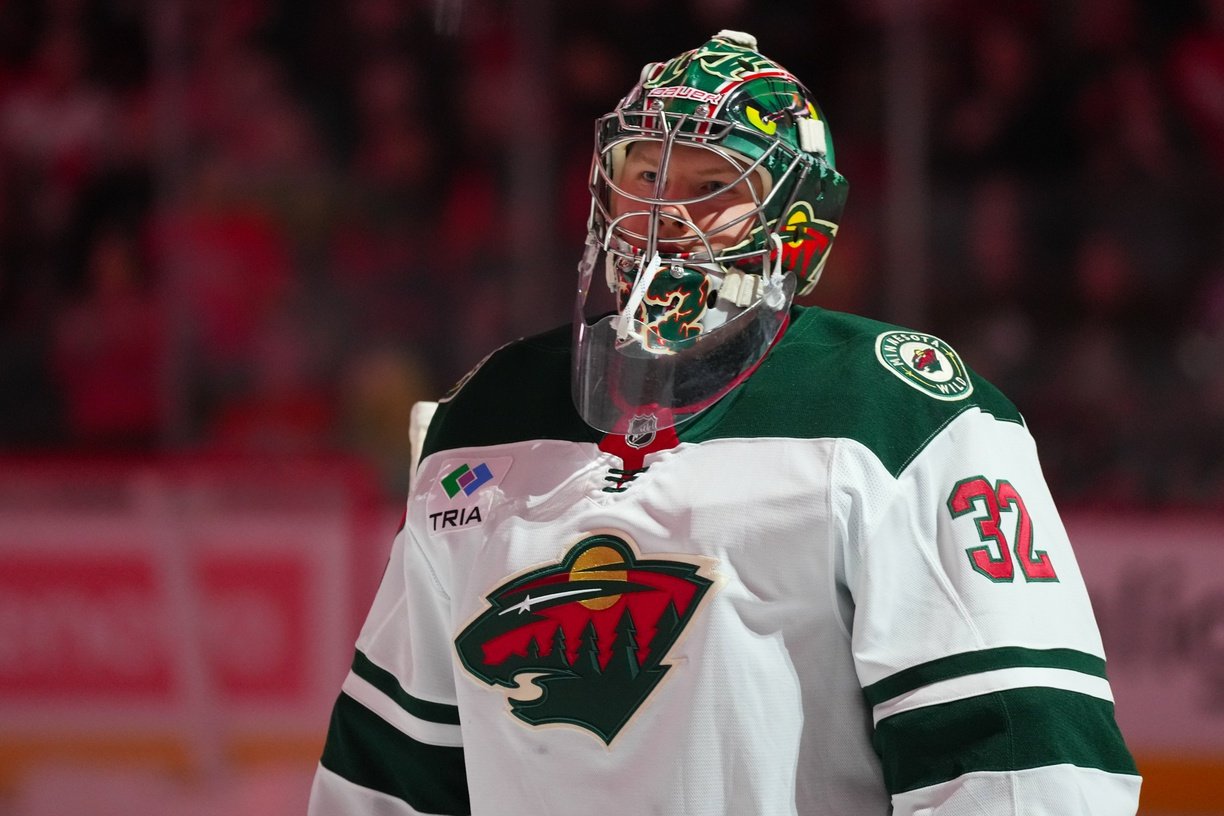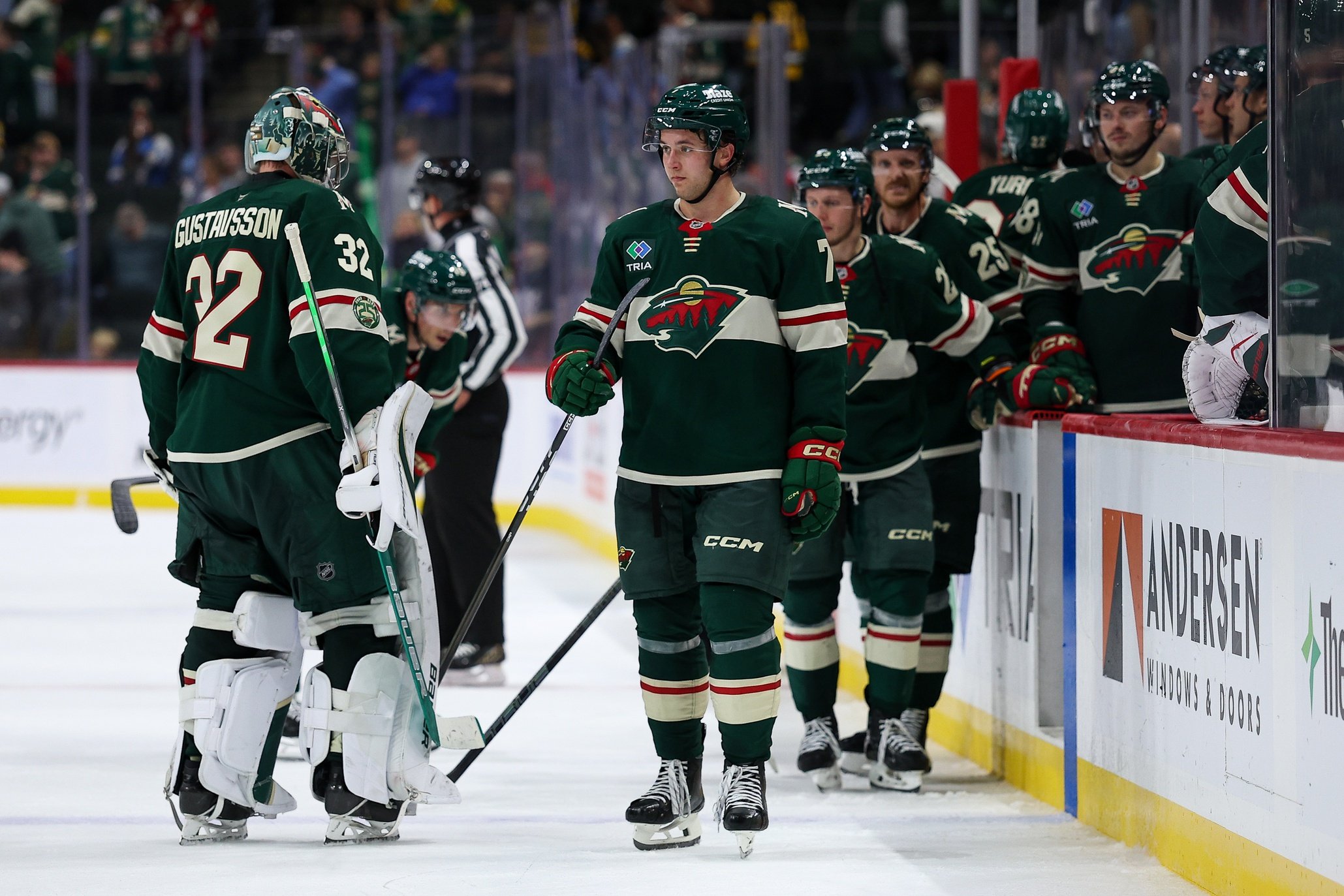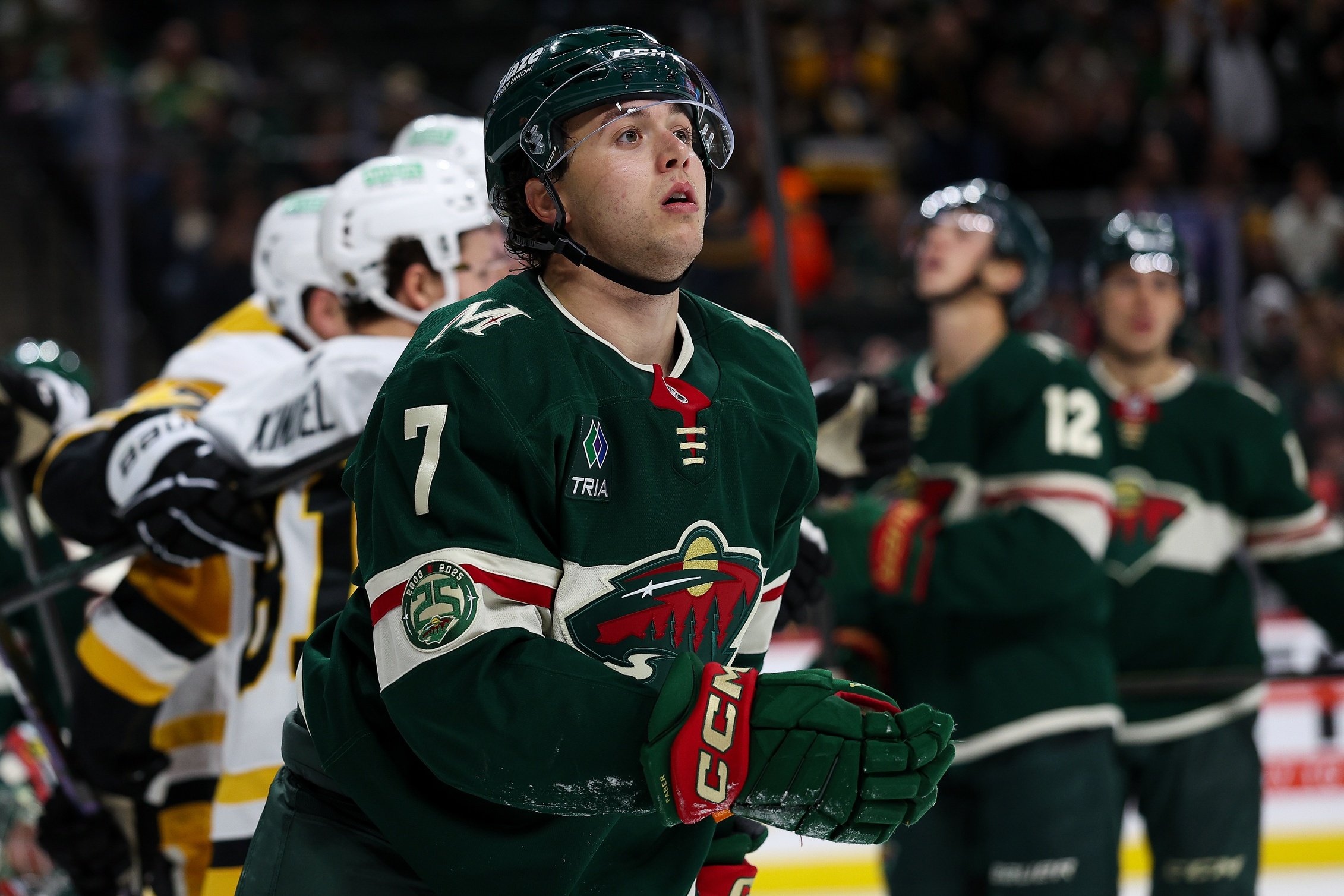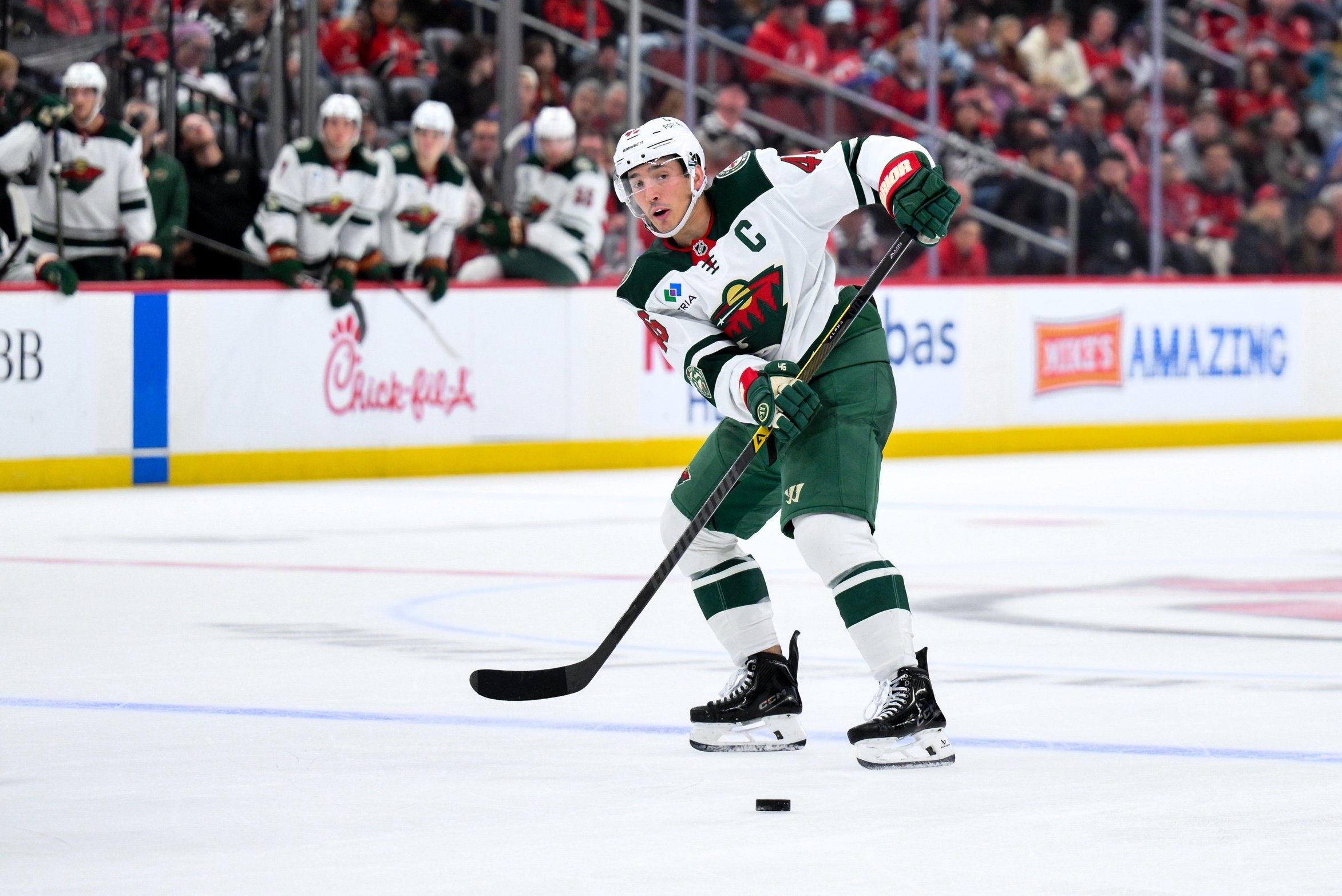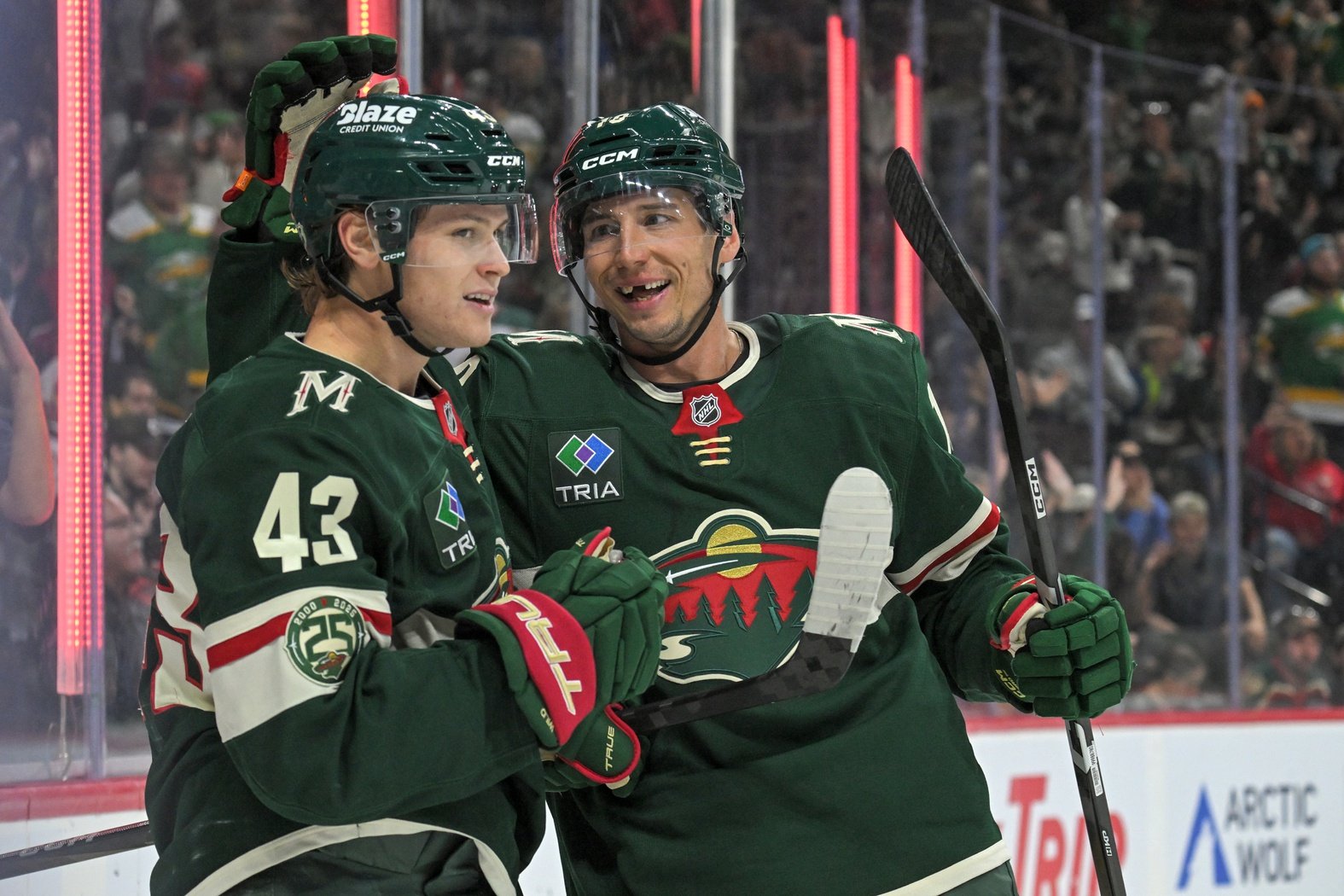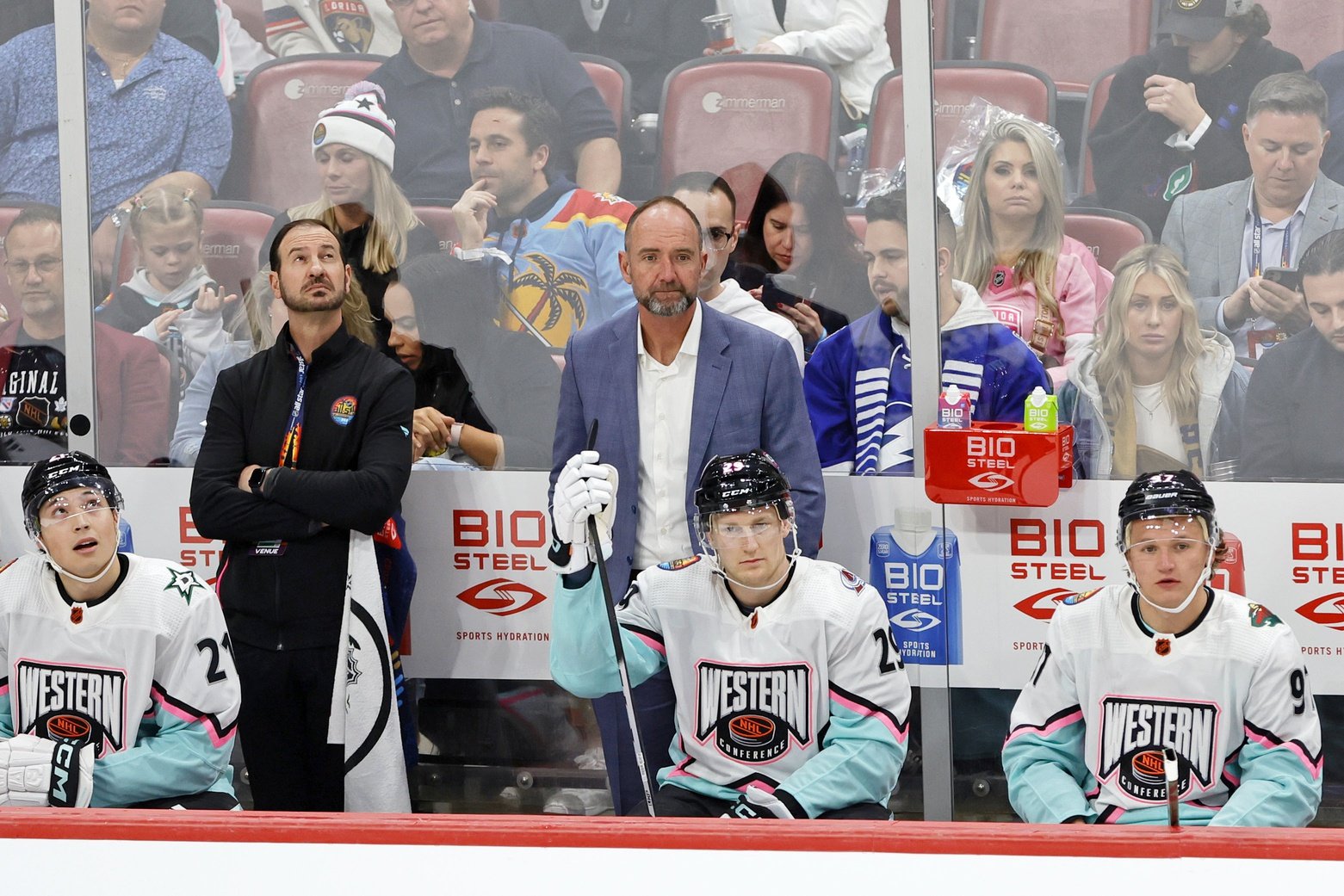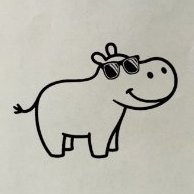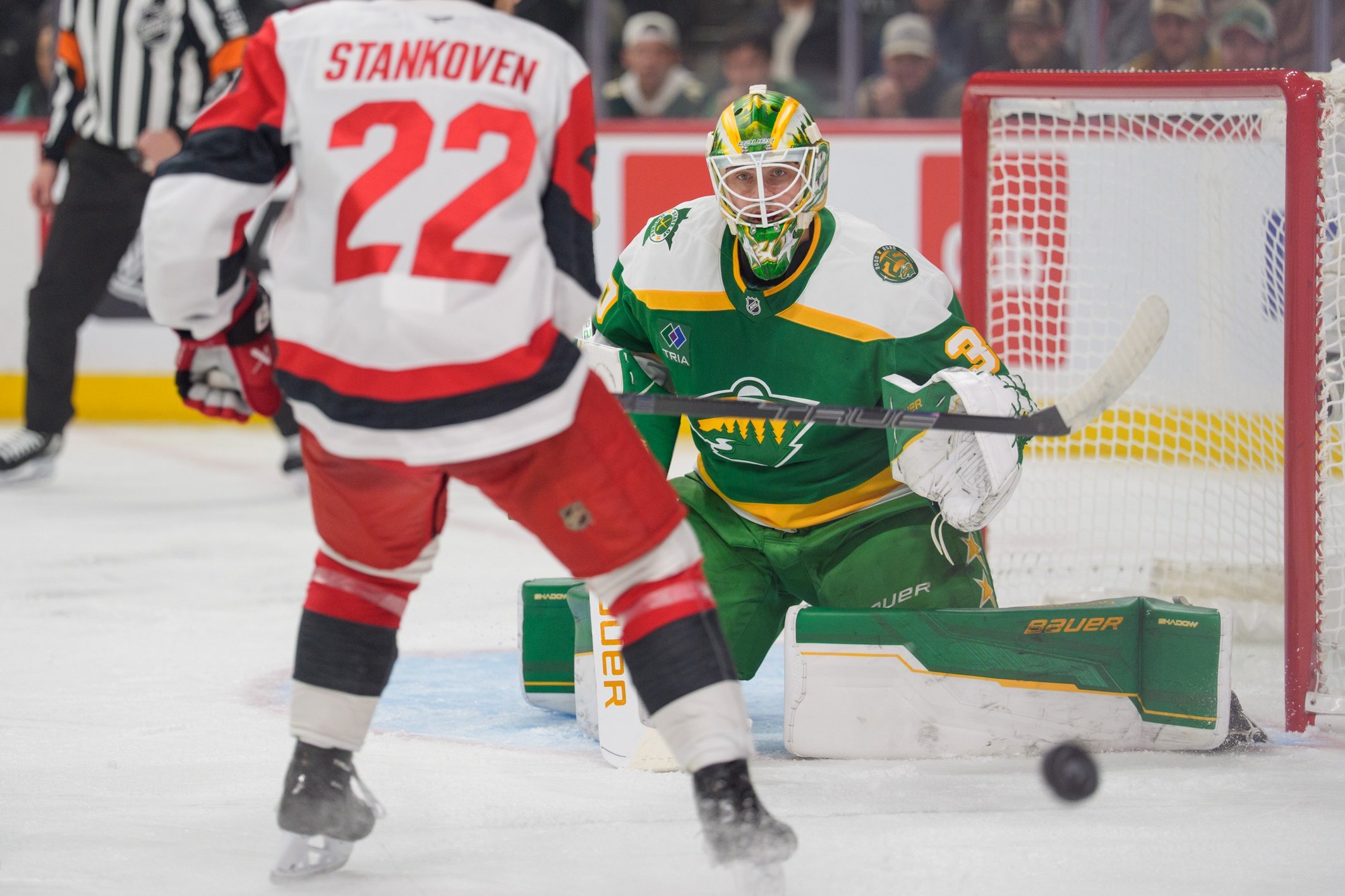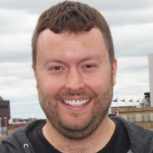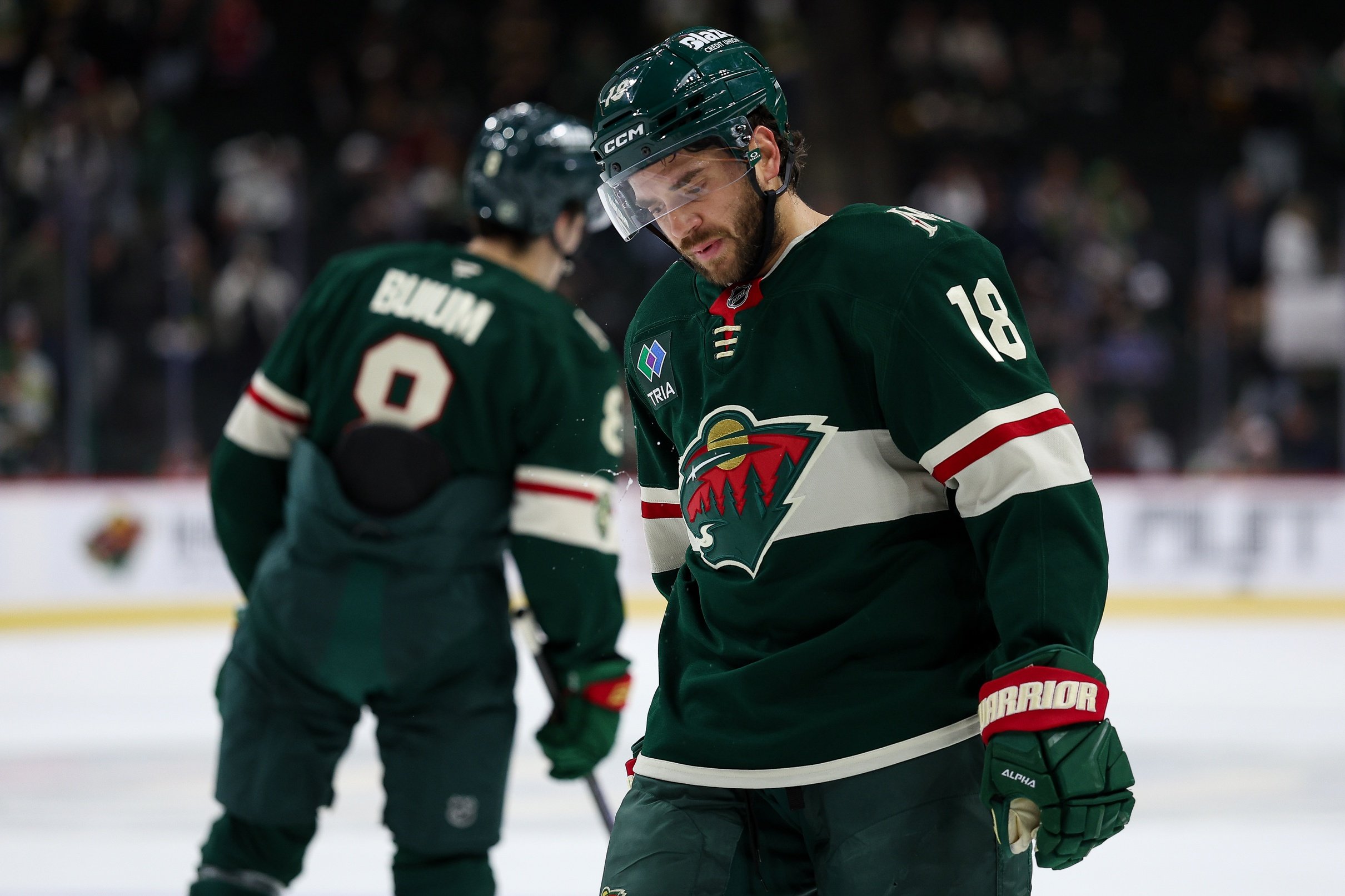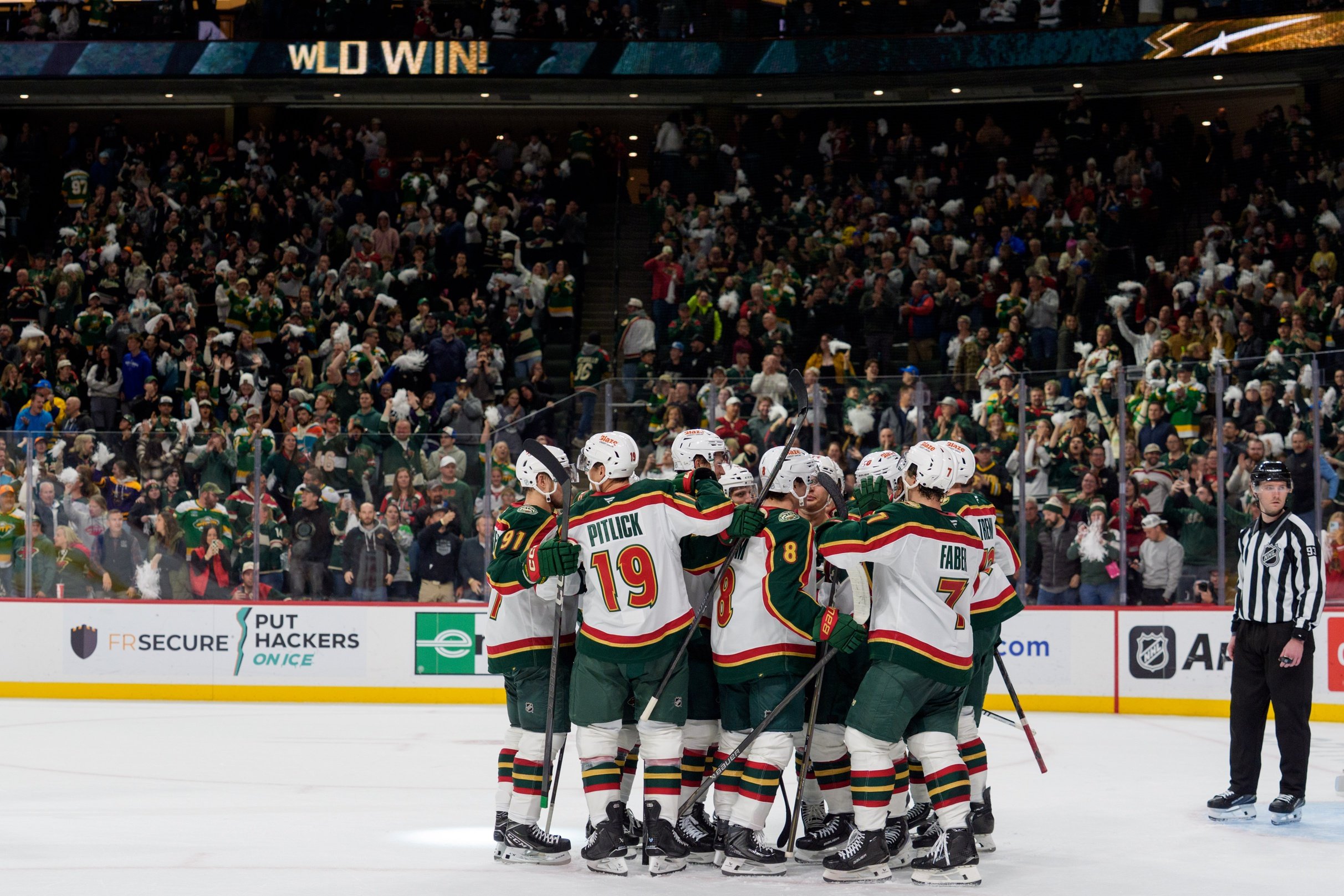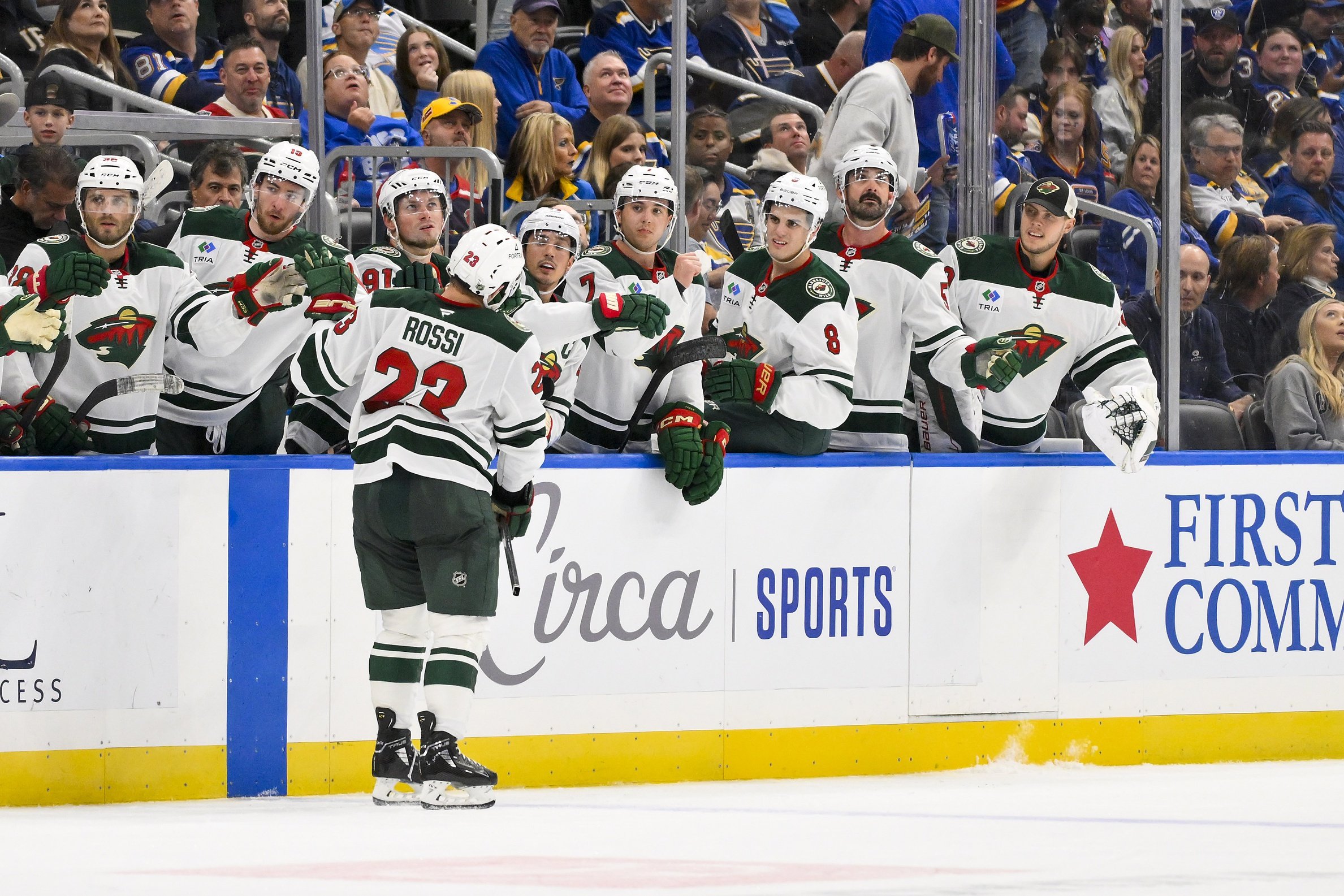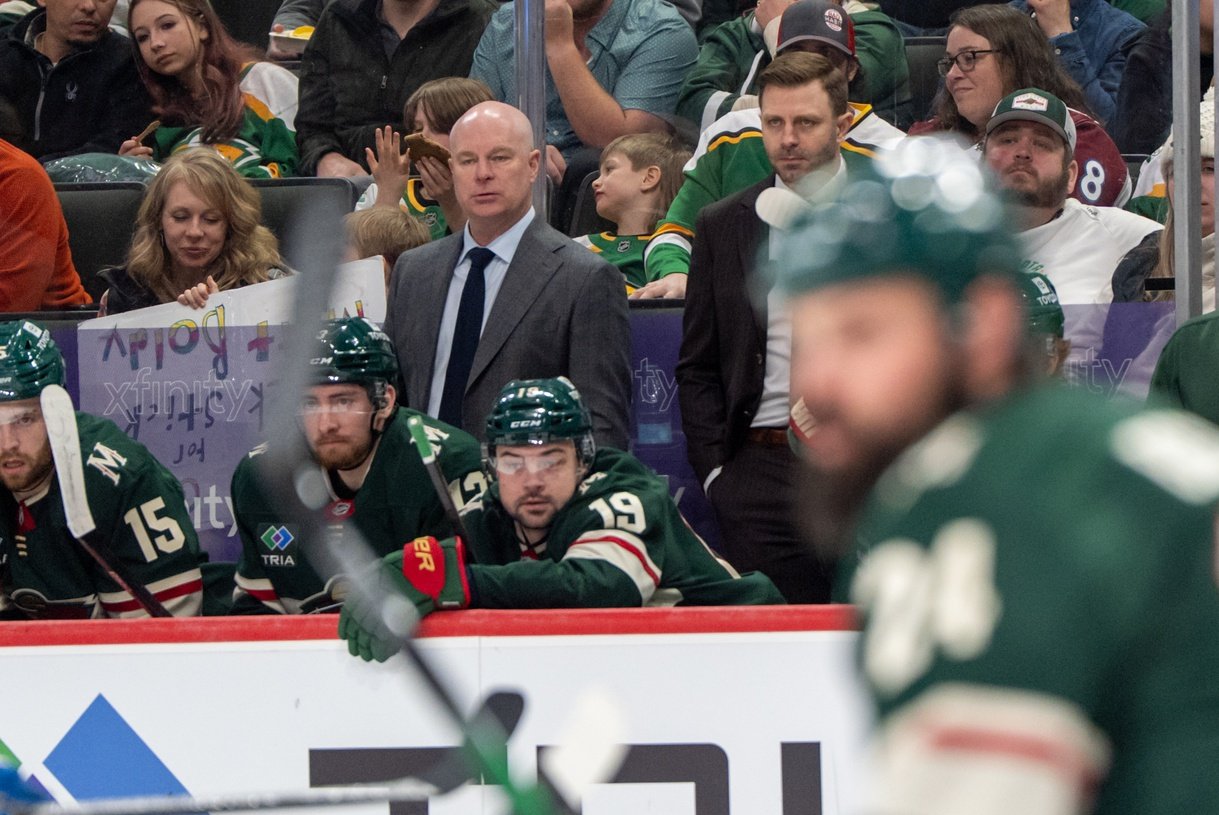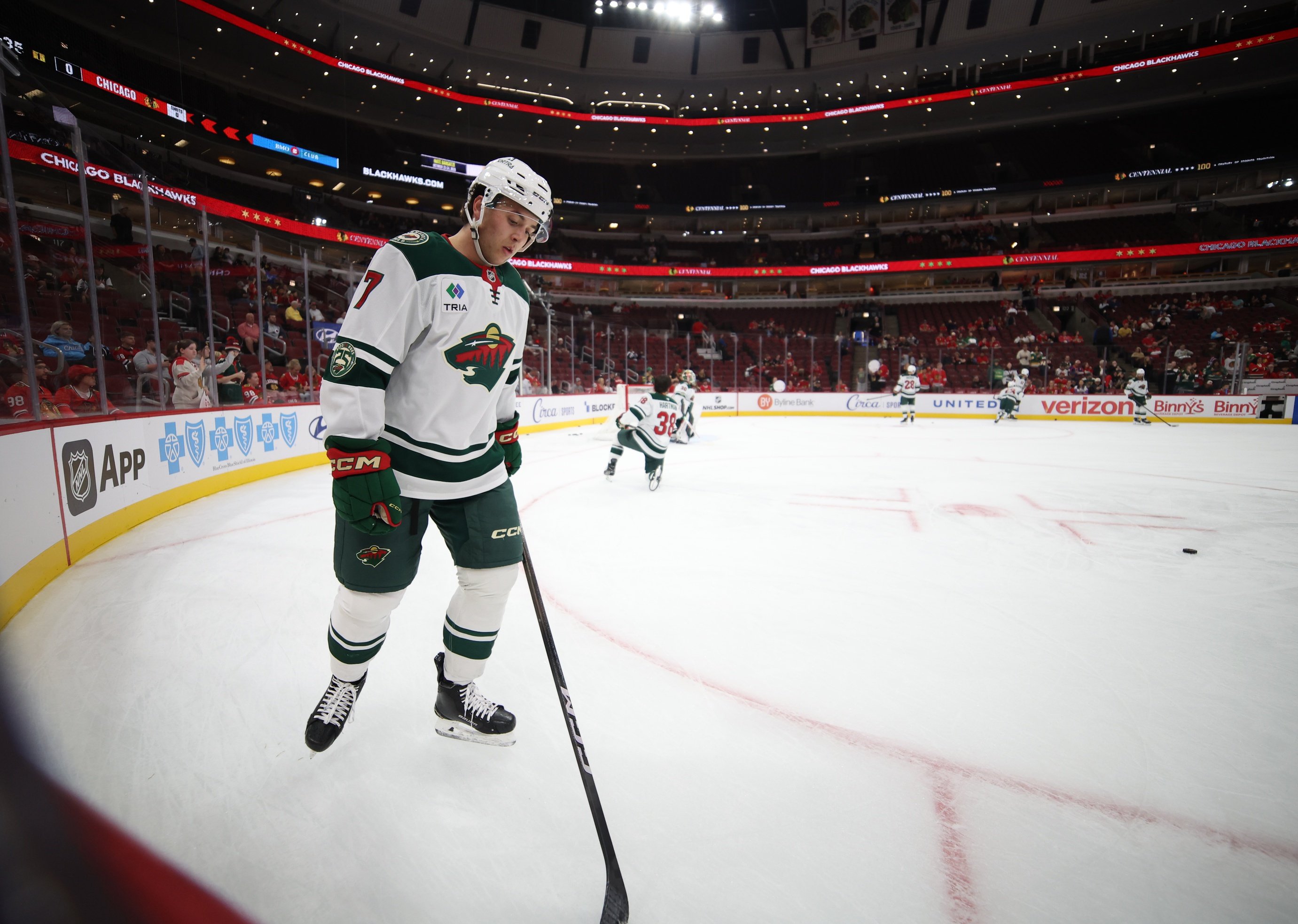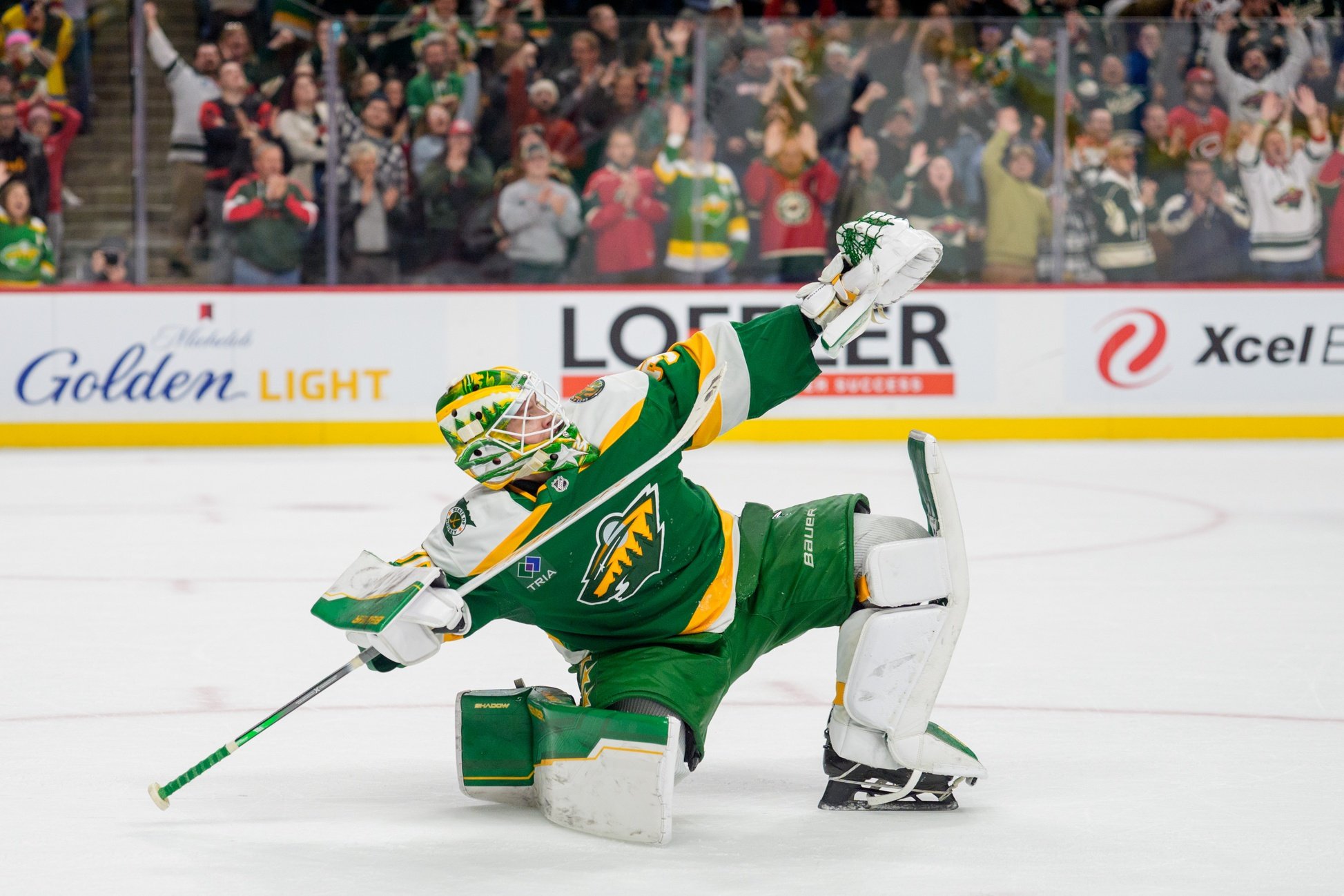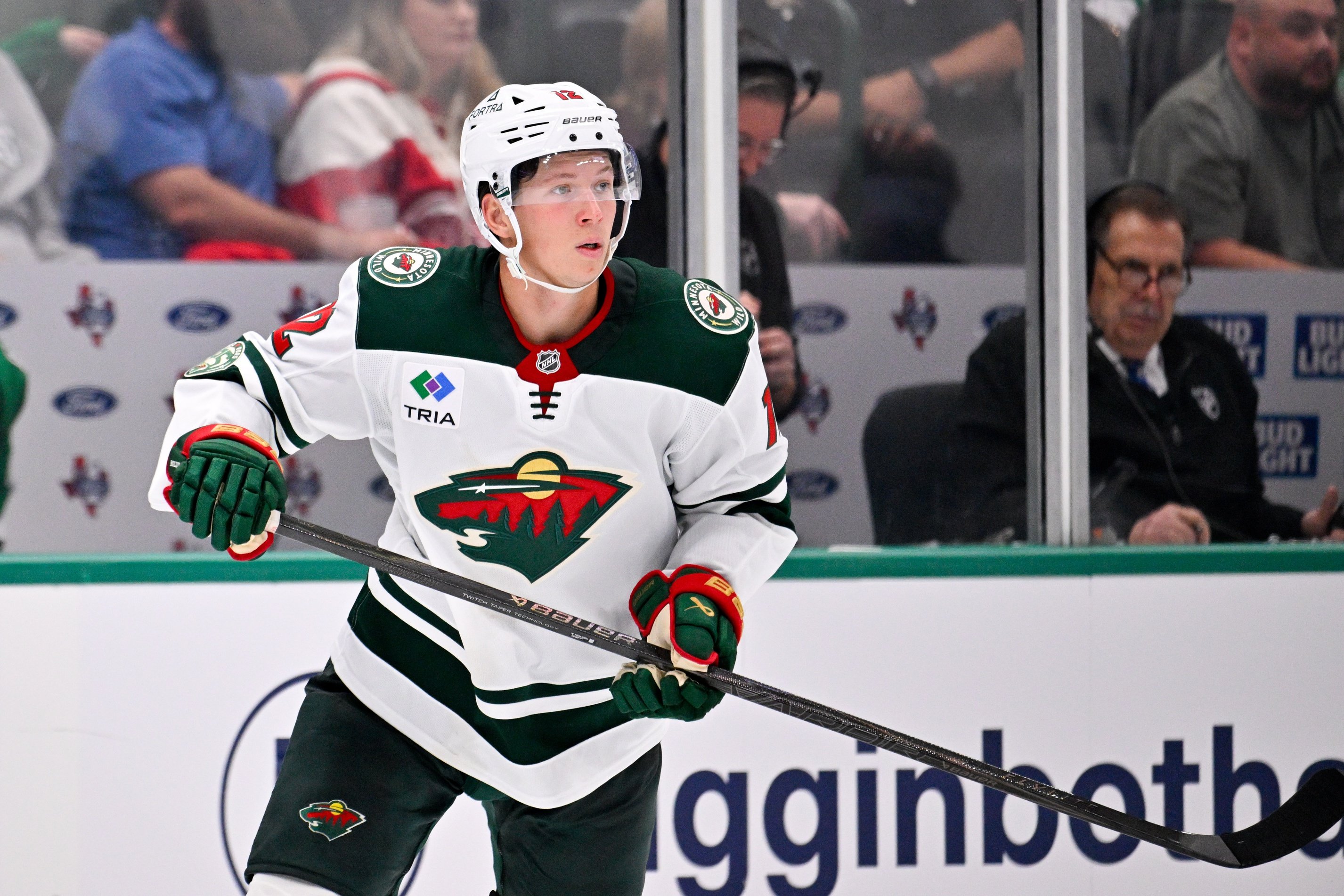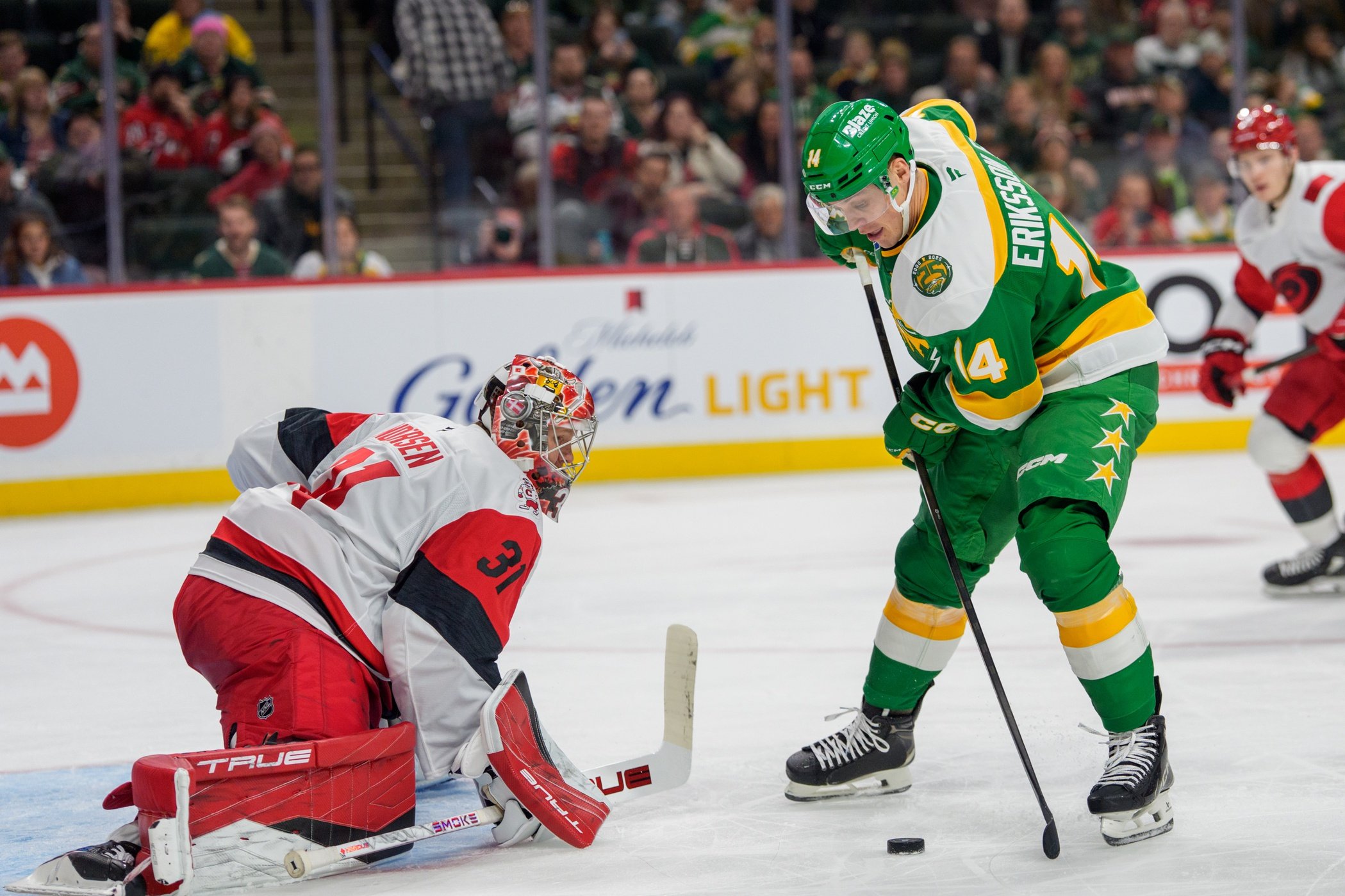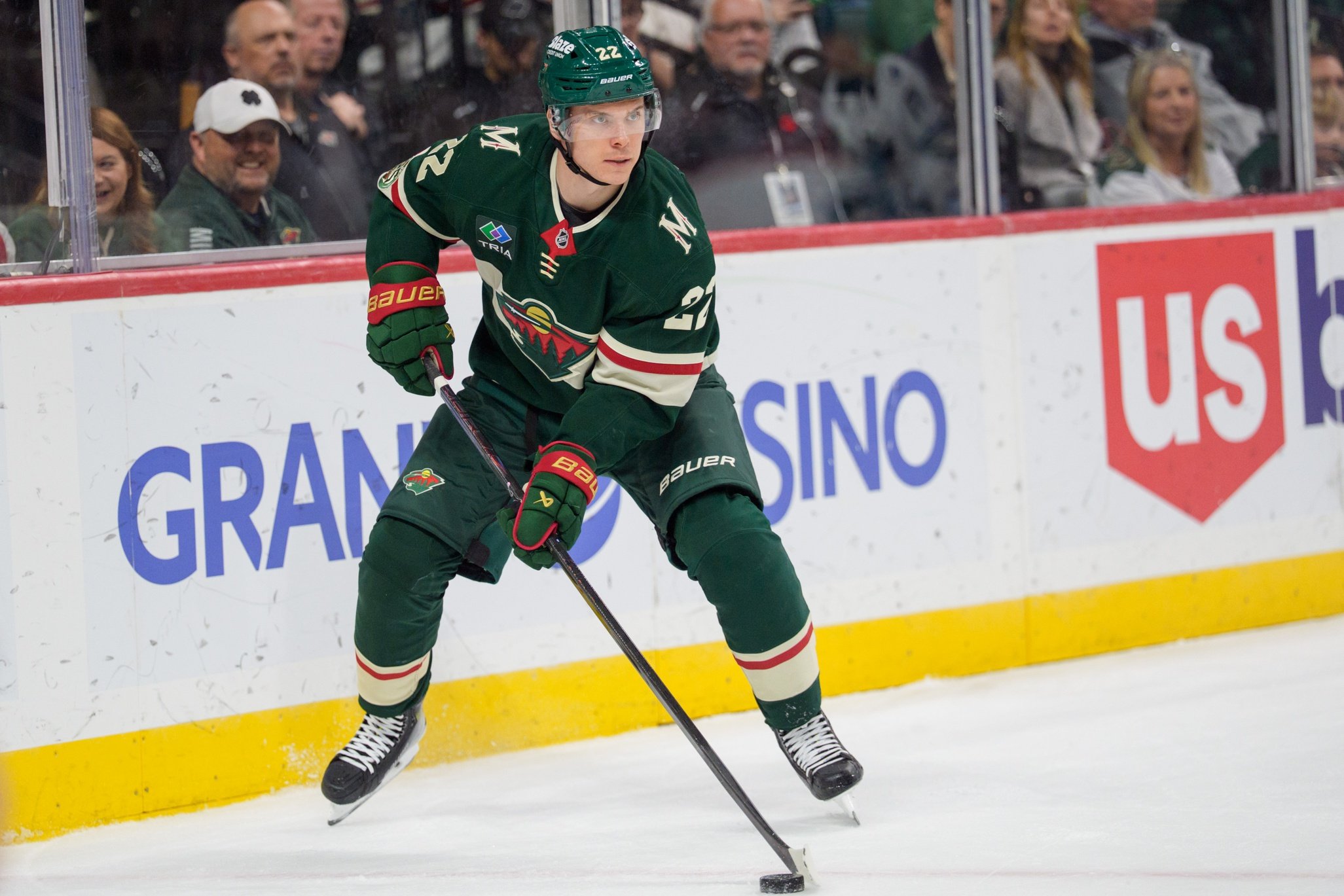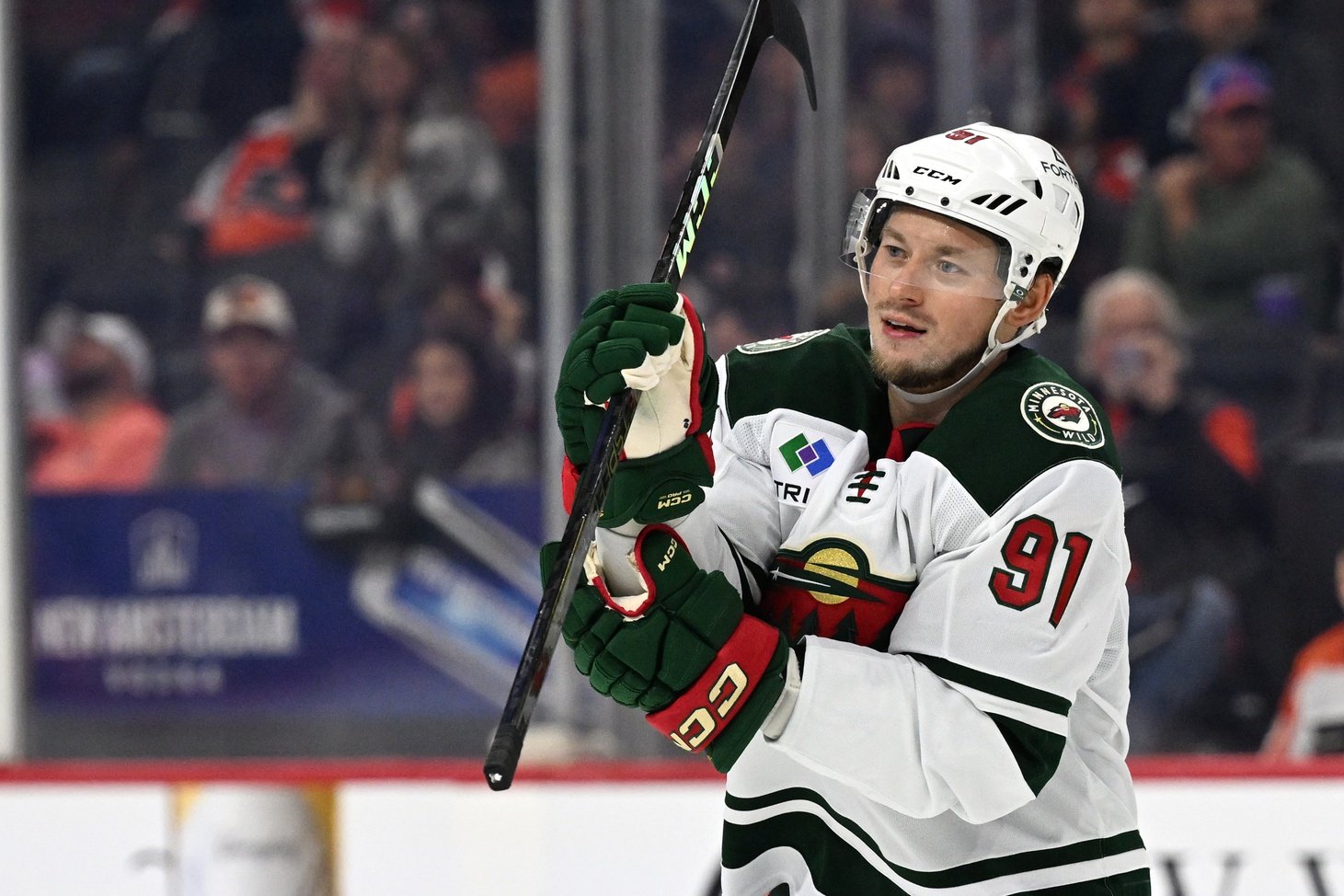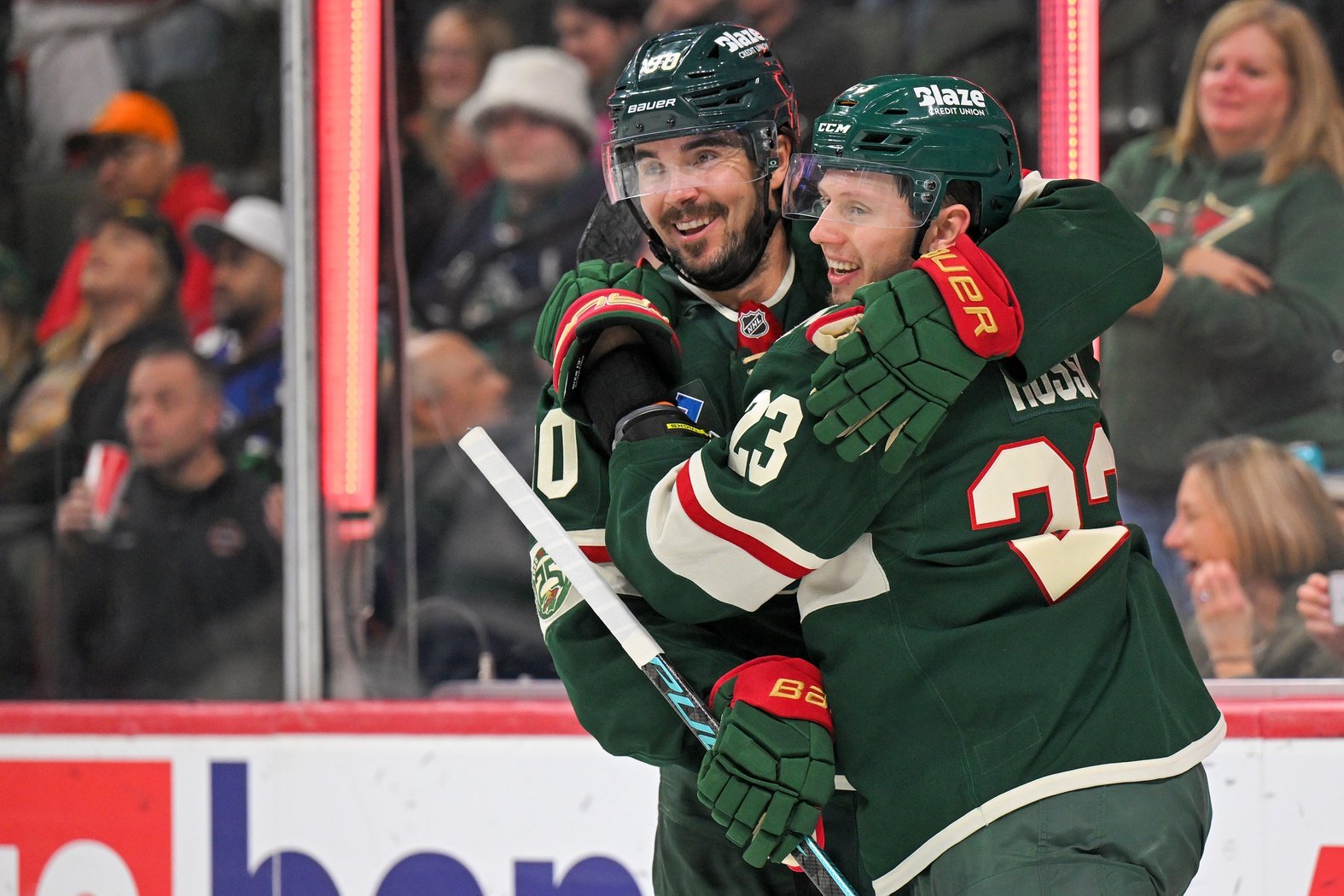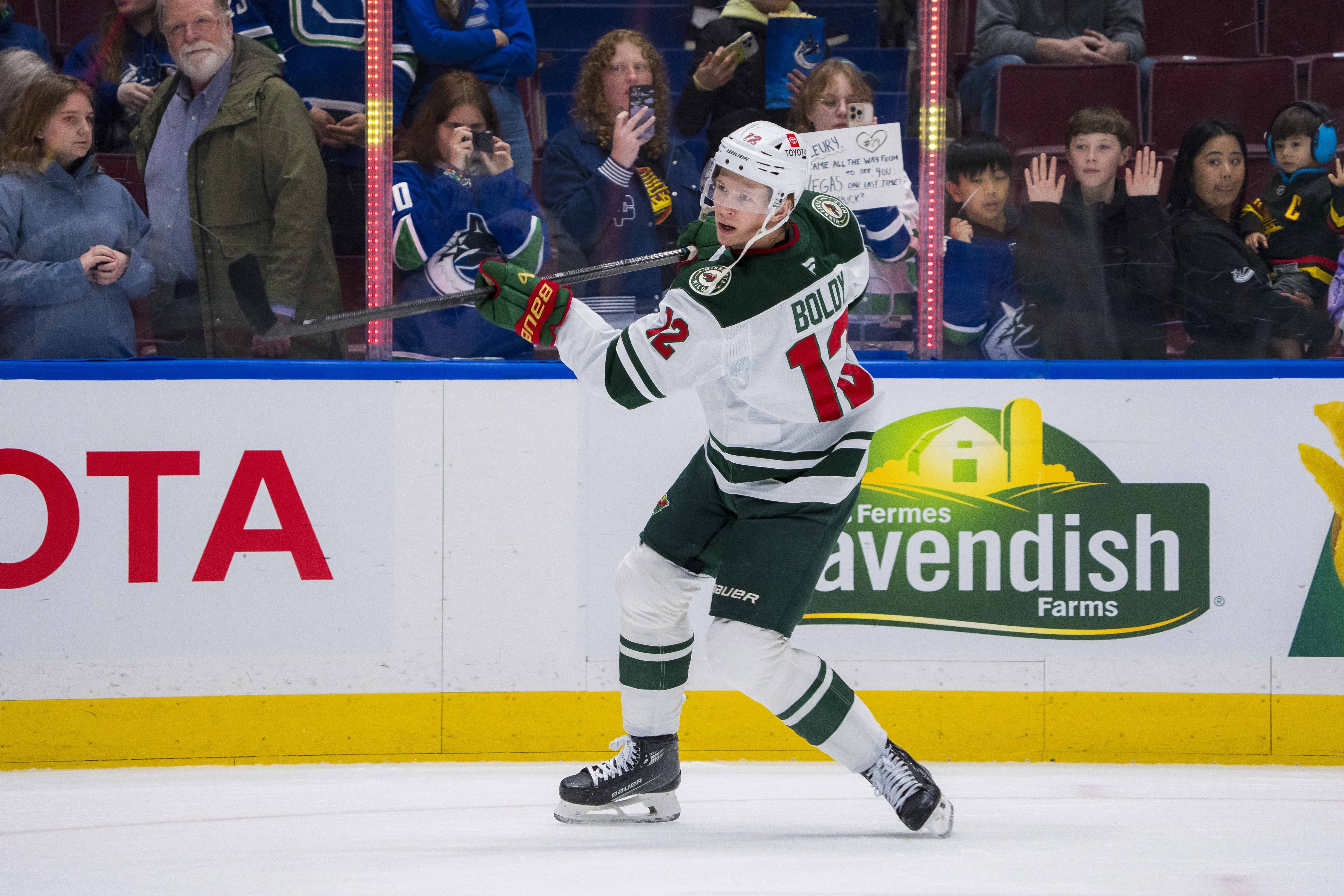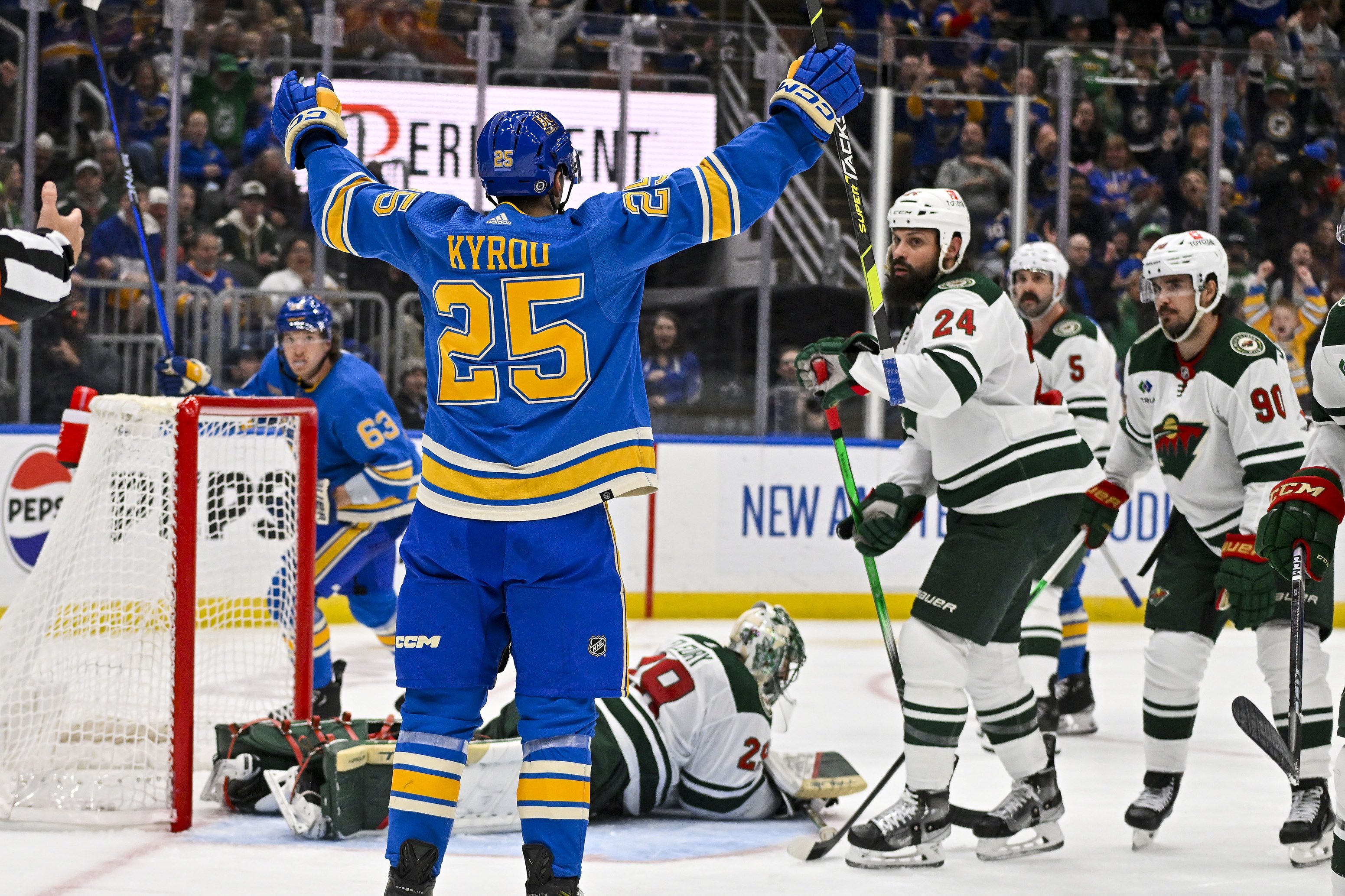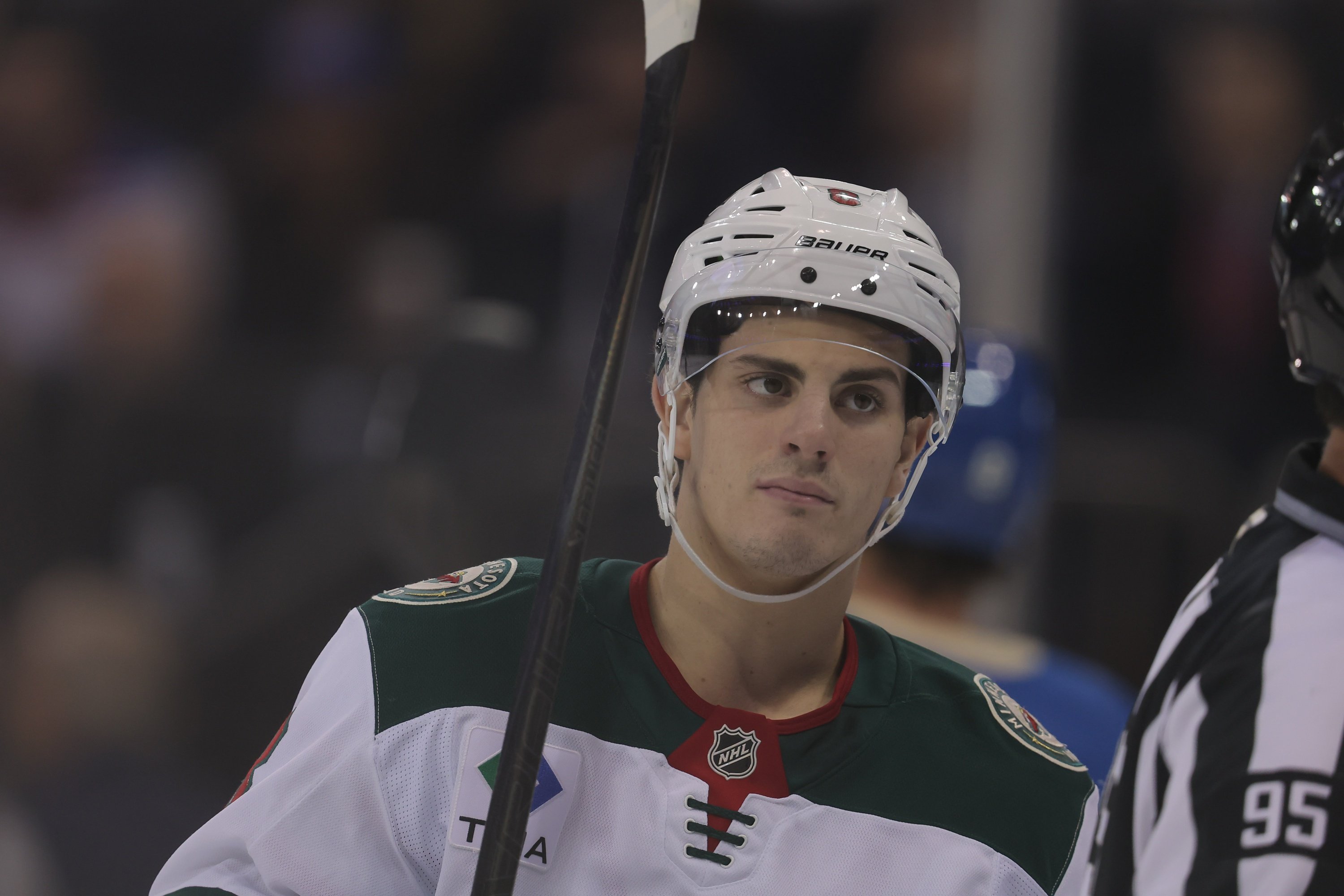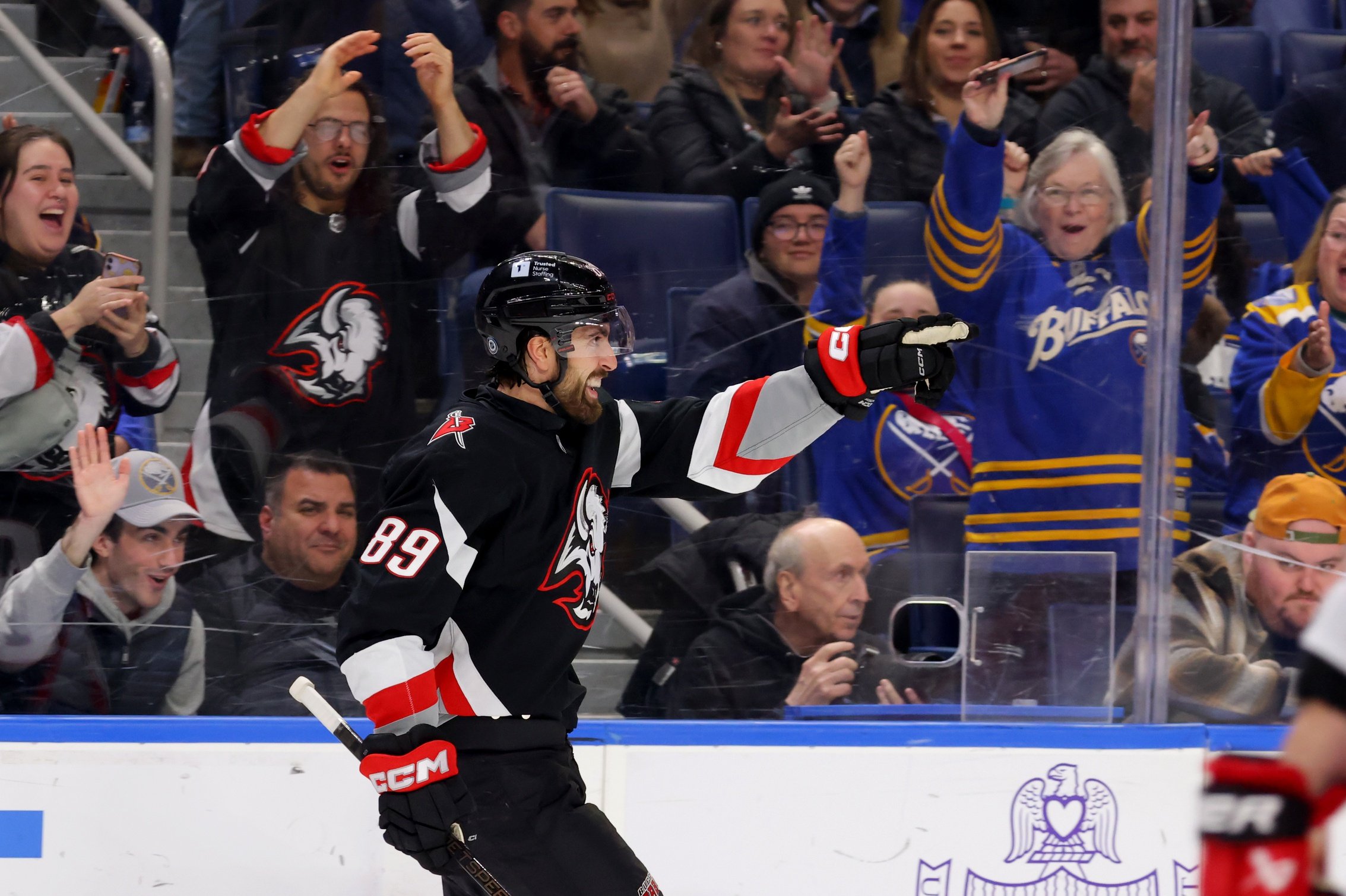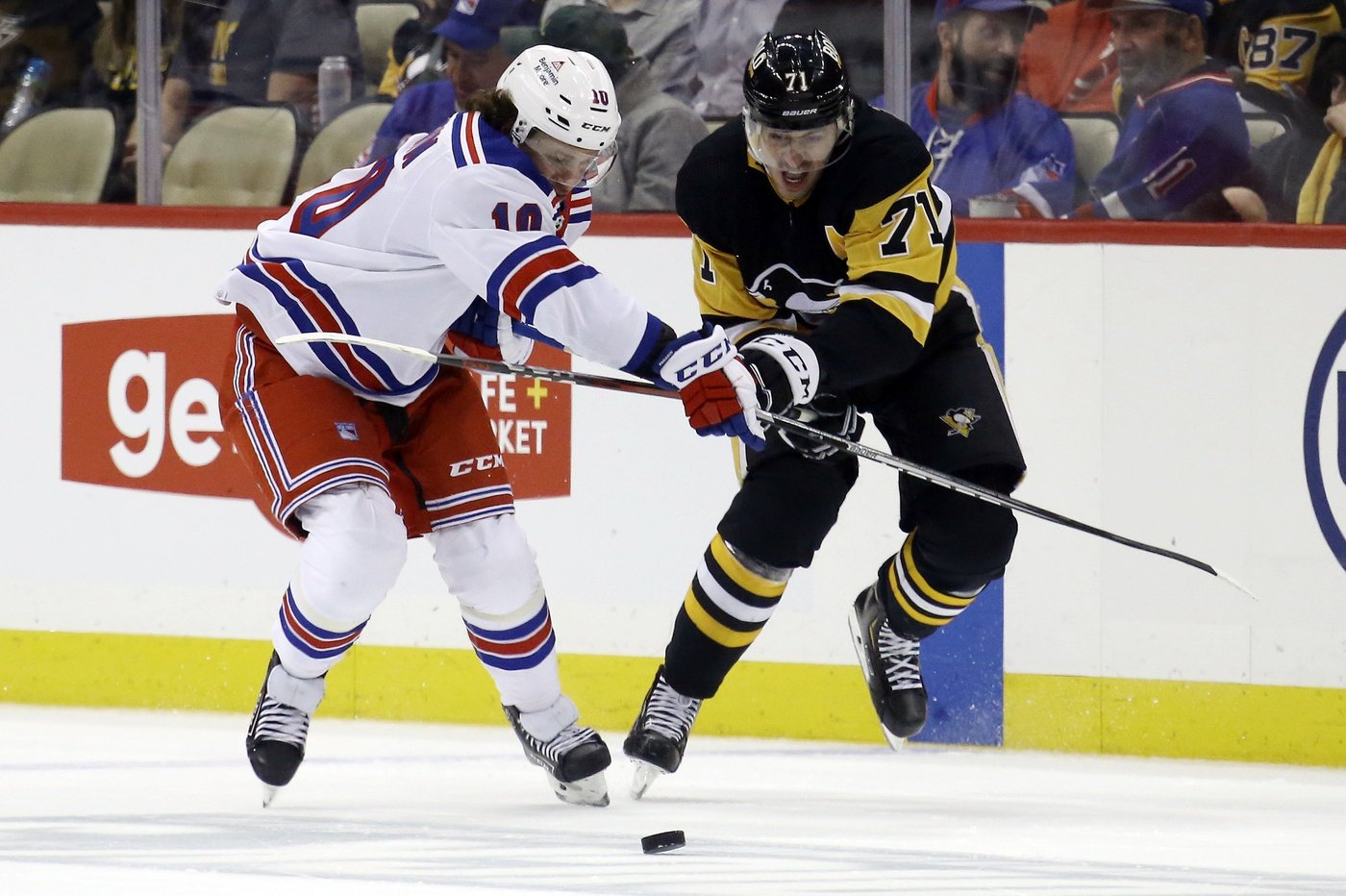Leaderboard
Popular Content
Showing content with the highest reputation since 10/25/2025 in Articles
-
Marco Rossi has been sidelined by a lower-body injury, according to a report from The Athletic’s Michael Russo. As a result, Russo and I must (separately) write about David Kampf. It would be one thing to write about Kampf joining a team other than the Minnesota Wild. Kampf is a solid role player who delivers middle-six quality forward play from the center position. His defensive impacts are effective, and he can chip in on the penalty kill when needed. His skill in the faceoff dot is also solid. He’s won between 51% and 53% of his faceoffs in each of the past six seasons, something that any beat writer (or me) will have to take a sentence or two to tell you about. I almost wasted another 15 minutes in Excel providing more context on just how many extra possessions this comes out to, until I remembered: I don’t care, and you shouldn’t either. Here is a list of things that David Kampf simply does not do: Drive offense Score goals Assist on goals Skate on the ice at the same time as his teammates have scoring chances Sure, it happens occasionally. But Kampf does none of these things above a fourth-line level. That is to say, below the 25th percentile. That has been true each of the past two years, as confirmed by Dom Luszczyszyn’s analytical model. There are many incorrect responses you could make to these numbers. Analytics are unfair to role players. They don’t know he’s shutting down the top line every night! Luszczyszyn’s model specifically quantifies the offensive and defensive impacts of opponents and teammates for the 2024-25 season. Kampf actually gets deployed against his opponent’s best defenders and worst offensive threats. The net effect was about two goals for and two goals against. I don’t believe in those made-up stats. Kampf’s faceoff percentage is something you can take to the bank. Made-up, like “goals” and “assists?” I’ll concede that “offensive impacts” are more of a black box. However, if you want to get real, offensive impact is mainly made up by shot attempts, the King of Hockey, with context given to the location of those shots. Compare that to faceoffs. While they are always credited to one team or the other as the winner, there’s no context for the quality of a faceoff win. The team that wins the faceoff can turn it over on the next puck touch. It also lacks context for where a faceoff occurs. Most teams give their most valuable faceoffs to their best centers, meaning the quality of competition has a massive impact on faceoff percentage, which raw faceoff win rate doesn't capture. Do you know who this looks like? Do you know which player on the 2024-25 Minnesota Wild looked just like David Kampf, but a little bit better? Freddy Gaudreau. We did it. We recreated Freddy Gaudreau in the aggregate. Let me be clear: I think Gaudreau is a serious NHL player. He could fit on many NHL rosters. But didn’t Minnesota seek a fourth-line center in free agency? If Nico Sturm weren’t a serious upgrade, why else send out Gaudreau? If the Wild wanted both players, they could have kept both! They traded Gaudreau for a reason, and it isn’t that the 2025 fourth-round pick they acquired for him is going to help them win a Stanley Cup. It’s that another role-playing bottom-six forward does not fit on this roster! And, Freddy Gaudreau is better than David Kampf! The only area Kampf has Gaudreau beat is that he will win between three and five more faceoffs out of every 100 faceoffs they see. None of this even begins to drive at the heart of the issue. It’s not that David Kampf should never take an NHL ice sheet again. He just brings nothing to the Wild that they don’t already have, while addressing none of the issues that have Minnesotans questioning this team’s playoff hopes. Examine this Wild lineup without Rossi: Kampf would slot in at 3C. Perhaps Yurov gets to stay on the third line, but it doesn’t really matter when you look at the wingers in that bottom-six. What if, instead, the Wild addressed that problem? Imagine if this team played with the above lineup, waited to accrue cap space, and put it into a second-line winger. Does it really look that different from blowing a quarter of their current cap space on Kampf and handcuffing their options at the trade deadline? (By the way -- when was the last time the Wild acquired a second-line winger? Drafting Matt Boldy in 2019? Trading for Kevin Fiala in 2019? Signing Ryan Hartman in 2021? Don’t you dare count trading for Marcus Johansson at the 2023 trade deadline.) Johansson slides into a third-line role next to Tarasenko and Yurov, replaced by Hartman when Rossi returns. Both versions of that line fit the mold of the line on which Tarasenko excelled in Florida. Some rotation of Foligno, Trenin, and Hinistroza keeps all three fresh and provides flexibility on the fourth line. Most importantly, though, this would address the two glaring weaknesses of the 2025-26 Wild: They don’t have a real second line, so they can’t out-score mistakes from their rookie defensemen. David Kampf could be Mikko Koivu 2.0, and it wouldn’t address that second weakness. No matter how good the other four players defend, there will be open space to the outside of Zach Bogosian. When Zeev Buium or David Jiricek’s brain falls out and he turns the puck over on the breakout, David Kampf’s faceoff win is not coming to the rescue. These things will happen many times over the next five months. It’s what happens when teams develop new defensemen. Without a serious secondary scoring threat, Minnesota will continue to give up leads and be unable to retake them. It’s time for the Wild to address the problem that has plagued this club since Kevin Fiala departed. The problem isn’t the depth forwards, and the solution isn’t another role player. David Kampf isn’t the answer for a team with Stanley Cup aspirations.8 points
-
Rookie defenseman Zeev Buium has hit the ground running in his first NHL season, displaying the skating, creativity, and playmaking skills that make him one of the best prospects in hockey. The 19-year-old phenom has nine points in his first 16 games, which is tied for third in rookie scoring and 20th among NHL defensemen. Still, there have been some expected growing pains, exacerbated by the fact that the Minnesota Wild coaching staff has had trouble finding a defensive partner who can complement the dynamic, free-wheeling Buium, who occasionally is as much a rover as he is a defenseman. Entering this past week, Buium had played at least 20 five-on-five minutes with Brock Faber (20:30), Zach Bogosian (28:13), David Jiricek (53:19), and Jared Spurgeon (89:57). Buium has experienced mixed results, partly because he must play in tandem with someone who can read off his aggressive, rover-like mentality, something that is easier said than done. However, the search may be over. Over the Wild’s past two games against the Carolina Hurricanes and the New York Islanders, the Wild activated Daemon Hunt. They’ve slotted him next to Buium on the third pair, with the left-handed Hunt playing on his offside, allowing Buium to continue to play on his natural left side. The early returns have been fantastic. Through 22:42 of five-on-five ice time, the two have produced an expected goals percentage of 54.47%, including a dominating 70.77% in just over 15 minutes of ice time against an uninspired Islanders team on Friday. Hunt and Buium appear to have found instant chemistry, and after some early struggles against Carolina that reflected the team’s performance for much of that game, the duo has really begun to pop. Hunt is a talented, intelligent player who makes good reads, decisive puck plays, is sound positionally, and doesn’t hesitate to join the rush when he sees an opportunity. He has good feet and a solid center of gravity, and almost always positions himself so he’s facing the play. While Hunt is not an overly powerful or dynamic skater, he has excellent footwork. He makes efficient turns, weight shifts, and pivots, and because he’s always facing the play, his movements are usually in the right direction for a given situation. That makes Hunt an ideal partner for Buium, because when Buium is at his best, he’s wheeling around all three zones, slicing through lanes and breaking down defenders with deceptive fakes and excellent lateral movement. Basically, he’s all over the place. Hunt seems to understand how Buium wants to play and, more importantly, reacts quickly and gets to the right places. Since Hunt is always facing the play, he reads Buium’s movements and works in tandem with him in all three zones. It’s not uncommon to see them switch back and forth between the right and left sides three or four times in a shift, and the duo has a knack for understanding when to do so. Here's an example of the type of shift these two regularly turned in on Friday. Watch how Buium (No. 8 ) and Hunt (No. 48) work in tandem to cover ice and move creatively in all three zones, and how they create and fill space. Notice also how both of them defend with footwork and positioning: That was basically a perfect shift and exemplifies what makes Buium and Hunt a compatible defensive pair. Hunt is the first to take the initiative offensively, working a give-and-go with Zuccarello and slicing down low, with Buium reading that play and filling in on the right side. Their pass doesn’t connect, but it was a perfect read by each of them. After they retrieve the puck, they interchange in their own zone, and Buium transports the puck into the offensive zone. When it was time to defend, Buium used his skating to stick with his man and keep the puck to the outside, while Hunt used his 6-foot-1, 201-pound frame and strong footwork to out-leverage his man in front. He then beats his man to the puck down low and creates a turnover. This pairing works because Hunt doesn’t just defer to Buium positionally. That’s the key to taking what Buium can do and elevating it to the next level. A defense partner that’s able to read off of him and work in tandem to create a five-man unit moving up ice and pressuring in the zone unlocks Buium’s ability to break down defenses by giving him the options that he needs to be able to attack with the puck freely. Sometimes, he allows himself to get caught on an island with the puck, and that’s when bad turnovers happen. Hunt’s play reading and movement might be able to give Buium another option and ensure he has that safe outlet, and Hunt’s ability to jump into open ice helps create the space that Buium uses to deadly effect. Here are a couple of examples of Buium and Hunt working in tandem to interchange up high, creating space and pressure in the offensive zone: Notice how Hunt reads Buium’s intentions when he decides to walk the blue line, often recognizing immediately that Buium is going to slice across laterally, and skating hard to fill in his place on the left side. That’s an example of the quick chemistry that the two have developed. Hunt also has a strong offensive-zone presence, using his play-reading and understanding of time and space to jump up in the play at opportune times. Here are a couple of examples of him taking the initiative offensively: When Buium played with other defense partners, particularly Spurgeon, it seemed there was a tendency to sit back and watch what Buium was doing, ready to cover for his mistakes. While that is occasionally understandable, it also limits his effectiveness. Hunt’s willingness to play a free-flowing game is exactly what is needed beside Buium. It also works on the defensive end: The first clip above is an example of how Hunt playing on his offside can be an advantage. Buium roams to the right, and Hunt feels natural when shifting to the left; when the Islanders come in on the attack, they’re still on the opposite sides, which allows them to rotate naturally throughout the D-zone. Hunt can use his skating to recover and kill a play. In the second clip, Hunt and Buium switch sides for the O-zone faceoff, which is common practice for defensemen with righty-lefty pairs, so that each is in a good stick position to handle a won faceoff. However, with both being left-handed, this switch was clearly to allow Buium to make a play if the Wild win the faceoff. Instead, they lose it, and the Islanders come down the ice and establish possession. As the Islanders begin their cycle, Hunt and Buium switch coverage to get back to their right and left sides, and both make positive plays with positioning and footwork to help get a zone clear. The fact that Hunt and Buium press the advantage every chance they get makes a pair that can help put the hammer down and give the Wild the upper hand in possession. The thing that separates high-level teams from the pack is their ability to hound opponents relentlessly and ensure there are no easy shifts. Suppose Hunt and Buium can consistently play at a tempo that forces opponents to match it, one that seeks the initiative at every opportunity. In that case, it will make the Wild a much tougher matchup for up-tempo opponents like the Colorado Avalanche, who won’t be able to count on having a dozen shifts against a slow, overmatched third pair, as has sometimes been the case in past iterations of Wild D-pairings. It's early, and David Jiricek and Zach Bogosian are also looking for chances to get playing time. Buium and Hunt are young players who will have some tough nights from time to time. Still, Hunt has brought a dynamic to the Wild’s back end that they didn’t have. If he and Buium can continue to display chemistry and cohesion, the Wild will become a much more well-rounded, dangerous team.8 points
-
In the age of analytics, player tracking, and data overload, sometimes the good, old-fashioned eye test gets overlooked as fans and media scrutinize players. There’s a reason for that, of course. History has proven that the eye test alone isn’t sufficient for overcoming biased perceptions or imperfect observations that can cloud analyses and lead to poor decision-making. However, there are times when you see a player, and you just know. That’s been the case with rookie Danila Yurov during his rookie season in Minnesota. Beginning with the Tom Kurvers prospect showcase, then in training camp and preseason, and on through the first 15 games of his NHL career, the 21-year-old from Chelyabinsk, Russia, has looked the part of an NHL player. His game at the Kurvers showcase was representative of a player still finding his stride. Still, even then, he clearly was a step above most of the prospects there. It was the first glimpse of the skating, puck pursuit, and remarkably mature two-way game that reflected a player who arrived in North America as a pro-ready prospect. Yurov carried that momentum into training camp, where he steadily progressed as the preseason went on, getting better with each game as he adapted to the smaller ice and faster pace. He displayed skating and hockey sense and diligent two-way play throughout camp. It was clear he was ready to be a valuable contributor and produce quality shifts regularly. Yurov’s game hasn’t been flashy, but it’s been steady. He’s in the right places. He stays above the puck, takes smart angles to win puck races, isn’t afraid to go to the net, and covers a lot of ice with his efficient skating. He just keeps getting better, little by little, and it’s been noticeable. John Hynes and the Wild coaching staff have clearly seen it too, deploying Yurov primarily at center after he began the season at wing. In the team’s most recent game, a 3-2 overtime win over the first-place Vegas Golden Knights team, Yurov played a season high 13:09, including nearly four minutes on the top line with Kirill Kaprizov and Mats Zuccarello after Ryan Hartman left with an injury. After the recent news that Hartman is week-to-week with a lower-body injury, and with Marco Rossi still on the shelf, The Athletic’s Michael Russo has reported that Yurov is going to get another shot with the Wild’s dynamic duo against the Carolina Hurricanes on Wednesday. Playing on the top line against the Hurricanes will be Yurov’s stiffest test yet. They have looked like a buzzsaw this season, overwhelming opponents with their depth, aggressive defending, and relentless forechecking. The Wild experienced this first-hand less than two weeks ago, when Carolina thoroughly outplayed them for long stretches during a 4-3 defeat. Yurov was a healthy scratch for the third consecutive game that night in Carolina. It’s not a coincidence that he's been in the lineup every night since. His skating and intelligence would have been an asset. The Wild first activated him the next night against the New York Islanders and made an immediate impact with a first-period goal. Yurov makes small but noticeable contributions almost every shift, and he’s starting to pass more than just the eye test. According to Natural Stat Trick, he has produced an expected goal percentage of 55% or higher in five of his past seven games, and the Wild have outscored their opponents 2-0 during his minutes over that time. Minnesota has also broken even with high-danger scoring chances during his minutes over that stretch. He produces these numbers with intelligent positioning, a surprisingly strong stick that can win puck battles or maintain possession under pressure, and excellent skating. On Yakov Trenin’s first goal of the season against Vegas on Sunday, Yurov made two key plays that led to the goal. The first was out-leveraging Ivan Barbeshev for a loose puck after the Wild entered the offensive zone, and the second was another won stick battle in which he beat Ben Hutton to a loose puck down low and poked it free to Trenin. He did that after he made the correct read to get to the corner and capitalize on a loose puck created by Marcus Foligno. Yurov earned his first career assist on this play, and the way he did it is indicative of how he’s been able to turn in a quietly impressive rookie campaign. Smart reads, timely positioning, and a good stick go a long way in the NHL, where victories often hinge on repeatedly winning the small moments. He’s still a young player who will have some rough nights here and there, and there’s a lot of hockey left to be played this season. Still, there’s no question that Yurov is becoming a valuable contributor to Minnesota’s lineup. Wild fans have long wondered exactly what type of player he’d be once he finally arrived, and they haven’t been disappointed. Because when it comes to this rookie, seeing is believing.7 points
-
When a hockey team is painful to watch, it’s important to find a deeper reason to keep watching. The Minnesota Wild have been struggling, with a current record of 7-7-4 as I write this. While I’m a perpetual “rose colored glasses” sort of fan, not everyone can manage that. They need a deeper reason to keep positive and support the team. Here’s one of my reasons. One week ago, the Wild lost one of their biggest and most devoted fans. He wasn’t famous or well-known, but he never missed watching a game and was more passionate about this team than anyone I’ve ever known. His name was Mason, and he was my little brother. Mason passed away unexpectedly after a sudden medical emergency last weekend. A few hours before he died, he watched an amazing 5-2 win against the New York Islanders, with that Kirill Kaprizov-Mats Zuccarello back-and-forth goal being the last Wild goal he saw. I think that he died happy, with some hope that the team could turn things around. But even if they couldn’t, he would never stop supporting the Wild. That was his ride-or-die team, come hell or high water. Mason loved the sport of hockey more than anything. He started skating shortly after learning to walk and never looked back. Hockey was a year-round sport in our household, and as his big sister, I spent countless weekends in hockey rinks around the Midwest supporting him. Hotel room after hotel room, championship games or toilet bowl games at 7 am on a Sunday, it didn’t matter. The thing was, we didn’t do all of that because we thought he would ever make it as a professional. He was undersized all the way up until he graduated from high school. He was good, not great, but it didn’t matter. As a family, we were there for the love of the game, and Mason was at the heart of it. When his playing days were over, that passion shifted into being a fan. Once he could swing it, Mason started buying season tickets. Starting with one of the 11-game packages, he worked his way up to being a full-season ticket member this year. The funny thing was, he didn’t even live in Minnesota. But Mason wanted to be able to go whenever he was back in town and to share the love of hockey with friends and family, even when he couldn’t attend. Some of my favorite hockey games I’ve ever been to were with my brother. Mason and I went to Alex Goligoski’s 1,000th game celebration, where he scored the OT winner against the Carolina Hurricanes on November 19, 2022. I previously wrote about that game and how amazing it was. I cried like a baby and, honestly, I think Mason teared up too. We were at the game against the Vancouver Canucks, which ended 10-7 on February 19, 2024. Mason, in some sort of weird premonition of the upcoming game, had purchased two baseball hats at the Hockey Lodge before the game, even though he had come to the game wearing one already. He ended up tossing two of them onto the ice that game. The Wild were scoring so fast in the third period that the announcer couldn’t even announce them fast enough. We laughed and cheered so loud that we both lost our voices. Mason also waited in the virtual line to get tickets for our entire family to go to the Winter Classic when the Wild hosted it in 2022. I know people think it’s crazy to watch an outdoor game when the wind chill is close to -50°F, but it was perfect. Mason would go to buy a beer, and by the time he got back to his seat, it would be slush. The Wild lost, but the atmosphere was so fun that I tend to forget that fact. As I work on moving forward, drenched in grief, it is hard not to have my No. 1 hockey buddy along for the ride. Our text messages were a constant stream of NHL news, hockey quips and memes, and funny social media posts about our favorite sport. My mom would call and ask me if I’d heard from Mason lately. I’d have to say that, yeah, I talk to him every day, but only about hockey. I have no idea what’s happening in his personal life. We both functioned as a sounding board for the other when it came to our favorite sport. Most people I befriend will know hockey on a surface level or a lot about one team specifically, but Mason and I were hockey-crazy. We could share about league minimum guys, AHL teams, or Men’s or World Juniors, knowing that the other person knew exactly who or what they were talking about, no extra explanation needed. And now he’s gone. He’ll never again watch the Wild on TV, attend another game in person, or buy another jersey. Mason will not get to see Kaprizov break any and all remaining team records, Zeev Buium grow into the world-class defenseman we all know he can be, or the Swedish goalie tandem dominate the league. When the Wild win the Cup (and Mason and I firmly believe it’s a when and not an if), I will have to celebrate at the parade without him. But I will also celebrate for him. Even if this season becomes a repeat of the 2023-24 disaster season, I will still watch every game. Because no matter what, Mason would have been watching too. He is my reason for staying a fan, even when it is hard and breaks my heart. So if this season is becoming hard or even unbearable for you, please remember my brother Mason and keep cheering for the Wild. Because at some point, I need them to bring the Cup home to the State of Hockey for him. And hug your fellow hockey fans tight. We’re all in this together. If you’d like to learn more about the extraordinary human being my brother was, I'd love if you read the obituary I wrote for him because we lost a good one, folks.6 points
-
Marco Rossi came into this season with something to prove for the third year in a row. In take two of his rookie season, he proved that he could stick as an NHL player. Last year, he proved that he could be a top-six player... or, so he thought. After a postseason where he was stuck on the Minnesota Wild's fourth line and an offseason where he couldn't land more than a bridge contract, Rossi now has to prove he's a player worth investing in. To do this, Rossi spent another offseason training to get bigger, stronger, and faster. He worked with Hall of Famer Joe Thornton to improve in the faceoff dot. He worked to be a player who couldn't be denied. Who can deny Rossi's start now? The 24-year-old center all but iced last night's game with a breakaway goal to push the Wild's lead to 4-1 against the New York Islanders. It was his fourth goal and 13th point of the season in 15 games. Rossi currently ranks fourth on the team in scoring and sits just outside the top-20 of NHL centers in scoring. It's a start that mirrors the beginning of last year's breakout season, where he also scored four goals and 13 points through his first 15 games. While the scoring hasn't progressed much, his game certainly has. Rossi started 2024-25 in fairly ideal circumstances: between Kirill Kaprizov and Mats Zuccarello when the former was an MVP candidate. It's a nitpick, perhaps, but the Wild clearly felt he was somewhat a product of his environment. It's a lot harder to call the start of the season a perfect storm for Rossi to produce. Kaprizov might be his primary winger, but the superstar's game has been somewhat off at 5-on-5. The Wild had to break up their productive top line and jumble their lineup to fix their scoring issues. An early lower-body injury kept him out of a game. He currently ranks eighth on the team in power play minutes. None of that has stopped Rossi from playing at a high level. The Wild's line changes coincided with the Marcus Johansson Renaissance, with Rossi factoring into six of the 10 points Johansson has scored during his eight-game point streak. His power play deployment hasn't prevented him from putting up big numbers on special teams, notching five points in 27 minutes after scoring 16 power play points in 195 minutes last year. We're also seeing him continue one of the hallmarks of his game from last year: Getting to the net at an insane rate. Natural Stat Trick credits Rossi with 20 high-danger chances at 5-on-5, which is tied with Boldy, Seth Jarvis, and Mika Zibanejad for seventh in the NHL. That's as many as Auston Matthews, Jack Hughes, and Evgeni Malkin have in all situations. Not only is Rossi producing, but we're seeing him drive the bus in the early goings of the season. With or Without You stats can be tricky, but it's worth noting that every winger that Rossi's spent 20 or more 5-on-5 minutes with has seen them perform better at controlling the play. Here's the breakdown, courtesy of Natural Stat Trick: Combine all of this, and you have a player who currently sits atop the NHL leaderboard in Standings Points Above Replacement at his position, according to Evolving-Hockey. Look at the company he's keeping over the first month of the season: Standings Points Above Replacement, Centers, 2025-26 Macklin Celebrini, 1.8 Jack Eichel, 1.7 Quinton Byfield, 1.7 Connor McDavid, 1.6 John Tavares, 1.6 Nick Suzuki, 1.6 MARCO ROSSI, 1.5 Nathan MacKinnon, 1.5 Leon Draisaitl, 1.4 Claude Giroux, 1.4 That's a stat that will undoubtedly raise some skepticism among fans, but all Rossi has done over the last three years is disprove skepticism. Rossi's been productive, driven play on both sides of the ice, improved his faceoff percentage to around the 50% mark, and now he gets to play between Kaprizov and Zuccarello again. It might seem outlandish now, but Rossi's in a prime position to launch himself into the conversation of No. 1 Centers by the end of the season.5 points
-
When Filip Gustavsson signed his five-year, $34 million extension before the season started, the Minnesota Wild's plans didn't actually change all that much. The Wild may have secured a starting-caliber goalie for the long term, but there was plenty of room for Goalie of the Future candidate Jesper Wallstedt to carve out a starting job of his own. Well, game on. "The Great Wall of St. Paul" has made an early statement. Coming off two weeks of rest after his only bad start of the season -- allowing six goals on 25 shots against the San Jose Sharks on October 26 -- Wallstedt showed that he could leave his failures behind and shut them out. Literally. He won on the road against the New York Islanders, giving his team a win on the second half of a back-to-back, then blanked the Calgary Flames for his second career shutout. As it stands, Wallstedt has a .909 save percentage, and Minnesota has points in all five of his starts (3-0-2). Meanwhile, their starter Gustavsson has a 4-7-1 record and a .896 save percentage in 12 starts. That start has to be concerning to Wild fans with a long memory. Before Gustavsson seized the No. 1 goalie role last year, he struggled out of the gate in the 2023-24 season. Through 12 starts, Gustavsson sported a 3-6-2 record paired with an .886 save percentage. The "Gus Bus" never really got back on track. He finished the year with a 20-18-4 record and a .899 save percentage. These two starts look similar on the surface, and that would create an opening for Wallstedt. But they aren't very similar. Not at all. And this is still Gustavsson's net (for now) with good reason. For one, we probably need to recalibrate what "sub-.900 save percentage" means. We're not just in Year 3 of the league-average save percentage being below .900; the line keeps going down as skaters are starting to convert on nearly 11% of their shots. After reaching its Analytics Era Peak in 2013-14, the NHL's all situations save percentage has dropped in each of the past 12 seasons. 2013-14: .9120 2014-15: .9118 2015-16: .9112 2016-17: .9110 2017-18: .9094 2018-19: .9062 2019-20: .9060 2020-21: .9042 2021-22: .9024 2022-23: .9004 2023-24: .8991 2024-25: .8941 2025-26: .8908 The Second Dead Puck Era is, well, dead. Ever since Kirill Kaprizov entered the league (I refuse to believe this is coincidence), save percentages have tumbled. Gustavsson's .899 save percentage in 2023-24 was, believe it or not, league average! Gustavsson's .896 is somehow five points above league average! A slight knock on Gustavsson during his time with the Wild is that his save percentage is boosted by the franchise's historical tendency toward structured defensive play. Gustavsson deserves credit for making the stops, of course, but Jonas Brodin, Jared Spurgeon, Joel Eriksson Ek, and Marcus Foligno have often been there to make things easier on him. If that were still true this season, Gustavsson's save percentage would be a pretty big red flag. Fortunately for Gustavsson (though, perhaps not the rest of the team), that's not the case. The Wild are 22nd in expected goals allowed per hour in all situations (3.54), and 27th at 5-on-5 (2.95). Not only that, but Gustavsson has taken the brunt of those bad defensive performances. Gustavsson's teammates have often hung him out to dry. Only Juuse Saros of the Nashville Predators has seen more shot attempts against than Gustavsson, and he's almost constantly under siege. He's faced five expected goals against twice this season, including his last start against the Carolina Hurricanes. He's also seen 3.5-plus expected goals against in more games (six) than he has below 3.0 (five). Part of this is the Wild's faltering defense, but it's also a product of matchups. Gustavsson has already faced five of the NHL's top-10 teams in expected goals per hour in all situations, and eight of the league's top-15 teams. Meanwhile, John Hynes has done a masterful job of giving Wallstedt favorable matchups to boost his confidence. The Islanders are the only team in the league's top-20 in expected goals per hour (all situations) that Wallstedt has seen, and three of his five starts have come against the six worst offensive teams. Accounting for this constant bombardment, Gustavsson has done pretty well. The Gus Bus has only truly stalled out for two games: October 11 against the Columbus Blue Jackets (6 goals on 3.53 expected) and October 28 against the Winnipeg Jets (4 goals on 2.36 expected). Those are the only times he's given up more than a full goal than expected, and he's been a positive in seven of his 12 starts. All told, he ranks 24th in the NHL with 3.67 Goals Saved Above Expected, which is notably ahead of Wallstedt (43rd, 0.60 GSAx). That's not to say there's no room for improvement. Gustavsson should keep working on his game-to-game consistency, and hey, there's nothing in the rulebook that says you can't steal a game when you're getting badly outshot. Nor is it to take away from what Wallstedt is doing, which is exactly what the team was hoping for following his lost season. Wallstedt is clearly making a push to make the Wild's net more of a timeshare. That's a good thing for Wallstedt, and it's probably a good thing for Gustavsson. As of tonight's anticipated start, Gustavsson will be on pace to start 59 games, which is a bit on the high side. But even as Wallstedt chips away at that number, and despite the ugly-looking numbers, Gustavsson is still deserving of drawing in most of his starts.4 points
-
The Minnesota Wild's Saturday night win over the Vancouver Canucks was necessary to turn down the heat. Losing eight of nine games, including the first four of a six-game homestand, was threatening to boil over. But the win just lifted the pot from the flame for two days. A loss tonight against the Nashville Predators could put Minnesota right back on the stove. If so, you'll start to hear some outcry from the fans, who won't be appreciative of a 1-3-2 or 1-2-3 homestand. We can also bet that ownership, the front office, and the coach will not enjoy that, either. In fact, we've started hearing the first rumblings of a shake-up with the Wild. From Friday's piece in The Athletic, Joe Smith and Michael Russo wrote: This is where [Bill Guerin] has to seriously look at who actually wants to be here — and who should be here. There may not be many big names available via trade, but it’s not out of the question for a hockey trade to be made where a veteran on this team is moved. That’ll send more of a jolt than picking up a middle-six or fourth-line forward. We don't know whether this was Smith and Russo speculating, or if they were hearing it from somewhere, but the two beat writers usually don't put stuff out there without some smoke behind it. And indeed, while we haven't heard of veterans being shopped, Russo reported on Tuesday's Worst Seats in the House podcast that he believes Guerin has called in on a potential trade for Toronto Maple Leafs forward Nick Robertson. If Guerin needs to move someone to shake things up, it shouldn't be too hard. Teams have dollars to spend with the rising cap, and a top-nine forward or a regular defenseman is always in demand for NHL squads. There's just one problem: Who can they move? Go to the Wild's PuckPedia page, and you're gonna see a lot of anchors and a lot of shields. Those are the players who have No-Move and/or No-Trade protections in their contracts. These aren't all bulletproof protections, and we'll break those down in a moment. Still, the Wild are incredibly restricted as to what they can or can't do to shake up their room. The two most obvious candidates, based on their early-season play, have the tightest restrictions. Jake Middleton ($4.35 million cap hit, minus-0.8 Standings Points Above Replacement) and Marcus Foligno ($4 million AAV, minus-0.9 SPAR) both have full-NMCs. That's total and complete control over where they'd go — or whether they'd go. Even if they were willing to move, Middleton's contract would be difficult to trade to another team, given its term (the first of four years) and his play. The three other full NMCs on the team make no sense to trade. Mats Zuccarello's injury makes it impossible to trade anyway, and besides, the Wild are missing his offense and leadership, and are depending on his return to right the ship. Kirill Kaprizov and Filip Gustavsson have combined for $170 million in extensions in the past five weeks. Right there, that's about a quarter of Minnesota's NHL roster that's completely immobile. So what about the No-Trade Clauses? The Wild have four of these players, and none of them has final say over where they go. That's important because years ago, Guerin showed with the Eric Staal trade that he's not afraid to be aggressive in finding a team that slips off a no-trade list. These players are: Ryan Hartman ($4M AAV; UFA 2027), 15-team No-Trade Clause Jared Spurgeon ($7.58M AAV; UFA 2027), 10-team No-Trade Clause Joel Eriksson Ek (5.25M AAV; UFA 2029), 10-team No-Trade Clause Vladimir Tarasenko ($4.75M AAV; UFA 2026), 8-team No-Trade Clause In theory, everyone on this list should have a taker, even when dealing with a pool of 17, 22, or 24 teams. Tarasenko can at least be a power-play specialist. Despite Hartman's antics, he's a useful, gritty, top-nine forward. Spurgeon is a 20-minute-a-night right-shot defenseman. Eriksson Ek as a third-line center would be an incredible luxury for a loaded Stanley Cup Contender. But to what benefit? Immediately, cross off Tarasenko as a shake-up move. A big name getting moved out might look attention-grabbing on the surface, but Tarasenko has been in Minnesota for 13 games. Is that going to rock a locker room, or would a Central Division basement dweller offloading a pending UFA be met with a shrug? The latter feels like the best guess. Both Spurgeon and Eriksson Ek have had relatively slow starts, but both feel too important to the team's fabric to move. John Hynes gave Spurgeon's players-only meeting at least some credit for Minnesota responding against Vancouver, and it sounds like the captain still has a handle on the locker room. Besides, the team doesn't seem prepared to give his 21 minutes a night to David Jiříček. As for Joel Eriksson Ek, the team is looking to get help for their do-it-all center, not deplete their center depth. Hartman makes the most sense to trade out of this group. He's got the longevity, having been there for seven years, which would make for a legitimate shake-up. But of the 17 teams he'd go to, how many of them would fear his disciplinary problems arising again? It'd have to be a few, at least. And whatever you want to say about him, he's a center with 36 shots on goal, fourth on the team. Can Minnesota spare that offense now? Now, for the players with no protections whatsoever. It'd feel short-sighted to move out established Under-25 players like Matt Boldy, Marco Rossi, or Brock Faber, even if that would constitute a jolt to the locker room. Presumably, anyone younger wouldn't have the clout in the locker room to send significant ripple effects. As for older players, both Zach Bogosian and Nico Sturm are injured and can't be traded. So now we're left with... three names. Yakov Trenin, Marcus Johansson, and Jonas Brodin. We see similar pitfalls to these three names as we do for the rest of the team. Trenin's contract ($3.5M AAV, UFA 2028) is a huge damper on his trade value. Johansson is a pending UFA who's one of the few forwards who are actually producing. Brodin has been with the organization since 2011, but is also the Wild's most valuable defenseman this year. He'd get interest on the market, for sure, but flipping him wouldn't constitute a shake-up. It'd be waving the white flag on the season. Maybe Guerin can surprise and find a way to add to the team without taking much else away. But from where the contracts stand, Minnesota is in a trade market purgatory. Their most sparable assets are either locked in to the Wild, or too unproductive/expensive to trade. Their most movable players are too integral to the team, or too young to make sense to ship out. If a shock to the system is needed to save the season, it's hard to see how the Wild can meaningfully deviate from the status quo.4 points
-
Last year, the Minnesota Wild's motto was "Choose Your Hard." We don't know what their motto is this year, but "Choose Your Harden" is as good a guess as any. That's a Pokémon joke, so let's explain that real quick. Pokémon evolve into stronger forms throughout the games, and Caterpie might be one of the first monsters you evolve in the first game. Caterpie is what it sounds like: a caterpillar. Before it can evolve into a Butterfree* (you guessed it: A butterfly), it has to pass through its cocoon stage as a Metapod. Metapod is weak, ugly, and effectively useless. It learns one move: Harden, a passive move that does no damage. This is hilariously (when you're eight in 1998, at least) portrayed in the Pokémon anime, when Ash engages in a Metapod-on-Metapod stalemate. It's a duel only slightly less frustrating than watching the Wild this past month. Minnesota entered the season hoping they were a Butterfree. With Kirill Kaprizov locked up for the next eight years and the worst of their dead cap from the Zach Parise/Ryan Suter buyouts shed, they could spread their wings and enter true playoff contention. We're 12 games in, and it's clear that's not the case. The Wild are 3-6-3 on the season and are sliding through a disastrous six-game homestand with a 0-2-2 record. As November 1 approaches, Minnesota is hardening in its position at the bottom of the Central. They're not very effective, using Struggle, and hurting itself in their confusion. According to The Athletic, Bill Guerin isn't likely to trade for some Rare Candy to inject a boost of experience for this club. It feels dire now, and Bill Guerin, John Hynes, and the players have got to be feeling some heat with the expectations they've set for themselves. But while being a Metapod feels like purgatory, it's also a necessary step of the process, both in Pokémon and in hockey. The Wild might have made the postseason for 11 of the past 13 seasons, but they're the Caterpies of the Stanley Cup Playoffs. They've won two playoff series in that time, and two is also the number of games they've won in the second round and beyond. You're not making it to the Elite Four, let alone beating them, when you're a Caterpie. It sucks being Metapod, but it's at least a bridge to something else. And the Wild at least theoretically have the raw materials they need to emerge from their chrysalis as a contender. Kaprizov, Matt Boldy, Marco Rossi, and Brock Faber are already forming a solid core to build around. Zeev Buium is a dynamic rookie defenseman with incredible offensive skills, just waiting to be harnessed. David Jiříček might be a project whose limited to sheltered minutes, but he's also full of potential. Danila Yurov is acclimating himself to the league and should have a long career as a two-way forward. Liam Öhgren should eventually get a shot to show he can harness the assertiveness he's displaying in the AHL to Grand Casino Arena. Jesper Wallstedt has occasionally stood tall in net. It's easy to focus on the kids' role in the Wild's struggles, and that's not entirely wrong. Are these players making a major, consistent impact? No. Do they all have flaws, warts, and weaknesses early in their careers? Absolutely. Have they been on the wrong end of bad plays? Indeed. But Minnesota's issues aren't just with the young core that's forming inside the cocoon. If the Wild miscalculated, it's here: Going from a Metapod to a Butterfree isn't just about growing something. It's about shedding something, too. This is a nature thing, not just a Pokémon phenomenon: The shell gets left behind. It's dead, a husk, and it would only inhibit the flight of the butterfly. But the Wild aren't just leaving their shell on; they've glued themselves to it for the foreseeable future. We can forgive the Wild for having Jared Spurgeon on the books, despite his massive struggles this year (minus-1.2 Standings Points Above Replacement, per Evolving-Hockey). He's in Year 6 of his seven-year deal he signed back in 2019. No successor was coming at the time for his spot in the lineup, because Brock Faber was a year away from even being drafted. That stuff happens. However, the long-term contracts signed for players who had successors in place are tougher to let slide. Two of the biggest culprits in the Wild's season are Jake Middleton (minus-0.9 SPAR) and Marcus Foligno (minus 0.8 SPAR). Both of those deals were questionable on the day they were signed for their lack of long-term upside. But Minnesota inked Middleton days after drafting Buium and Foligno, despite the Wild system being full of highly touted forwards. Both of them signed long-term deals with restrictive trade protections. There's no cocoon to shed. That's fine when the players are performing -- Foligno had a strong season in 2024-25, for example -- but when they aren't, they trap a team in a Metapod state. What's done is done with the contracts, and we might be weeks away from saying "What's done is done" about the Wild's 2025-26 season. At that point, the best path to evolution might be for the Wild to embrace their Metapodness. Give Buium, Jiříček, Yurov, Öhgren, and Wallstedt their reps, their experience points, and hope they can grind out enough battles to level up. Will they be able to do that, though? Guerin probably has the rope to see his five-year plan through, but Hynes probably doesn't. Good things generally don't happen to coaches of underperforming teams, and that incentivizes them to squeeze every last point out of their veterans at the expense of development. And in fairness, fans aren't going to pack the building to watch a Metapod. We're already seeing that dynamic play out. Call me when they can put a Butterfree on the ice**. There's still a little bit of time to prove otherwise, but not much before we can safely assume that the Wild are in their Metapod Era. They're fighting it right now, and they might be able to speed up the evolutionary process. But with every loss, it's becoming harder and harder to see this team doing anything but using Harden. If this keeps up, the Wild will have to accept this reality and act accordingly. *Yes, I'm aware that the better metaphor for a winning team would be a Pupitar, a similarly weak middle evolution that evolves into Tyranitar, a much stronger and more competitive Pokémon than Butterfree. I gotta keep it simple for the people who haven't engaged with Pokémon since they Pokémon Go'd To the Polls in 2016. **Yes, I'm aware that this would be bad for a Butterfree, which is two-times weak to Ice-type moves.4 points
-
In the 2003 Michael Lewis book "Moneyball: The Art of Winning An Unfair Game," the Oakland A's acquired David Justice. Justice was a two-time 40-home run player who gave the Athletics what hockey men call Rings in the Room, but that's not nearly why the A's targeted the 36-year-old for the 2002 season. Justice was washed, so it seemed. He hit just .241 (back when the league average was .261, not .245) and hit just 18 homers as a 35-year-old for the New York Yankees. But the A's didn't give a rip about his batting average, or his diminished speed, or his nose-diving power. They wanted the skills that didn't age. At the height of his powers, Justice was incredible at telling a ball from a strike. From 1990 to 1999, he clubbed 234 home runs, ranking 24th in the majors. But he was equally as good at drawing walks, getting a free pass to first base 13.9% of the time, ranking 21st among hitters with 2,000-plus plate appearances. In 2002, Justice was tied for 161st with 11 home runs... but 17th with a 14.9% walk rate. He got better at walking. Walking is an Old Man Skill, as Bill James, one of baseball's most famous statisticians and cranks, coined. It's a long walk from the baseball diamond to the hockey rink, admittedly. But hockey has its own set of Old Man Skills. A player's reflexes decline, as do their speed and shot. If you want to hang on to an NHL career in your 30s, you need to know where to be. Positioning is the ultimate Old Man Skill. If you know where to stand and how to slip into those areas unnoticed, you can score goals indefinitely. That's how Jaromir Jagr was a deserving All-Star (27 goals, 66 points in 79 games) at age 43. The same concept applies defensively. Love him or hate him, there's a reason 40-year-old Ryan Suter played nearly 20 minutes a night for a playoff team last year. Even as we approach his 36th birthday, Jared Spurgeon looks young enough to slip into a team's development camp undetected. Don't let that fool you, though: The dude was born with Old Man Skills. From Day 1, Spurgeon knew where to be on the ice at all times. He picked his spots brilliantly on offense, being opportunistic while rarely getting burned. Knowing where to be made maximum use of his 5-foot-9 frame in the defensive zone. His decision-making with the puck was nearly flawless. Those Old Man Skills made Spurgeon the Minnesota Wild's best defenseman as recently as last year. Evolving-Hockey's Standings Points Above Replacement metric rated his play as being worth 2.8 points to Minnesota, 40th among defensemen league-wide. Both Spurgeon's offense and defense remained strengths, and it seemed like that could last indefinitely. However, we're about 15% of the way through the 2025-26 season, and it looks like "indefinitely" might have already ended. As we flip the calendar to November, it's getting harder to say "it's early." Sure, it's still early. There are 70 games left in the Wild's season. But trends are starting to crystallize, and that is not looking good for Spurgeon. As of Halloween, Spurgeon is the owner of the fourth-worst SPAR in the NHL, costing his team 1.4 points in the standings. That isn't Minnesota's only problem -- spotting them 1.4 points in the standings would take them from seventh in the Central Division all the way to... sixth -- but it's a massive problem for a team that needs their captain to be a stabilizing force. The Wild may have given Kirill Kaprizov more money than anyone else in NHL history, but they're still, arguably, built around their blueline. Jonas Brodin is maybe the best shutdown defender of his generation, Spurgeon isn't too far behind, and Brock Faber has flashed those skills through his young career. Together, they set a high defensive floor for the team, and limiting scoring chances has been the secret sauce that's sent Minnesota to the playoffs year after year. So what happens when the Wild's biggest floor-setter drops through a hole? We're seeing it now, with a 3-6-3 record through 12 games. What's going on here? The first thing to worry about for an aging player is mobility. Again, Spurgeon's game was never built on breakneck speed, but part of positioning is physically getting to the correct spots. Spurgeon has dealt with lower-body injuries over the past few years, missing most of the 2023-24 season due to back and hip surgeries, and sustaining lower-body injuries last season. Did all these just catch up to him? Surprisingly, no. Spurgeon's top speed is 21.12 miles per hour this season, which is only 1 mph slower than before the injuries happened. Besides, top speed matters less than being able to access the speed a player has when they need it. Spurgeon's 8 bursts of 20-plus mph skating have him in the 74th percentile among NHL defensemen, and his 57 bursts of 18-to-20 mph are 88th in the league. He can still summon those wheels. What's surprising, perhaps, is that it's the Old Man Skills that are failing him, at least on the offensive side of the puck. Spurgeon has long been one of the Wild's top offense-generators on the blueline at 5-on-5, and often, the top puck-moving option. Not this year. Expected Goals For per hour, 5-on-5, Wild defensemen, 2025-26: David Jiříček, 3.07 Jonas Brodin, 2.69 Zach Bogosian, 2.63 Brock Faber, 2.53 Jake Middleton, 2.52 JARED SPURGEON, 2.50 Zeev Buium, 2.21 If you don't like expected goals, substitute that with any other metric you'd like. Looking at shots or shot attempts, Spurgeon stays second-to-last on the team in generating offense. It's worth noting his on-ice shooting percentage is just 2.7%, which is phenomenally unlucky, but he's not giving his team very many chances to turn things around, either. Seeing Buium at the very bottom of the xG heap is interesting, and it's tempting to assign Spurgeon's drop in play-driving to being paired with Buium for much of the year. That's not totally untrue. Buium and Spurgeon played poorly together at 5-on-5 (36.8 xGF%), and a rookie like Buium is a much less reliable defensive partner than the likes of Suter, Brodin, or Middleton. It's not that easy to explain, though. John Hynes has given up on the Buium-Spurgeon experiment and paired the latter with Middleton to get both defensemen going. They're doing better on the offensive side (generating 2.91 xG per hour). However, they've gotten worse defensively, conceding 3.16 xG per hour. What used to be a shutdown pairing is anything but this season. Hynes has also tried putting him on the top power play unit to get him (and the unit) going, but that's been a bust. The Wild are 4-for-16 on the power play during their homestand... but just one of those goals has come with Spurgeon on the ice. Evolving-Hockey rates Spurgeon's power play impact as the worst among NHL players, while Zeev Buium, who has the league's second-highest power play GAR, is sitting behind Spurgeon and Faber. The Wild went 0-for-4 on the man advantage last night, by the way. They had two chances to extend their first-period lead to 2-0, then missed an opportunity to re-take the lead in the second period. This might not be the end for Spurgeon. Remember, he's got the Old Man Skills, and they've carried him this far. There are 70 games for them to kick in and have them turn this season around. But the end always comes, no matter how good you are at positioning yourself on the ice. When the end does come for Spurgeon, this is what it'll look like. The Wild are relying on him as much as ever, with him averaging over 21 minutes per night. In order for Minnesota to make the playoffs, Spurgeon must, once again, find a way to get the upper hand on Father Time.4 points
-
There’s no sugarcoating it; the Minnesota Wild stink so far this season. The reasons for that are up for debate, but the results are not. A 3-5-3 record through eleven games and a humbling start to the home stand has left both the team and its fans searching for answers after their most recent defeat, a 4-3 overtime loss to the rival Winnipeg Jets. Whenever an NHL team is struggling, one of the first places to look is the team’s minor league affiliate. Fans might be wondering if any players in Iowa are ready to make the journey up I-35 and provide reinforcements for the big squad. The Iowa Wild also had a rough start to the season, dropping their first four games while their opponents outscored them, 20-6. However, the team seemed to find their game over the weekend, heading down to Austin and convincingly sweeping the Texas Stars. They followed that up with an overtime loss to the undefeated Grand Rapids team last night, falling 4-3 despite outshooting the Griffins 40-29. I tuned in over the weekend to check in on the “Baby Wild” in action versus Texas and saw a team that is starting to find an identity. Iowa had a dominating performance on Friday, outshooting the Stars 31-12 and winning 3-1. On Saturday night, they produced a defensive clinic, winning 2-0 to complete the weekend sweep. Samuel Hlavaj was between the pipes on Friday, while Cal Petersen earned the victory on Saturday with his 13th career AHL shutout. New additions boost offense Several recent additions have bolstered the team, including Liam Ohgren and Hunter Haight, who the Wild recently sent down to get more playing time and, in Ohgren’s case, find some much-needed confidence. They also recently acquired 22-year-old former first-round pick Oskar Olausson from the Colorado Avalanche in a change-of-scenery trade that sent Kyle Masters packing. Iowa also signed free agent forward Gerry Mayhew to an AHL contract, reuniting with the former fan favorite who is still Iowa’s all-time leading goal-scorer. Mayhew and Olausson provided an immediate boost on the scoresheet. Mayhew opened the scoring on Friday night with a power play goal, assisted by Olausson and Ohgren. Olausson found the scoresheet again on Friday when he scored a beauty of a goal on a blistering wrist shot from the high slot. The Swede’s superb debut performance earned him the game’s first star. Each of them turned in another two-point performance against Grand Rapids last night, with Mayhew scoring twice and Olaussion getting two assists. More importantly, Olausson and Mayhew, along with Haight and Ohgren, have given Iowa some much-needed depth and versatility at forward. The team’s new-look lineup has looked formidable, showcasing three scoring lines and balanced defensive pairings. Heidt-Kumpulainen-Olausson formidable The Heidt-Kumpulainen-Olausson line was Iowa’s best throughout the Texas series last weekend, controlling play on many shifts. The trio read off of each other exceptionally well and look like a line that could provide significant play-driving value and scoring depth. Olausson has been a difference-maker with his skating and hockey sense, and has shown glimpses of the skill set that made him the 28th pick in the 2021 draft. He looks rejuvenated by the opportunity for a fresh start, and while it’s still early, he could be a sneaky good addition by the organization. Kumpulainen demonstrated that he can be an effective puck transporter and possession driver in the AHL, as he has been at other levels. He was consistently driving through the neutral zone with the puck, using his size and range to hold onto it and look for passing lanes. While he tends to spend too much time on the perimeter, he played a responsible, two-way game and avoided the egregious turnovers that he has been prone to make in the past. Heidt scored a goal on the tail end of a power play on Saturday, converting on a feed from Aube-Kubel after a nice passing sequence by the second power-play unit. Heidt is in his first pro season and was clearly lacking confidence during NHL training camp. Still, he’s shown flashes of his characteristic hard-skating, tenacious puck pursuit, and ability to make quick, efficient puck touches, especially effective in transition. Ohgren set up to succeed Ohgren is still trying to find his game after a humbling start to his NHL season, so it makes sense to place him on a line with two straight-line players like Haight and Aube-Kubel. They play with a pace that Ohgren will have to match, which should be beneficial, as Ohgren struggled to play with pace and be decisive with the puck during his stint in Minnesota. He should have the opportunity to handle the puck a lot more with two possession drivers on his line. Other notes Aube-Kubel looks like Iowa’s best all-around forward right now. The veteran with over 300 NHL games to his resume may have positioned himself to be the next call-up should the organization want to get a different look in their bottom six. Haight learned how to be a difference maker in the AHL last season and has already demonstrated the ability to play depth minutes in the NHL if needed. However, playing a lot in Iowa might be the best thing for getting him ready to hit the ground running on his next call-up. Bankier continues to improve, but it’s fair to wonder if he has the skating necessary to play at an NHL pace. He’s a smart player with good hands and a heavy stick, but he will have to continue to improve his footwork and quickness. Still, he’s developed into a valuable piece for Iowa and looks confident with the puck. Bankier is a restricted free agent at the end of this season, and he’ll need to have a strong year to earn another contract with the organization. Foudy is in his sixth AHL season and is an excellent skater who battled injuries and a deep depth chart during his time in Colorado. If he can stay healthy, he looks like a good fit on a line with Mayhew. Gleason Stands out on D While the Minnesota Wild look set on defense for now, should they run into injury trouble or decide to send someone down, Ben Gleason may be the best option to fill an NHL role temporarily. He looks good quarterbacking the top power-play unit and has been a solid point-producer in the AHL over his career. The 27-year-old moves well and could provide some mobility in Minnesota if needed. Iowa captain and Elk River native Matt Kiersted could also be a candidate for a call-up. He and Gleason played strong minutes all weekend, and Kiersted is also a proven veteran. Spacek looks more comfortable walking the blue line on the second power play unit than he did last year. Still, he’s working to improve his outlets in his own zone and isn’t a reliable enough puck-mover to warrant serious NHL consideration at this time. Lambos appears to have played himself out of the organization’s favor, and it would not be surprising if he finds himself with another organization next season. He’s a great athlete with excellent puck skills, but he’s a wild card in terms of decision-making. Still, he turned in some really solid shifts on the penalty kill this past weekend. Perhaps that’s his ticket to playing his way back up the depth chart. The Iowa Wild will be back at it this weekend when they host the Tucson Roadrunners for a weekend series. It looks like they may have found their footing in Texas, and a solid run of play would be a welcome source of positivity for the Wild organization.4 points
-
How much can you panic about a 3-5-2 start? While the Minnesota Wild are in seventh place in the Central Division, it wouldn't have taken much for a few games to break differently. If one of four shots in overtime goes in on Sunday night, for example, the Wild would have entered Monday at a much more palatable 4-5-1 record. It's a small difference, but having two extra points in the bank would make a big difference in perception. Maybe you don't think it's time to panic -- and perhaps you shouldn't. But it's clear from Bill Guerin's actions that the slow start has him concerned. After the team's 1-3-1 road trip, the Wild President of Hockey Operations sat down with The Athletic to stress how important their homestand would be. “You can’t say, ‘Oh, we have 70-something games left.’ It doesn’t work like that. If you fall too far behind or if you’re not solid at the beginning, you can really put yourself in a bad spot for the playoffs." They've since dropped two games to teams that failed to make the postseason last year. At home. In front of fans who put boos on the ice in both games. We don't have any indication that a coaching change is being considered in Minnesota. The Athletic's piece doesn't mention it, and Guerin has not given Hynes the dreaded Vote Of Confidence, a sure sign that we're on a road to Coaching Change City. It's unlikely to be considered, especially given that Hynes and Guerin go back to their days in Wilkes-Barre/Scranton in the AHL. All we know is that there is a difference-making coach out there: Peter DeBoer. In a league full of coaches that feel relatively interchangeable and are constantly recycled, DeBoer stands out for his success and staying power. In 10 trips to the playoffs, he's made the Conference Finals eight times, with four different teams. He's made two Stanley Cup Final appearances. Or, to put it in a different, more pointed way: He has fewer first-round exits than the Wild have playoff series wins in the past two decades. His record doesn't come without flaws -- he lost his locker room after three seasons with the Dallas Stars after alienating Jake Oettinger. DeBoer also lasted a grand total of 160 regular-season games with the Vegas Golden Knights, despite two consecutive Conference Finals. Still, it's hard to deny his impact on a team or his ability to manage his way through a playoff series. But hey, this is the part where we need to take a small step back and say that it's too early to change coaches. For one, John Hynes could turn things around. Again, it's just 10 games. It's also worth noting that Hynes is trying to keep this team running smoothly while integrating several rookie players into the lineup. We can also note that he's looking good on his biggest point of contention with the fans and media -- keeping the currently red-hot Marcus Johansson in an elevated role. There's a good reason not to slam the panic button in October. Luck can be a huge factor early on in the season, and indeed, it's been a factor with Minnesota. Their 5-on-5 shooting percentage is 6.28%, the lowest in the NHL. Say what you want about the team's depth issues, but the Wild shouldn't be dead-last in the NHL at 5-on-5 shooting with a healthy Kirill Kaprizov, Matt Boldy, and Joel Eriksson Ek. But we also have to be real about what this team's playing like -- one of the worst in the league. The Wild aren't just not burying chances, they're not generating them, either. The team is 26th in expected goals for per hour at 5-on-5 (2.38), which is below punchless teams like the New York Islanders and Chicago Blackhawks. They're also alarmingly leaky on defense, surrendering 3.00 expected goals per hour at 5-on-5, 25th in the league. Add it up, and the Wild are a bottom-five team in 5-on-5 expected goals for percentage (44.2%). They're 23rd in shot attempt percentage (47.2%), which means that even though they've been unlucky, they have more or less earned being dead last in goals for percentage (37.0%). All this raises the question of whether the Wild -- who are a win-now team that has an urgent need to turn things around -- can afford to be too slow to land DeBoer. Whatever team is first on the draw to make a move presumably has the inside track on DeBoer, and there isn't anyone else of DeBoer's caliber for the team that goes second. Would such a move be fair to Hynes? It wouldn't be, but the same thing was true of Drew Bannister when he coached the St. Louis Blues last year. In his first full season as a coach of any NHL team, the Blues dismissed him after a 9-12-1 start and installed Jim Montgomery, who is generally considered an elite coach in the league. They saw a chance to upgrade to an elite coach, and it worked. The Blues got to the playoffs and took the President's Trophy-winning Winnipeg Jets to seven games. Under normal circumstances, it probably makes the most sense to stick with Hynes through the season to see if he can turn things around. If so, great. The Wild did what they should do: Make the playoffs. However, if not, the team can move on, knowing that Hynes got a fair shake in a league where the average coach's shelf life is between 2 and 2.5 years. But fair or not, it's hard to look at there being one, and only one, elite free-agent coach floating out there with so much playoff success without wondering if the Wild would be best-served to move quickly.4 points
-
Every hockey team strives for depth in its lineup. The Minnesota Wild have struggled with lineup depth in the past and are missing most of the centers they started the season with. Somehow, the Wild are still one of the hottest teams in the league right now, and part of that might be the fact that so many of the players are slightly different versions of each other. Rossi Is A More Polite Version Of Eriksson Ek Besides the obvious similarities (both play center and are European), Marco Rossi has been trying even harder to embody Joel Eriksson Ek's personality. He’s been gaining muscle during every off-season, and it’s shown in the way he plays the game. Sure, Rossi might be undersized, but he’s been more willing to engage in the board battles. He’s got a bit of the Eriksson Ek grit to his game. However, Rossi is generally more polite, which is probably why he doesn’t get punched in the face as often as Ek does. Middleton Is A Suburban Version Of Bogosian Two big defensemen who are both known for their facial hair, Jake Middleton and Zach Bogosian, are on the two ends of the Wild’s defensive core. Middleton is the surprise top-four defenseman who thrives next to our diminutive captain. Bogosian is one of the last Atlanta Thrashers players in the league, playing on the third pairing for the Wild next to some of the young blue-liners. He's an outdoorsman who loves to hunt and fish, and his scraggly hair and beard fit that persona. Middleton, on the other hand, seems more like a suburban dad who might not be crazy about outdoor life, but enjoys mowing the lawn of his suburban McMansion. Boldy Is the Cat Version Of Faber These young players are complete opposites in so many ways, but Matt Boldy and Brock Faber are also besties who have earned the couple nickname Foldy. Faber is a golden retriever in every sense of the word. He’s almost always got a smile on his face, and he is full of youthful energy. Boldy can be like that sometimes, but most of the time, he is more of a cat. He typically looks like he is judging you, and he’s more likely to give the cold shoulder than Faber is. Zuccarello Is A Smaller, Sneakier Version Of Hartman If Ryan Hartman is a rat, then what does that make Mats Zuccarello? They have different play styles, but at the end of the day, they both enjoy annoying players on the other team. Hartman is more of a mouthy rat, while Zuccarello has those crazy eyes that make him hard to read. While Hartman will call you names to your face, Zuccarello seems more like he would gossip about you behind your back, which is even harder to come to terms with. Gustavsson Is the Dad Version Of Wallstedt The Wild's Swedish goalie tandem has been a dream team lately. Could that be because Wallstedt is a younger, non-father version of Gustavsson? Maybe this one is a bit too obvious, but it makes sense, doesn’t it?3 points
-
Goalies are voodoo. Not a single person who walks God’s green earth knows exactly what makes a goalie good or if a young goalie prospect will reach his full potential. Some guys show promise early, some guys don’t figure it out until they are 30, and others never reach it at all. Some guys just need a change of scenery, regardless of age, ask Darcey Kuemper and Devan Dubnyk. After the season Jesper Wallstedt had in the American Hockey League last season, it was not looking great for the former first-round pick. Wallstedt had just spent his third full year in Iowa, where it was his worst season yet. He had a .879 SV% and a 3.59 GAA in front of a brutal lineup. Wallstedt also suffered three separate injuries over the course of the season and only suited up in 27 contests. However, the Minnesota Wild did him no favors by misleading him about his role on the team. Wallstedt expected to play a decent amount of NHL games in a three-goalie rotation with Marc-Andre Fleury and Filip Gustavsson. Still, at the start of the season, Minnesota optioned Wallstedt to Iowa, where he struggled. Losing a rotational NHL opportunity affected his confidence. He was touted as the best goalie prospect in the world, and his AHL numbers suggested a player who had lost his mojo. But confidence is a fickle thing, and it looks like the Wall of St. Paul found it again this year. Wallstedt leads the NHL with a 96.7% save percentage (SV%) since the start of the month. He posted back-to-back shutouts against the Anaheim Ducks and the Calgary Flames, and Wallstedt holds the longest shutout streak in the NHL. “If there were no goals scored in hockey, no one would play it,” Wallstedt recalled. “That kind of made me think a little bit, like, ‘Okay, there’s supposed to be goals in hockey.’ But then it’s my job to not make them happen.” In every game Wallstedt has suited up for the Wild, they’ve earned a point, leading to a 5-0-2 record in his seven starts. He’s making it happen! Wallstedt’s play has been a huge reason this team has rebounded to a Wild Card spot and is tied for third in the Central Division. “That’s my game plan, kind of. I want to be there. I want to make it look easy,” Wallstedt said. “I want to more so make it look like I’m getting hit than making saves. When the puck comes to me, that’s usually a good sign instead of me chasing the puck. “That’s something I did last year. Now I’m trying to make the puck come to me instead. Yeah, it’s been working good. Rebound control has always been my strength. I’m happy with the confidence I have. I can keep a lot of pucks and get whistles on them.” So that begs the question: If Wallstedt keeps this up, could he be in the conversation for the Calder Trophy, the NHL’s rookie of the year award? Well, even if he does, he probably won’t win it. Last year, Macklin Celebrini won the Calder, but Calgary Flames rookie goalie Dustin Wolf finished second with a stat line of 53 games, 2.64 GAA, and a .918 SV% as Calgary’s primary goaltender. Steve Mason was the last goalie to win a Calder Trophy. He played 61 games for the Columbus Blue Jackets in 2008-09, posting a 2.29 GAA and a .916 SV%. Those are unreal numbers for such a young goalie in a starter role. Even if Wallstedt maintains his numbers, he probably won’t get the number of games required to be in this conversation. The Wild still have an outstanding goalie in Gustavsson, who will continue to get his fair share of starts. The other variable is his competition for the Calder. Matthew Schaefer, who has been elite in his first NHL games, is the leading rookie of the year candidate. Given that he’ll probably play for Team Canada in the Olympics at age 18, he’ll likely win the Calder this year. Wallstedt probably won’t win the Calder, but he looks like he can be the goalie on a Stanley Cup-winning team. All stats and data via HockeyDB, Evolving Hockey, and Moneypuck.com unless otherwise noted.3 points
-
Minnesota Wild Hockey is back, baby! It's good again. Awoouu (wild Howl) Don't look now, but the Wild are back to the playoff bubble. After a slow start in which they didn't look like their usual, structured selves, Minnesota has ripped off four wins in their past five games and picked up a loser point for their only defeat. The team has now leapfrogged the Utah Mammoth in the standings and is in a logjam for sixth through tenth place with the Edmonton Oilers, Vegas Golden Knights, Winnipeg Jets, and Chicago Blackhawks. How did they do it? Come on. How do the Wild win any games, historically? Low-event hockey. After a five-goal explosion in Long Island sparked this run, there have been a total of 12 goals scored in the first four games of Minnesota's current homestand. After completely losing their structure for most of the first month of the season, the Wild are clearly back to playing John Hynes Hockey. We can give a lot of credit to Jesper Wallstedt and Filip Gustavsson -- and we should -- but their combined .955 save percentage over the past five games doesn't happen in a vacuum. For the first time this season, the defense is making things easy for the goaltenders. Through November 6, the Wild were allowing 3.07 expected goals per hour at 5-on-5, ranking 28th in the NHL. In these last five games, they've chopped off over a full expected goal per hour, leading the NHL with 1.99 expected goals allowed per hour. That's what you expect to see from this team. The Wild were third in the NHL last season in expected goals allowed per hour (2.28), and haven't finished lower than third since 2020-21 (and they were fifth). They are an elite defensive club, and they're on their way to re-establishing that. The biggest reason, at least during this stretch, is that their defensive engines are playing elite defense again. Jared Spurgeon spent a lot of time early in the season struggling, whether with rookie Zeev Buium or longtime defensive partner Jake Middleton. It looked like the beginning of the end of his long career as the anchor of the Wild blueline. Jonas Brodin looked rusty after offseason surgery, exacerbating the team's struggles. Spurgeon has found his groove, and Brodin's back to locking things down, both allowing under two expected goals per hour over this stretch. We're seeing similar things from the Wild's best defensive forwards. Joel Eriksson Ek and Marcus Foligno are players who should always be part of the Selke Trophy discussion, but both were allowing over 3.0 expected goals per hour at 5-on-5 as of November 6. They've also tightened things up, with Foligno allowing 1.5 xG per hour at 5-on-5 in the past five games. Those four players are so crucial to the Wild's system, and we can see the trickle-down effect of their regained defensive dominance. Brock Faber isn't struggling anymore, and that includes when he's in his own zone. Eriksson Ek is now dominating play with Matt Boldy and Marcus Johansson, finally giving Minnesota a semblance of a second punch. Foligno setting the tone on the fourth line has sparked Yakov Trenin and Danila Yurov in their own zone. Speaking of Yurov, there's a second part to the Wild's improved team defense: the rookies are finally settling in. Yurov's offensive numbers (two goals, an assist in 19 games) aren't anything to write home about, but his two-way play was a strength in the KHL, and his strong defensive play of late should keep him in the lineup. Buium is improving in his own zone, even if he still lags behind the pack on the defensive side of the ice. The team's Wild Card, David Jiříček, has been out of the lineup in favor of the stability Daemon Hunt provides. All together, that adds up to a Wild team that looks much more like a Wild team. Just in time. We're closing in on Thanksgiving, the unofficial start date for determining who the NHL's playoff contenders or pretenders are. As recently as November 6, the Wild were stuck in the cellar, tied with the San Jose Sharks for 13th place in the Western Conference and three points back of the bubble. Now they're in position to be in a playoff spot come Turkey Day. It's not going to be fun for the Team of 17,095 to watch -- reflected in not being the "Team of 18,001" this season -- but it doesn't have to be. At least, not now. Minnesota proved over the first stretch of the season that they can't "out-skill" other teams, and Marco Rossi being week-to-week with a lower-body injury definitely doesn't change that dynamic. While fans surely hoped that freed-up cap space and new blood would finally change the team's DNA, that hasn't manifested through the first quarter of the season. Something will need to change that, at least, if the Wild want to finally break out of the first round. But in the meantime, this is what they need to do to win right now: play dull, boring, low-event hockey. It's not stellar, and it's not often the blueprint for a deep playoff run, but it might just save the season. That's going to have to be enough for now.3 points
-
Brock Faber scored goals against the Carolina Hurricanes and New York Islanders on the Minnesota Wild’s most recent road trip, which is only notable because those are the first two goals Faber has scored this year. Well, at least while shooting the puck on net. His first goal of the year against the Winnipeg Jets on October 28 was a bit of a fluke. There was a time when it wasn’t a novelty when Faber scored. The former Gopher from Maple Grove looked like one of the Hanson brothers’ sons and played like he fell from Al MacInnis’ family tree. The apple of Minnesota’s eye had eight goals and 47 points as a rookie in 2023-24, and ten goals and 29 points last year. However, Faber was most productive before the 4 Nations Face-Off, a midseason exhibition tournament between the best players from Canada, Finland, Sweden, and the United States. Faber played heavy minutes in the tournament, leading Team USA with 28:50 of ice time in the final against Team Canada. Faber’s production dropped after the tournament, likely due to fatigue. He only scored one goal and didn’t have an assist in March. Faber had three goals and two assists in April, but he started slow again this year. He didn’t have a point in his first nine games, and he scored his first goal on a bank shot. That’s great if Faber made his money doing Dude Perfect videos. However, it’s a little more concerning when the Wild appear to have messed with his confidence by playing him 27:44 minutes per night on average while he was fatigued. It’s also a problem when they have Faber on an eight-year, $68 million contract. Meanwhile, they have Marco Rossi, their rising star, on a three-year, $15 million bridge deal. When the Wild had the Zach Parise-Ryan Suter cap penalties, they always prioritized making the playoffs – where they always lost in the first round – over player development. Bill Guerin has also prioritized larger, older players, likely because he was a 6-foot-2, 220-pound forward who was more productive in his 30s than in his 20s. Case in point: The Wild didn’t have a development path for Marco Rossi. Instead, they allowed him to get lost in the woods. Minnesota said Rossi was as NHL-ready a prospect as you’d find at ninth overall. They drafted the Austrian musclehamster in 2020, and COVID derailed his early career. Then, Minnesota sent him on the train to nowhere. Er, well, the Iowa cornfields. In 2021-22, he had 53 points in 63 AHL games but only played in two NHL games. A year later, he broke camp with the team, but they sent him down after he had only one point in 19 games. That makes sense. However, they never recalled him after he had 51 points in 53 games with Iowa. Most teams would sprinkle in a prospect like Rossi throughout the year. Let him get sporadic NHL playing time to adjust to the world’s best league. Then again, most teams would tank to build a contender instead of indefinitely swaddling themselves in the insidious warmth of hockey purgatory. Not the Wild, though. They celebrate reaching the playoffs, only to crash and burn in a fiery inferno. Minnesota’s playoff losses are inevitable. Eight of the past ten seasons have ended in a first-round exit. They’ve unapologetically embraced eternal damnation. As Bill Guerin will remind you, he inherited a team that couldn’t get to the second round. However, he’s done his part to extend the trend by prioritizing veterans who can win in the regular season but not in the playoffs over young talent. Liam Öhgren appears stuck in neutral. Jesper Wallstedt has bounced back after the Wild misled him on where he’d be playing. They traded a haul for David Jiříček, who somehow looks worse than he did last year. However, Faber looked like a success story from the start. Guerin traded Kevin Fiala and his soft skill (aka, scoring) for Faber, who only had seven goals in 97 games at the University of Minnesota. However, he turned into an offensive defenseman upon reaching the NHL, only to lose his scoring touch after the 4 Nations Face-Off. Faber likely was better at 80% than most of Minnesota’s defensemen are at full capacity. Still, the Wild should have done what was right by him, knowing it was unlikely they’d go on a playoff run with their dead-cap penalties. More pertinently, Guerin claims to have a five-year plan, which we learned about five years into his tenure. However, it’s hard to see his vision here. Either sign Faber and Rossi to bridge deals to mitigate developmental risk, but with the understanding that contract extensions are more expensive after the cap raise. Or sign them both to long-term contracts under the less costly pre-cap raise contracts. Don’t sign Faber long-term because he’s 6-foot-1, 200 lbs., and give Rossi a short-term extension because he’s 5-foot-9, 182 lbs. Stop channeling Ty Webb and evaluating players simply by height. Guerin should have planned to keep the best players around and prioritized player development above all else when they had no chance to win in the playoffs. Now, they have a roster that looks a lot like their dead-cap teams.3 points
-
The Minnesota Wild are not where they expected to be right now. Eleven months ago, they were one of the best teams in the NHL and had their eyes on a deep playoff run. Even though they lost in the first round of the playoffs the following spring, general manager Bill Guerin felt comfortable enough to place his faith in this group, locking in several players and looking toward a group of new ones as part of his five-year plan to win a Stanley Cup. 14 games into this season, it’s clear that something isn’t working. The Wild are 5-6-3, and there’s a good chance they could be out of the playoff picture as the NHL approaches American Thanksgiving. 78.1% of teams in playoff spots on Turkey Day make the playoffs in the spring, so Minnesota needs to figure it out, and there’s a chance Guerin’s plan to inject some youth into this group isn’t working. That's a frustrating thing for Wild fans to accept. For the past couple of years, experts have touted the Wild for having one of the best prospect pools in hockey. The hope is that the youth would eventually find their way to St. Paul and be the catalyst for a franchise that hasn’t been out of the first round of the playoffs since 2015. The anticipation reached a fever pitch this summer. Guerin didn’t cave into the high prices of a weak free-agent class despite owner Craig Leipold’s promise of a hockey Christmas. Older veterans such as Marcus Johansson and Zach Bogosian appeared to be aging out, and inviting the new wave of players, including Zeev Buium, David Jiříček, and Liam Öhgren, to join the fun. Wild fans have seen those players hit the ice early in the season. However, within the group, which also includes Russian import Danila Yurov, only Buium has made enough of an impact to stay in the lineup. To many, this is Guerin and Hynes leaning on their veteran players until the bloody end. But this is also a case of young players not producing enough to be net-positive on the ice. A great example of this is the difference between Buium and Jiříček. Buium has made his share of mistakes as a 19-year-old rookie, but he’s also been an elite offensive player with three goals and nine points in the first 14 games. His minus-11 plus/minus rating is unsightly, but the Wild can live with it, knowing that Buium is going to make a positive impact at some point when he's on the ice. However, Jiříček's quest for minutes has been complicated. Jiříček has been a driver for the Wild’s even-strength offense, generating 3.05 expected goals per 60 minutes, according to HockeyViz's Micah Blake McCurdy. Even though Minnesota has struggled to score in 5-on-5 situations this year, it’s something he can hang his hat on even as he serves on the third defensive pairing. The issue is that the contributions end there. Jiříček struggled defensively, with opponents averaging 2.76 expected goals per 60 minutes when he’s on the ice at even strength. He also failed to record a point in 10 games and is logging a minus-3 rating. Many want Jiříček to overtake Zach Bogosian's spot. However, the 35-year-old doesn’t make as many mistakes as his younger counterpart, likely ensuring a spot in the lineup and Jiříček’s ticket back to Iowa when he returns from injury. Öhgren ran into the same problem at the beginning of the season. Many believed Johansson would be watching games from the press box by now. However, Öhgren didn’t do much to wrest the job away from him in preseason and training camp, and Minnesota sent him down shortly after the season began. Johansson has validated that decision, ranking second on the team with six goals and tied with Marco Rossi for third with 12 points. However, this wouldn’t have happened if Öhgren had presented something positive that helped him maintain his active spot on the roster. Wild fans don’t want to hear this. They just want the young players to learn from their mistakes on the ice. However, the front office and ownership are willing to sell out to make the playoffs at any cost, a task that came down to the final seconds of the regular-season finale one year ago. In addition, the young players’ shortcomings aren’t a death sentence for their time in Minnesota. If they figure it out, they could be on the back end of Guerin’s five-year plan, making them key cogs in what he believes can become a championship team with the veterans already in St. Paul and the players in the system. But that has created an awkward mess in the present. While the veterans are underperforming, the young players haven’t shown enough to stay on the ice. Perhaps the return of Mats Zuccarello and Nico Sturm will push the young players back to Iowa and give them the ice time they need to develop. But until they’re able to, the Wild will be stuck in a rut trying to live in the present and the future simultaneously.3 points
-
For a team with the Minnesota Wild’s skill and talent, it’s hard to be this bad for this long. As it stands, the Wild are the third-worst team in the Western Conference at 5-6-3. It’s a far cry from their pace of play last season, when they were leading the NHL in points at the start of December. Depth moves won’t help the team, and impact forwards are hard to come by this early in the season. Mats Zuccarello and Nico Sturm’s returns are imminent, but how much winning can anyone expect a 38-year-old undersized winger and a fourth-line center to drive? It’s unlikely anyone in Iowa can impact the top-six immediately, and they aren’t giving big roles or large minutes to their young players. The answers this team seeks must come from the 22 guys they have in the locker room. While the Wild aren’t playing like a team in Year 3 of a five-year plan, there are a few stats we can look at that paint a more holistic picture when diagnosing the team’s flaws. Let’s start with scoring, which has been a problem. The Wild are dead last in the NHL in Goals For % at just 38.14%. That means that when they are on the ice, they score goals at a 38.14% clip relative to the goals they allow. Minnesota is also dead last in Goals For Above Expected (-12.89). That means this team has left 13 goals on the table that they theoretically should have scored. Another stat that puts this in perspective is this team's shooting percentage, which is also last in the league at 6.28%. No other team is below 7%.. The stat Goals/60 minutes summarizes Minnesota’s scoring situation, and that’s also the lowest in the league at 1.65. A team with Kirill Kaprizov, Matt Boldy, Marco Rossi, and Zeev Buium won’t score at that rate all year long. The Wild aren't terrible in net. Their team save percentage is middle of the road, a 90.9% from the two goalies is good enough for 14th in the league. Gustavsson has not been as good as he was last season, but he’s been good enough to keep the team in games. As the offense recovers, Gus’s numbers will start to level out. PDO measures how lucky a team is by combining its shooting percentage with its save percentage. The mean PDO is 100. Teams will positively and negatively regress to the mean, meaning that teams above 100 are typically overperformers whose performance will balance out over 82 games As it stands now, the Wild are the second-worst in the league with a 96.99 PDO. Only the St. Louis Blues are worse. Last season, Minnesota finished with a 100.07 PDO. That was good for nearly the middle of league average, with every team besides the Nashville Predators finishing within 2.5 points of the 100 marker. Teams are unlikely to sustain such high shooting and save percentages over the entire year. Therefore, bad teams will have a lower PDO, and good teams will have a higher PDO. However, teams with the Wild’s tools won’t have a poor PDO for the entire year. It’s bound for a correction to the mean. Minnesota is too talented and too skilled to have these kinds of underlying numbers. They’ve won two in a row and are still only three points out of a playoff spot. The Wild are off to a slow start, but it’s not over yet. Things are bound to get better because statistically, they ought to. All stats and data via HockeyDB, EvolvingHockey, and Moneypuck.com unless otherwise noted.3 points
-
With the Minnesota Wild in seventh place in their division after going 2-5-3 in their last ten games, there’s a lot to criticize about the way they have started the season. Brock Faber is having issues, Father Time might finally be catching up to Jared Spurgeon, and so on. In all the doom and gloom, it’s easy to overlook the few things that have gone right for Minnesota. One such aspect is Marco Rossi's play. It’s fascinating how infrequently people bring up Rossi’s name, given that in years past, it seems like the Austrian winger was always a focal point. The Wild, somewhat inexplicably, have seemed hell-bent on exploring trade options for their former first-round pick despite his consistent improvement and contributions. Things finally came to a head this offseason when Minnesota re-signed Rossi to a three-year bridge deal that secured his future in St. Paul (at least for now). Given that he was one of the biggest stories for the Wild all summer, it’s only fair to give him credit for living up to his new deal. He’s been one of the lone bright spots for the Wild in the early season. Rossi is off to a hot start. If there’s a central theme to showcase how he’s improved his game, it’s that the young center is answering questions about his development. In the past, Rossi has been good, but it’s fair to ask if he could truly cement himself as a top-six center. This question was especially pertinent after the Wild played Rossi in their top six for most of last season before demoting him to the fourth line for the playoffs. If Rossi’s early results indicate how he’ll play all season, he isn’t just keeping up with the Wild’s best players but is building real chemistry on the top two lines. Of the Wild’s top five performing line combinations this season, based on expected goals percentage, Rossi is the center of three of them. His wingers have been different combinations of Minnesota’s top players: (Source: Moneypuck) The Wild’s top lines have performed well with Rossi centering them, but have they resulted in positive on-ice results? At least for Rossi, the answer is a resounding yes. Rossi has 12 points in 12 games, which would be the best pace of his career if he continues to be a point-per-game player. Rossi had his most productive year last season, scoring roughly .73 points per game. However, Rossi’s passing has created the most significant boost in point production. The Austrian center had 36 assists in 82 games last season, or roughly .44 assists per game. In Rossi’s 12 games this season, Rossi has nine assists in 12 games (.75 per game). Rossi’s jump in playmaking is a welcome addition to his toolbox, given that there were times last season when he’d disappear from the scoresheet for a while if he weren’t scoring goals. Rossi’s assists aren’t just the product of being in the right place at the right time, either. His four primary assists are the fourth most on the team, and he’s making real plays. Vladimir Tarasenko scored his first of the season on the play, but Rossi did a substantial amount of the work. Rossi uses his trademark ability to slip in front of the net undetected to set himself up for a key takeaway after a rebound. He makes a clever play by opening up away from the boards and finds a streaking Tarasenko before the Philadelphia Flyers’ defense can close in on him. The passing play to set up Tarasenko showcases another aspect of Rossi’s game that’s going well: His expertise in creating chances from in front of the net. While it may surprise some due to his well-publicized small stature, Rossi has always been great at creating havoc from the most dangerous areas of the ice. That’s continued this season, as his 11 high-danger shots on goal place him in the 82nd percentile among NHL players, according to NHL EDGE statistics. (Source: NHL EDGE) Rossi’s penchant for creating high-scoring chances is part of a larger trend of the forward’s ability to develop a positive quality of possession when he’s on the ice. The center currently leads the Wild in 5-on-5 Corsi-for percentage with 58.41%. That mark is the highest of his career. One of the main reasons Rossi has been so elite at driving possession is that he (and his line) are adept at getting and keeping the puck in the offensive zone. According to NHL EDGE, Rossi starts 38% of his shifts from faceoffs in the offensive zone, but he spends even more time attacking at even strength. (Source: NHL EDGE) Rossi’s elite play-driving also makes him one of the Wild’s most effective defenders. Not in the sense that he makes great plays in his own end, but in that other teams can’t score when they don’t have the puck. Rossi’s 2.37 expected goals against per 60 minutes is the lowest mark of any Minnesota player who’s played more than 100 minutes this season. Of course, he hasn’t been perfect. Rossi still isn’t the strongest faceoff man, but even with that being said, his faceoff numbers are up. His current 48.8% win rate is the best of his career. Rossi also isn’t putting the puck in the net quite as much as he did last year (.25 goals per game compared to .30 goals per game). Still, as shown by his shot chart, he’s getting to dangerous areas of the ice. The goals will come. It’s easy to look back on the year Minnesota has had and feel mainly negative feelings. The team isn’t playing well, and there are so many questions that don’t appear to have easy answers. Rossi’s growth won’t fix all of Minnesota’s problems, but it’s proof that not everything in St. Paul is trending the wrong way. In a season defined by uncertainty, Rossi’s steady rise might be the most encouraging sign the Wild have.3 points
-
In an interview with The Athletic, Dean Evason revealed how emotional he and Bill Guerin got when Guerin fired him in 2023. Evason said he walked into Guerin’s office and immediately knew why Guerin had summoned him. “Are you firing me, bud?” Evason said he asked Guerin. “He said, ‘Yeah,’ and he stood up, came around the desk, and we hugged, and he just started crying,” Evason said. “And so did I. I said, ‘Billy, I didn’t expect it to happen, but I’m so grateful and so honored to have the opportunity,’ and I thanked him.” It had to be a tough conversation for Guerin. In 2018, Paul Fenton hired Dean Evason as an assistant on Bruce Boudreau’s staff. However, Guerin fired Boudreau in 2020 and elevated Evason. Still, Fenton hired Evason, and Guerin had a closer connection with John Hynes, the coach he hired as his replacement. “This is the business. We weren’t winning. I got fired,” said Evason. “Billy felt we needed a spark. Do I think we could have sparked another way? Yeah. But we’ve tried a lot of ways, right? And that’s what you do. You try to spark.” The Wild had a 3-5-2 record through 10 games in 2023. They have a 3-5-2 record through 10 games this season. Guerin fired Evason after Minnesota’s 4-1 loss to the Detroit Red Wings on November 26, its seventh in a row. Thanksgiving was on November 23 that year, and we typically know which teams will make the playoffs by then. The Wild went 34-24-5 under Hynes, a .579 winning percentage. However, they still finished sixth in the Central Division and missed the playoffs. Two years later, the Wild are off to a similar start. They lost their 11th game to the Winnipeg Jets in overtime this year; in 2023, they won their 11th game over the New York Rangers in a shootout. Minnesota beat the New York Islanders in its next game, then lost seven straight, costing Evason his job. If a collapse is imminent, Guerin can’t put off a challenging conversation with Hynes. It had become evident that the Wild needed a coaching change after Peter DeBoer out-coached Evason with the Vegas Golden Knights and Dallas Stars in the playoffs. St. Louis Blues bench boss Craig Berube had also out-schemed Evason in 2022. Evason alone isn’t culpable for the Wild losing in the first round in eight of the past ten years. As Guerin will gladly remind you, the problem predates his run. He just hasn’t done anything to change it since Minnesota hired him in 2019. Still, Guerin put off a difficult conversation with Evason after the 2023 playoffs, and it cost the Wild the 2023-24 season. He can’t afford to make the same mistake again. Minnesota may snap out of its early-season funk. However, the Wild have given up the first goal in five consecutive games, and seven of their past eight. Winnipeg has beaten them in nine straight games, and the Dallas Stars have a 15-game point streak against them (10-0-5). Minnesota has lost four straight division games since beating the Blues on opening night. The Wild are seventh in the Central Division, one spot ahead of St. Louis. The Wild are a lousy team, and they can’t blame the league’s cap penalties anymore. Guerin must act fast if the Wild start to collapse. Peter DeBoer is one of the few difference-making coaches in the league. Minnesota can’t simultaneously miss out on the coach who kept beating them in the first round and suffer a lost season. Otherwise, Guerin must double down on Hynes. That means riding out a collapse and committing to Minnesota’s young players. Forget the playoffs, lean into upside. More Liam Ohgren and David Jiricek; less Marcus Johansson and Zach Bogosian. It’s what the Wild should have been doing during cap hell, when they had no chance of winning in the playoffs. Instead, they leaned on veterans to squeeze wins out of a shorthanded team just to say they got to the postseason, at the expense of player development. Now they’re paying the price as they try to ingest multiple young players into crucial roles. If Guerin chooses to fire Hynes, it will be a harder conversation than with Evason. Guerin inherited Evason; Hynes is his buddy. Hynes is also on his third job, and his teams have never finished higher than fourth in their division. The Columbus Blue Jackets hired Evason. The Wild might be Hynes’s last head coaching job. Minnesota is off to a familiar start because it refuses to change. Guerin has been the GM since 2019, and the Wild promoted him to president after they lost in the playoffs. They still lean on players past their prime and struggle to integrate prospects into the NHL. The Wild remain in a vicious cycle because they keep doing the same thing while expecting a different result. At some point, they need to embrace change.3 points
-
The Minnesota Wild were undoubtedly hoping for a better start to the season than their 3-5-2 record. While the campaign is still early, 10 games are enough to gather some data on how a team is playing. Little has gone right in Minnesota, but it's easy to pick out a few areas where the team has struggled. One of the team's most notable deficiencies has been the play of anchor defender Brock Faber. The Wild signed Faber long-term last year to be a steadying force on the blue line. He may not score the most points, but the team counts on him to play the most and hardest minutes. So far this year, he hasn’t lived up to his standard. Brock Faber’s early-season struggles are a bit irregular for the player, which is particularly concerning. He’s gone through tough stretches in his career, but up to this point, they’ve been easy to explain. In Faber’s rookie season, he had an excellent first half of the campaign before dealing with rib injuries that derailed his late-season play. Faber got off to a great start again last season, but it seemed that the longer the season went on, the more difficulty he had upholding such a strenuous workload. Faber is still playing a lot of minutes, but less than he has in years past. He’s averaging 23:05 of time on ice this season compared to 25:03 for his career. He shouldn’t be experiencing fatigue this early in the season. As far as we know, Faber isn’t dealing with any significant injuries. So what gives? Are Faber’s early-season issues just working out some kinks? Or is there a genuine reason for concern about the Wild’s franchise defender? Let’s start with where Faber is having issues. His offensive production has been his most glaring weakness. While Faber is supposed to be a lockdown defender, he has also contributed offensively in the past. In the first nine games of the 2025-26 season, Faber had no points, and his expected goals for/60 is the lowest of his career at 2.51. For comparison, last year the Wild produced an expected 2.89 goals/60 with him on the ice, up from 3.07 in his rookie year. Faber’s possession numbers are also down, with a career low 45.09% Corsi-For rating. Faber’s defensive metrics aren’t much better. He’s setting career marks in expected goals against/60 with 3.59 and high danger chances created against/60 with 14.03. (Source: Naturalstattrick.com) Stats tell part of the story, but they’re just a representation of results. The more vital piece of the puzzle is figuring out what Faber is doing on the ice that is leading to those poor results. The most obvious thing that has stood out about Faber’s play is that he’s performing like he’s frustrated. He’s second on the team among defenders in giveaways with 11. He’s holding onto the puck too long, trying to make plays, which is also leading him to absorb a lot of contact. His 6.98 hits taken/60 is the second-highest on the team among defenders. For a pure encapsulation of everything that’s gone wrong this season for Faber, you don’t have to look any further than the Wild’s October 25 game against the Utah Mammoth. Minnesota lost the contest 6-2, with Faber being on the ice for three of Utah’s goals. He played poorly defensively and had a bad giveaway that led directly to a Mammoth goal. Faber had a few shots on goal, but it wasn’t enough to make up for all the negatives on a night where he was arguably the Wild’s worst player. (Source: HockeyStatCards) It’s easy to see what’s gone wrong for Faber, but it’s much more critical that the Wild discover how to get him right. Fortunately for Minnesota, its young star is willing to take accountability and get back to basics. Faber acknowledged he needed to be better after the Mammoth game. “I mean, I’m better than this. I know I am,” Faber said. “I thought I had opportunities to play a solid game, and I just gotta kind of go back to Square 1. I gotta defend better. I gotta limit my turnovers, and I gotta let the game come to me.” Faber’s comments are refreshing, and he’s always been willing to take accountability when things aren’t going well. The reflection set up an opportunity for a major bounce-back game against the San Jose Sharks the next night. While the 23-year-old defender’s game is still a work in progress, he showed encouraging signs against San Jose. He played on the power play consistently for the first time this year, and it finally got his offensive production flowing. Faber had three assists, two of which came on the power play. The most encouraging aspect of his passing was how quickly the puck was coming off his stick. Ryan Hartman’s goal above is the product of a simple passing play with the extra man, but that’s precisely the kind of thing Faber needs to be doing to limit turnovers and, as he said, let the game come to him. Faber receives the puck and immediately distributes it to an open Kaprizov. It’s always wise to get Kaprizov the puck on the power play. The improvements in Faber’s game weren’t just limited to his offensive game, either. He had his most substantial effort defensively in several nights. He made a highlight play on Macklin Celebrini at the end of the game to send the contest to overtime. This version of Faber is the one the Wild need to win games. He’s a shutdown defender who can make some contributions on offense. When he isn’t playing well, Faber seems like he’s chasing the game. At his best, he lets the play flow through him. Unfortunately, Faber had some bad luck in overtime and couldn’t corral his own rebound on a shot where he got a little too aggressive, allowing Celebrini to create a turnover and score on a breakaway. While losing a puck battle that leads to a highlight-reel game-ending play is easy to focus on, it’s more productive to recognize that Faber had a standout game. In a complete turnaround from the disastrous game against the Mammoth, Faber was in the conversation for the Wild’s best player on Sunday night. (Source: HockeyStatCards) If the Minnesota Wild intend to reverse their early-season trajectory, they will require more nights like Faber’s performance against San Jose. His game still needs a bit more refinement, but the outing was a meaningful step toward restoring the standard he established in his first two NHL campaigns. Faber may be young, but he is central to Minnesota’s success. He leads the team in ice time, carries the financial expectations of an $8.5 million cornerstone, and he’s clearly a leader. The Wild need him to find that level of his game consistently. A return to form from their franchise defender would go a long way in turning around the disappointing start to the Wild’s season.3 points
-
Jesper Wallstedt is the story of the Minnesota Wild and their November turnaround. No shade to Filip Gustavsson (4-1-1 record, .921 save percentage this month), but "The Great Wall of St. Paul" is on an entirely different level right now. After Sunday's 32-save shutout in Winnipeg -- the second in franchise history! -- Wallstedt is now 5-0-0 in November, and 6-0-2 with a league-leading .935 save percentage for the season. We'd usually say "it's a small sample size" here, but throw it out the window. It's end zone dance time. Wallstedt deserves this one, especially since he was essentially left for dead as a top prospect based on... a small sample size. We know Wallstedt's story from last season. The Wild told him he'd get NHL time, only for salary-cap issues to immediately thwart that plan. However, what we perhaps overlooked was how much his lost season was affected by a handful of games at the beginning. Wallstedt finished his season with the Iowa Wild with an abysmal .879 save percentage in 27 games. However, the worst games almost exclusively happened in his first 10 starts. During that span (through November 24), he had given up five or more goals in five starts and had an .844 save percentage. It's like hitting .090 for six weeks to start a baseball season. There's just no coming back from that. The last 17 games weren't good, by any stretch of the imagination, but they weren't awful, either. Or at least, not that awful. After a two-week reset, Wallstedt went the rest of the way with an .890 save percentage. Mind you, that was all behind an Iowa Wild defense that, under Brett McLean, wasn't doing their goalies many favors. Context matters, and there was a lot that went into Wallstedt's awful year. He was overpromised and clearly struggling with that as he underdelivered, with little talent in the AHL to support him. But all the scouting community saw was the underdelivering. That's going to sound like a dunk on some really smart people, folks who talk to more scouts and watch more tape than anyone at this site does. It's not. Prospect evaluation is a tough gig: tracking the talent pools of 32 teams spread across a dozen or more leagues scattered around the world. Even the best are going to be wrong, and even the best can fall victim to recency bias. But looking at Wallstedt's overall trajectory, this is what he was supposed to be all along. Maybe not "Vezina-caliber numbers," but there was a reason many considered him the best goalie prospect in the world until a year ago. At every step of his development, Wallstedt handled himself well despite much older competition. That included two seasons in the AHL, sporting a .909 save percentage over 83 games behind the Iowa Wild's defense. A year where a goalie falls off the table entirely is always concerning, but the overall body of work gave a lot more to suggest that he'd be able to carve out a good NHL career. While we've just seen Wallstedt excel for eight games, it's been a scintillating performance at arguably the worst time to be a goalie in modern NHL history. Entering Sunday, the league-wide save percentage for the 2025-26 season was .897 -- down from .900 last year. You have to go back over 30 years to the 1993-94 season to find a worse save percentage (.895). Meanwhile, Wallstedt is looking like Dominik Hasek (.930 in 1993-94). His three shutouts also make up for 10.7% of the league total through November 24. Why was everyone out on this guy again? Maybe it's just the Wild fandom that makes seasons when a goalie loses it all seem normal. Darcy Kuemper couldn't buy a save as a young goalie in 2014-15 or 2016-17, and all he's done since leaving Minnesota is win almost 200 games and a Stanley Cup. Devan Dubnyk played his way to the AHL in 2013-14 at age 27, but managed to be a Vezina finalist the next year. It's also fair to caution about getting too high on eight games, and that will be the challenge for Wallstedt. Even when he succeeded for his first two seasons in the AHL, he'd go on extended hot streaks that were balanced out with elongated cold streaks. Wallstedt is going to have bad games and bad streaks, but how quickly he'll pull out of those tailspins will determine whether he's an eventual 60-game workhorse or merely a great tandem option. But that's in the future. For now, Wallstedt has rebuilt himself into a formidable netminder, taking starts from Gustavsson. Since Gustavsson took five straight starts from October 28 to November 6, Wallstedt has scratched out five starts to Gustavsson's three. It's a big vote of confidence, especially since Wallstedt has taken starts against the Eastern Conference Finalist Carolina Hurricanes and the Wild's nemesis in the Winnipeg Jets. It won't be surprising to see Gustavsson slot in against the Chicago Blackhawks on Wednesday, with Wallstedt getting the nod to face Nathan MacKinnon, Cale Makar, and the Colorado Avalanche. As quickly as he vanished from the map, Wallstedt is back on it.2 points
-
Minnesota Wild fans have known that Matt Boldy arrived in the NHL a long time ago. The only question is how high his ceiling could be. For most of the 24-year-old’s career, the conversation has been centered around his offense. Bill Guerin mentioned before last season that he believed that Boldy could someday become “a 50/50 guy,” recording 50 goals and 50 assists in a season. His playmaking ability is also apparent when he’s on the ice, using space correctly and finding an open teammate. But for all the talk about Boldy’s offense, his defense is beginning to take center stage, and it could be the final step needed to go from an All-Star caliber player to a franchise player. Boldy’s defensive play has been a hot topic as he’s made a couple of crucial plays during the Wild’s recent hot streak. Minnesota has won seven of its past nine games and collected points in eight of its last nine. The key has been a commitment on defense, where the Wild have allowed two goals or fewer in seven of those games. To that extent, Boldy has been leading the charge. In a Nov. 16 overtime win against the Vegas Golden Knights, Mitch Marner went on a breakaway in overtime that seemed to spell doom for the Wild. When Marner passed the puck behind him to Shea Theodore, it was Boldy who sprinted down the ice after a turnover and lifted his stick to extend the game and help Kirill Kaprizov score the eventual game-winner. On Wednesday night, Boldy’s defense played another key role in the Wild’s win over the Carolina Hurricanes. Already up 1-0 on Brock Faber’s goal early in the game, Boldy made an excellent read on an entry attempt by the Hurricanes, leading to a breakaway and giving Minnesota a 2-0 lead. The Hurricanes came back to force overtime, and Boldy’s shootout winner drew the headlines along with a highlight-reel save by Jesper Wallstedt. But if it weren’t for Boldy’s play earlier in the game, the Wild may have never been in that position, which shows how big a development his defense has become. Like many aspects of Boldy’s game, he laid the foundation a long time ago, and it’s beginning to reach elite levels. According to Evolving-Hockey, Boldy is currently a top-20 defensive forward in their goals above replacement metric at 1.9. He also ranks in the 91st percentile defensively, which puts him among the league’s best defenders at the forward position. As a result, the Wild have given Boldy priority assignments throughout the year as part of the Wild’s top defensive line alongside Joel Eriksson Ek and Marcus Johansson. But it also serves as a steady foundation to an offensive game that is still growing. Guerin mentioned during a TV interview earlier in the year that a strong defensive game is critical to long-term success in the NHL. When the offense runs dry, players can lean on their defensive game and remain viable contributors. Boldy did some of this one year ago when he endured three stretches without a goal in nine games or more. The worst drought came late in the year, with a 15-game stretch with just two goals coming out of the 4 Nations Tournament. The slide, where the Wild posted a 6-8-1 record, turned a fast start into a crawl toward the playoffs, but Boldy worked on the little things to keep the team afloat. “It’s hard to score, no question about it, when things aren’t going your way, things aren’t going in,” Boldy said at the end of that slump last March. “As I’ve played more and more, you realize that you’re going to go through these ups and downs. You don’t want to. But you can’t be nonexistent when it’s not going in.” So far this season, both aspects have come together. Boldy is tied for the team lead with Kirill Kaprizov with 11 goals and second on the Wild with 22 points entering Friday’s game against the Pittsburgh Penguins. While his offensive output has been key, his defense has been just as crucial on a team that needs to limit offensive chances until it can find dynamic upgrades deeper in its lineup. If the Wild want to keep their recent hot streak from being their annual Thanksgiving resurgence, Boldy will still have to contribute on the offensive end. However, his defense is providing the team with a steady foundation and could be the cornerstone that turns him into the franchise player the Wild fans believe he can be.2 points
-
For most of the Minnesota Wild's existence, they've been what broadcaster Jeff Marek would often call "a donut." Why? "No center." It's not the sweetest way to put it, perhaps, but it's an accurate assessment of why the Wild tend to get burned to a krisp or kreme'd in the playoffs. Once the first round hits, they've had to match either Mikko Koivu or Joel Eriksson Ek down the middle against the likes of Jonathan Toews, Nathan MacKinnon, Mark Scheifele, Roope Hintz, and Ryan O'Reilly. Nevertheless, the Wild hoped to enter the season with their deepest stable of centers in team history. Marco Rossi had a strong 2024-25 campaign, Eriksson Ek was as reliable as it got, Ryan Hartman shone bright in the playoffs last year, and Danila Yurov's arrival injected some much-needed youth and upside for the lineup. There was a lot of optimism, but the first quarter of the season had the Wild looking... like a donut. Of the Wild's four centers, only Rossi started strong out of the gate, scoring 12 points in his first 12 games. Eriksson Ek scored just his third goal on Sunday and has 13 points through his first 21 contests. Hartman notched two goals on Opening Night... and has just two goals and five points through 19 games. Yurov has had to fight to stay in the lineup, having as many healthy scratches as points, with five apiece. But it could always get worse, as we learned this week. Rossi, who had been battling a lower-body injury since Game 2, finally went on injured reserve and is week-to-week. The same terrible fate of being week-to-week has also befallen Hartman. Eriksson Ek remains a rock in the top-six, but Yurov had to go from the fourth line to taking center stage between Kirill Kaprizov and Mats Zuccarello on Wednesday night. Yakov Trenin, who took just 48 faceoffs all of last season for Minnesota, drew third-line center duties. Throw in Ben Jones, and you're talking about a quartet of centers who combined for six goals and 20 points in a combined 63 games entering Wednesday's tilt with the Carolina Hurricanes. But somehow, someway, the Wild were able to make that work in a 4-3 shootout win against the Canes. It was very rarely pretty. After building a 2-0 lead, the Hurricanes did what they do best: build up insane shot quantity. They peppered Jesper Wallstedt with 45 shots on the night, which was just enough to chip away at a 3-1 lead in the final minutes. But when you're down two centers, banking two points is good, no matter how it happens. The only question is, how long can this continue? Let's assume Rossi and Hartman are back on December 4, two weeks from Thursday. During that time, the Wild are going to have to get through a schedule that's much tougher than what they've faced lately. Grinding out extra-time wins against Carolina and the Vegas Golden Knights are noteworthy, of course. But the 7-1-1 run that brought Minnesota back into the playoff bubble came against a generally weak stretch of teams. The Vancouver Canucks, Nashville Predators, San Jose Sharks, and Calgary Flames are the dregs of the Western Conference. Even the first-place Anaheim Ducks are a young team for whom the Wild have their number for years, winning 19 of their last 20 games against them. Vegas and Carolina only mark the beginning of the schedule ramping up. They'll have to go on the road to face the Winnipeg Jets and Edmonton Oilers. The Colorado Avalanche will come calling. Even if you think the first-place Pittsburgh Penguins and surprisingly not-terrible Chicago Blackhawks are smoke-and-mirrors, the former still managed to give the Wild a 4-1 beatdown at home on October 30. And notably, the Wild will have Eriksson Ek, Yurov, Trenin, and Jones facing off against Sidney Crosby, Evgeni Malkin, Schiefele, Connor Bedard, MacKinnon, Tage Thompson, Connor McDavid, and Leon Draisaitl over the next two weeks. Uh-oh. So, how do they survive? It's not sustainable, but riding a red-hot goaltending duo of Wallstedt and Filip Gustavsson lifted them past Jack Eichel's Golden Knights and Sebastian Aho's Hurricanes. Continuing to be stout on the back end will also be critical. It's important to note that even as Carolina dominated the shot share, Minnesota did a reasonable job keeping the Hurricanes to the outside. They're also going to need to watch Yurov grow up fast, and luckily, we saw him thrive on Wednesday. Finally getting a shot at a top-six role after being buried on the fourth line for most of the season, Yurov looked at home between Kaprizov and Zuccarello. He had just one shot on goal but got another huge chance that missed the net, and he registered two assists. The first one was especially encouraging, as he sent a backhanded pass to Zuccarello that surely made Kaprizov proud. But make no mistake, Rossi and Hartman still leave two massive holes on a team that was arguably a donut to begin with. The Wild have already had to go on a run to save their season, but the degree of difficulty is getting turned up on more than one front. Now the training wheels are off, the competition is harder, and the injury road is rockier. As good as Matt Boldy and Kaprizov are on the wings, Jonas Brodin and Brock Faber are on the blueline, and Wallstedt and Gustavsson are in net, the center has to hold if the Wild are going to keep making a playoff push.2 points
-
The Minnesota Wild seem to have recovered from their early-season struggles, at least for now, but that isn’t stopping people from discussing how Minnesota could improve its roster. Trade talks are running rampant, with Joe Smith and Michael Russo confirming that Bill Guerin is looking to improve the roster. “If he can trade for a top-six forward, he will try,” they wrote. “In fact, it’s abundantly clear Guerin has been working the phones pretty furiously lately.” Smith and Russo discussed players the Wild might dangle in trade talks in their most recent Athletic Q&A, with one name in particular standing out: Danila Yurov. Yurov hasn’t quite lived up to the expectations that made him Hockey Wilderness’ No. 2-ranked prospect leading into the season. Still, there should be significant concern about moving the 21-year-old forward so early in his career. Yurov Carries Significant Value The Russian forward has only played 15 games for the Wild. That’s not nearly enough time to make determinations as to whether he can reach the potential he showed when breaking the KHL scoring record for a player under 21 years old. Yurov possesses NHL size and speed, though neither of these is an elite tool for him. Instead, he’s known for his two-way play. "Yurov [excels] as a defensive forward through a combination of high-end engagement rate, fantastic defensive stick work, and impressive instincts for reading attackers' intentions and intercepting their passes," EliteProspects wrote regarding Yurov in their top 100 affiliated prospects piece this season. Yurov’s style means that he has a high floor in the NHL. He shouldn’t ever be a complete liability. Even if the Russian forward never replicates the gaudy scoring numbers he put up in the KHL, he’ll still be a valuable NHLer. He may be particularly valuable to Minnesota, especially if he can develop as a center. The Wild have struggled for years to find long-term viable options at center, and that’s true once again this year after Marco Rossi’s recent injury exposed their lack of depth up the middle. Yurov’s promise has especially shown through in recent games as he’s starting to break out of an early-season slump that seemed to affect the whole team. Yurov’s emergence has primarily been the result of his partnership with new line partners Yakov Trenin and Marcus Foligno. The trio has been one of the driving forces behind Minnesota’s recent hot streak and is the Wild’s second-best line this season by expected goals percentage. The success of the line has demonstrated Yurov’s ability to complement his teammates well, with John Hynes recognizing his strong play as the unit’s anchor. “Yurov, I think he complements them (Trenin and Foligno) well because he’s a good skating centerman. I think he can transport the puck up the ice at times,” Hynes said. “When those two guys get in and bang and crash in the offensive zone, he’s a smart player where, I think, he finds good ice, where when they get puck retrievals in the offensive zone, he’s usually in good spots where they can pop it to him, and then there’s usually a next play.” Potential Trade Partners Are Out There While Yurov’s potential and recent performance establish that he has value to the Wild, everything has a price. Zeev Buium is likely the team’s only untouchable prospect, so it’s vital to analyze who the Wild could target and if that’s worth shipping Yurov. The Wild would likely have interest in a top-six scoring forward, and there are a few names that could be interesting mentioned in Russo and Smith’s recent article on potential trade targets. Steven Stamkos Stamkos is a future Hall of Famer and one of the greatest goal scorers of his generation. However, he could use a change of scenery after an unsuccessful move to Nashville. He went from scoring 40 goals in his final year in Tampa to only scoring 27 last season. That downward trend has continued this season, with him only potting four goals in 20 games. Still, there’s a chance he can recover his form. He’s under contract for $8 million a year, and at 35 years old, the prospect of him becoming the player he used to be is a risky bet. Minnesota has already bet on one aging sniper in Vladimir Tarasenko. It wouldn’t be worth risking an asset like Yurov on a trade like this. Brayden Schenn Nothing has gone right for Brayden Schenn in St. Louis this season. He only has six points in 19 games. In addition to his lack of production, Blues general manager Doug Armstrong reportedly wanted a first-round pick and more for Schenn at last season’s deadline. The team clearly values him and won’t give him up easily. Trading a young center like Yurov and potentially having to add even more to the pot for a potentially declining Brayden Schenn is a bad decision. Nazem Kadri Kadri, like Schenn, is an aging center who has logged many hard miles on his body. Still, he would be valuable to a Wild team that needs help down the middle. However, his faceoff percentage has plummeted recently (from 52.8% in 2020-21 to 45.6% this year). At 35, his offensive production has also started to decline, with 11 points in 20 games this season. His $7 million per year contract runs through the end of the 2028-29 season, and he doesn’t offer enough to justify giving up a young, cost-controlled asset who is also a center. Jordan Kyrou Kyrou is where things may get interesting. He’d be a big fish for the Wild to land and brings some pretty significant scoring upside, hovering around 70 points for four straight seasons. Much like Schenn, the issue with Kyrou is how much the Blues want in return for him. According to Elliotte Friedman, a potential deal between the Blues and Seattle Kraken involved the main pieces of Kyrou and the eighth-overall pick. A top-10 pick carries a lot of value, so you’d have to expect that any deal with Yurov for Kyrou would have to include significantly more capital. Kyrou is also primarily a winger, so trading a center for him would leave a gaping hole down the middle of the Wild’s depth chart. Alex Tuch Tuch is an intriguing and popular target as a former Wild first-round pick with scoring ability. He’d be a good roster fit, but he’s a winger. The Wild needs a center coming back if they’re going to give up pivots. There’s also the issue of his next contract. Matthew Fairburn, The Athletic’s Buffalo Sabres beat writer, proposes that a $10 million price tag is realistic for Tuch’s next contract. With significant money already committed to Kirill Kaprizov and Matt Boldy, the Wild probably can’t dedicate significant additional cap space for a forward. The Case for Patience When you look at what’s out there for the Wild, there are definitely some pieces that would be helpful, but none that make the team a true contender or don’t come with long-term ramifications. Yurov may not be driving winning for the Wild, but we know he has potential and a fairly high floor as a skilled two-way player. If there’s an amazing deal out there, then nothing should be off the table. Still, it makes sense to hold onto a young, promising cost-controlled center while the team still desperately needs depth down the middle.2 points
-
In life, sometimes someone gives you something for free just to get it off their hands. On the surface, it looked like a tremendous deal. A low-risk, high-reward deal that has no real downside. The Minnesota Wild pulled off such a trade on the eve of free agency, when they accepted a trade with the Detroit Red Wings for forward Vladimir Tarasenko. They took Tarasenko out of Detroit’s hands for future considerations in return. Bill Guerin landed Tarasenko, the former St. Louis Blues star, as a one-year $5 million rental. On the surface, the trade might not look too bad. Tarasenko has two goals and eight points in 18 games this season, good for sixth on the team. But when you look under the hood of the 33-year-old’s play, it tells another story. For context, Tarasenko has logged the seventh most time on ice this season among Wild forwards, playing primarily in a top-six role with Joel Eriksson Ek and Matt Boldy as his linemates. Only Ryan Hartman has played more minutes than Tarasenko and had worse production. Tarasenko has also spent most of his time on the top power play. That will change because Mats Zuccarello has returned, and Tarasenko will drop to the second unit. In his time on the top unit, he accounted for seven of his ten points on the season. That means, in his nearly 200 minutes of even-strength play this season, he has a whopping 3 points. Yakov Trenin and Vinnie Hinostroza could also say the same. Not a good look for the guy known for putting the puck in the back of the net. Look at the chart below: It highlights that whoever lines up next to Tarasenko is worse off than they would be if they were not playing with him. All seven of his most common linemates have seen their numbers improve away from him. So, what should the Wild do with him? Tarasenko has never excelled defensively. Still, he’s been sound defensively this year, giving up 1.52 goals against per 60 minutes (GA/60) when he’s on the ice. That’s good for second on the team behind Yakov Trenin, whom the Wild signed for his defense. So, does that mean Vlad should play a fourth-line, checking role? Probably not. Tarasenko still has a heavy shot and can be a threat offensively when the Wild puts him in the right situations. The problem is that it just isn't happening for him or his linemates in five-on-five play this season. As of now, the difference between his play and the play of a guy like Hinostroza is not all that different, and until Nico Sturm comes back or the inevitable Marcus Johansson regression hits, Tarasenko will have to bide his time and hope that he can start to bury the chances that come his way in a third line, and second power-play role. There was hope that a change of scenery and some better linemates would bring back the Tarasenko that Wild fans used to fear when he wore a Blues jersey. Still, it looks a whole lot more like the Wild got the disappointing version of Tarasenko, who played for the Ottawa Senators and Detroit Red Wings. Returning Zuccarello to the top-six and the top power play unit offered little hope that Minnesota would spark the one-time 30-goal scorer. The question, then, is what’s next for him? All stats and data via HockeyDB and Evolving Hockey unless otherwise noted.2 points
-
If you're a Minnesota Wild fan who hit the snooze button on the start of the season, let's catch you up: The Wild are tied with the San Jose Sharks for 13th in the Western Conference because they can't score. Their scoring is bad. Real bad. They have 20 5-on-5 goals in 15 games, tied with the Seattle Kraken (in 13 games) as worst in the NHL. Marco Rossi and Matt Boldy are the only players with more than two 5-on-5 goals, and they have three apiece. When you can't score at 5-on-5 -- the Wild have played over 80% of their games at even strength -- you have to be nails on defense and aces on special teams. The Wild aren't either, or at least, not for long enough. Minnesota's usually impenetrable defense is 22nd in the NHL at 5-on-5, allowing 2.66 goals per hour, and that's despite their goalies performing well against 3.08 expected goals per hour. The Wild are an abysmal 3-5-2 in games where they've scored one power play goal or fewer. So, yeah, bring on Mats Zuccarello, who will be making his season debut tonight. Zuccarello might not be quite the 5-on-5 presence he once was, but he should help Minnesota greatly nonetheless. His 1.76 points per hour at 5-on-5 isn't game-breaking, but it still ranked third on the team last year, and he offers more than offense. He's an important leadership-type guy, he's responsible defensively, and perhaps most importantly, he might get Kaprizov's mojo flowing again. That's weird to say for a player on pace for a 44-goal, 104-point season, but Kaprizov has been catching some strays since becoming the Wild's $136-million man. It might be slightly overblown, but there are legitimate holes in his game that coincide with the team's struggles. His 5-on-5 scoring is shockingly low (1.72 points per hour), and he's been mistake-prone. Enter Zuccarello, whose bond with Kaprizov is so wholesome that it could be featured on the hit FOX sitcom "Shovin' Buddies." Being from Norway, Zuccarello's Russian isn't the best, but it's clear that they've always spoken the same language on the ice. Their favorite thing in the world to do is thread cross-ice passes through defenders, and they're extremely good at it. It's made them as telekinetic as any duo the NHL has seen since the Sedin Twins. Kirill Kaprizov and Mats Zuccarello making sweet music together"> It might not actually be true that Kaprizov needs Zuccarello on the ice with him to reach his full potential. When the Wild load their top line up with Kaprizov joining Boldy, Kaprizov enjoys a slightly higher goals for (57.8% vs. 57.1%) and expected goals for (58.1% vs. 53.8%) than he does with Zuccarello over the course of his career. The Wild don't necessarily need Zuccarello to "save" Kaprizov, but he is clearly entirely necessary for them to function. Forget a second punch, the Wild are looking hard for a first one. In splitting up Minnesota's top line, John Hynes has been trying to find a way to spread the wealth through the lineup. The problem is that it only works when there are enough top-six players to go around for both Kaprizov and Boldy to succeed. If we've found out anything over these past 15 games, it's that the Wild simply don't have that without Zuccarello. Marcus Johansson and Rossi have been skating with Kaprizov over the past several games, which has concentrated the wealth differently at the top of the lineup. Johansson's strength is his elite puck-carrying ability, and Kaprizov is already great at it. You understand the impulse to put the two together, because Johansson is the only winger not named "Boldy" that's doing any damage at 5-on-5. Still, the two of them together are a hat on a hat. It also leaves a dearth of puck-carriers throughout the bottom nine. Boldy can enter the zone, but he's at his best when he can be a secondary option to carry the puck. That's not Joel Eriksson Ek's game, nor is it Vladimir Tarasenko's. Right now, Tarasenko's spot is the ideal place for Johansson to go. Zuccarello lets Minnesota do just that, and that historically hasn't given them much of a drop-off from when they load their top line. We should also see Zuccarello help build on what's already been a strength for the Wild: Their power play. For the first time... ever??? the Wild have a deadly power play that is effective on both units. Tarasenko's been solid on the top unit, but Zuccarello's chemistry with Kaprizov should give it slightly more zip. Don't be sad for Tarasenko, though. He'll be on a second unit that's producing, thanks to Johansson (three goals, five points on the man advantage), Rossi (five points), and Zeev Buium (six points). It's an embarrassment of riches for a team known to give run to the likes of Freddy Gaudreau, Declan Chisholm, and Gustav Nyquist in recent years. Is that going to be enough to fix the Wild's scoring woes and rescue them from the Central Division cellar? It's hard to say. Zuccarello is 38 years old, and we may have already seen Father Time claim an aging Wild leader in Jared Spurgeon. But after this start to the season, any life raft is welcome. Even if it's not enough to propel them to the postseason, this should at least inject a little bit of excitement into some of the most sluggish Wild games in recent memory.2 points
-
The Minnesota Wild woke up on the Wednesday after their overtime victory over the Nashville Predators still in desperate need of saving their season. Two straight wins in the books are nice, but Minnesota is still three points back of a playoff spot, needing to jump at least three teams to secure a Wild Card spot. That's a tall order, especially given that the Wild are still struggling at 5-on-5, ranking 25th in terms of controlling the expected goal share. Things aren't looking great, but they would be looking a lot worse if it weren't for Marcus Johansson's heroics. Johansson is the talk of the league on Wednesday morning because of a controversial awarded goal to give the Wild an overtime victory on Tuesday. But we wouldn't be talking about Johansson today if that were his only big moment for the team. We can see his fingerprints all over the few, precious points Minnesota's banked this month. He's had a hand in the following goals: Assisting on Danila Yurov's first career goal, which stood as the game-winner against the New York Rangers. Scoring to spark a comeback from a 2-0 deficit to take a point against the San Jose Sharks. Netting the go-ahead goal in the third period to help secure another point against the Winnipeg Jets. Including last night's overtime goal, we're talking about four of Minnesota's 13 standings points that you can give Johansson a ton of credit for. And while those moments are huge, it doesn't quite scratch the surface of just how good he's been for the Wild so far this season. Johansson is one of six Wild players (Zach Bogosian, Matt Boldy, Jonas Brodin, Marco Rossi, and Kirill Kaprizov being the others) to out-score opponents at 5-on-5. He's in a virtual tie with Rossi for the team lead in expected goal share at 5-on-5 (57.6%). No one else comes particularly close. Boldy is third on the team (51.8%), and Bogosian (51.5%) and... Yakov Trenin??? (50.6%) are the only other players above 50%. The Wild aren't a particularly good team at either end of the ice, but Johansson has been able to both push the pace on offense (3.24 5-on-5 xG for per hour, 1st on the team) and defend (2.39 5-on-5 xG against per hour, second to Rossi). Johansson isn't just getting results, but he's earning them at both sides of the ice. It's a bit shocking to see this from a 35-year-old who's taken slings and arrows from the fans and media (including these here parts) throughout his stints in Minnesota. In the latter half of his career, Johansson has often been a player whose on-ice production is usually less than the sum of its analytically solid components. He carries the puck up the ice and drives play, but it often results in fewer goals than it "should" based on that skill set. But when it works? It looks like this, and Johansson's start has him among the best players in the NHL so far this season. Johansson is tied for 12th in the NHL in Standings Points Above Replacement (1.6), and is ahead of perennial MVP candidates like Leon Draisaitl (1.5) and Nathan MacKinnon (1.5). It's early, and the sample size is small, but that's still an insane performance. It's hard to even put a finger on why this explosion is coming now. Sure, Johansson has been playing on the top line with Kaprizov right now, and that's always going to help, but it's not like he's been attached at the hip to Kaprizov. Just 43.3% of Johansson's 5-on-5 minutes have come with Dolla Bill Kirill, and remarkably, the Wild are scoring fewer goals with Johansson and Kaprizov on the ice than they are when Johansson isn't with Kaprizov. It's also tempting to dismiss it as a fluky hot streak, like the one Johansson enjoyed when the Wild traded for him at the 2023 trade deadline. He jelled as Boldy and Joel Eriksson Ek's puck-carrier, posting a staggering 18 points in 20 games. But that was fueled by an absurd 12.3% team shooting percentage at 5-on-5. If Johansson's 9.2% on-ice shooting percentage looks superhuman now, it's only in comparison to the team's shockingly low 6.3% mark. As for the rest of his game, nothing seems to have changed dramatically. Johansson hasn't suddenly become a volume shooter, and he doesn't look significantly more aggressive with the puck. The skill plays have always been there, but they're just working out more. So does that mean a regression is coming? In the sense that he's currently on pace to more than double his point total from last season (70 after a 31-point season), sure. You can confidently predict that Johansson won't break his career-high of 58 points. But two things might indicate that Johansson's streak isn't a pure mirage. The first is that Minnesota's second power play might just be good now. Johansson's already scored five power play points this season, one fewer than he had all of last season. Rossi's been on that unit full-time, and right now it also includes Brock Faber and Zeev Buium. Combine that with Kaprizov often getting a full two minutes on the power play, and you can see the points continuing to arrive from that unit. Then there's the fact that Johansson's role isn't going away anytime soon. Mats Zuccarello may be nearing a return, but Minnesota will still have room for a puck-moving winger. Kaprizov and Zuccarello, presumably, would be on the top line, and Boldy is the only lock to be ahead of Johansson on a wing depth chart. Johansson's production and chemistry with Rossi probably have him on the inside track for that spot opposite Boldy. Vladimir Tarasenko has been whelming, at best, and Danila Yurov and Liam Öhgren are no threat to overtake Johansson in the near future. But even if he slips back into the Johansson of old once Zuccarello comes back... who cares? At $800k, Johansson has already more-than-delivered a solid return on investment for the Wild. He hasn't been just a statistical bright spot for Minnesota, scoring empty-calorie points for a team fading from contention. He's been one of the only reasons the Wild are even threatening to pull themselves together and make a run to the playoffs. If Minnesota can do that, then Johansson will deserve some major flowers for being part of the team's success, regardless of what happens with his stats from here.2 points
-
As they say, shooters shoot. And right now, few in the NHL know the meaning of that phrase like Matt Boldy. The fifth-year winger may have started the season with back-to-back three-point games, but his most dominant game so far was probably his effort in Dallas on October 14. He scored just one goal but managed a whopping 10 shots on goal and 17 shot attempts overall. As a State of Hockey, we might have slept on just how Wild (not weird) that game was. This 17-attempt effort didn't just become Boldy's career-high. He (probably) tied a franchise record for shot attempts in a game, set by none other than Kirill Kaprizov (January 8, 2023). That's tougher to confirm than it should be. The most reliable data only goes back to 2007, meaning we don't have access to 408 games of Marián Gáborík, who was as much of a volume shooter as the Wild have ever put on ice. Still, we can make a good guess. As far as we know, Gáborík's high-water mark for shot attempts in a game was 16 in his five-goal game. Minnesota's had some solid volume shooters come their way, despite their historical lack of offense, but none but Kaprizov could touch that "17" number. Zach Parise fired 15 attempts in his best outing for the Wild (October 23, 2016). Matt Dumba once heaved 15 pucks at the net from the blueline (February 11, 2016). Jason Zucker shot a ton, but the most he ever got in a game was 12 attempts (October 11, 2018). That shoot-first mentality is exactly what Boldy is riding towards the top of the NHL's offensive leaderboard. As of Friday, only Nathan MacKinnon, David Pastrnak, and Jack Eichel have had more shots than Boldy's 33. MacKinnon's 56 unblocked shot attempts are first in the NHL, but Boldy is only one unblocked attempt behind him for the league lead. In terms of overall attempts, Pastrnak (78) is the only player who stands above Boldy (73), and he's played in one extra game. Volume shooting is nothing new to Boldy's game. Every year since his rookie season, he's averaged over 3.0 shots per goal per game, reaching 3.30 last season, when he finished seventh in the NHL in shots on goal (272). That's fantastic, but we're seeing Boldy taking a big step from even that. The difference from being a top-10 shooter and a top-five, potentially top-two shooter might not seem too significant, but the gulf is massive. For example, last season, MacKinnon finished second in the NHL with 318 shots. Boldy may have been just five places below him, but the difference between them was 46 shots. That's over half a shot per game. Even at Boldy's 9.93 shooting percentage last season -- the lowest of his career -- that's still the difference between him scoring 27 goals (his total last season) and 32 (MacKinnon's). And who knows how many of those extra shots could have gone for rebounds, earning some easy assists to Boldy's totals? It should not be this easy to take a big step in shot attempts, either. With Kaprizov out for 41 games, Boldy could basically fire at will for half the year. He was undisputably their best offensive creator and shooter. The power play ran through him. Now there's a $17 million man next to him, who needs his touches, his shots, and there's only one puck on the ice. Or, so you'd think. But Boldy continues to be Minnesota's leading shooter, and he's finding a way to rack up elite volume without cutting into Kaprizov's opportunities. Kaprizov has 28 shots himself (Tied-13th in the NHL) on 53 attempts (ninth). What other team can lay claim to that type of duo right now? Most Shots On Goal, Top-Two Teammates, 2025-26 season MATT BOLDY, KIRILL KAPRIZOV, MIN: 61 Nathan MacKinnon, Cale Makar/Victor Olofsson COL: 61 Mika Zibanejad, Alexis Lafrenière, NYR: 57 Brad Marchand, Mackie Samoskevich, FLA: 57 Dylan Guenther, Nick Schmaltz, UTA: 56 Jack Eichel, Pavel Dorofeyev, VGK: 55 David Pastrnak, Elias Lindholm, BOS: 54 Alex DeBrincat, Dylan Larkin, DET: 54 Jason Robertson, Roope Hintz, DAL: 53 Seth Jarvis, Jackson Blake, CAR: 53 Cutter Gauthier, Leo Carlsson, ANA: 53 There's just one puck to go around, but you'd never know by watching Boldy play with Kaprizov. The two have spent over 90 percent of their 5-on-5 and power play minutes together, but have been elite at creating their own shot in the NHL. Perhaps more encouraging so far is how we haven't seen any letdown from Boldy through eight games. He's been remarkably consistent in shooting the puck all season, as you can see by his game-by-game breakdown: Matt Boldy, Shot Attempts By Game, 2025-26 season: Game 1 (@STL): 5 Game 2 (vs CBJ): 12 Game 3 (vs LAK): 6 Game 4 (@DAL): 17 Game 5 (@WSH): 9 Game 6 (@PHI): 7 Game 7 (@NYR): 6 Game 8 (@NJD): 11 Boldy is averaging 9.1 attempts per game, while not having a single night under five. For context, he had 22 games last season in which he attempted 4 or fewer shots. That's fairly consistent, but eliminating lulls is how you get from "elite" to "the best of the best." Looking to MacKinnon as our North Star, and he had just 15 games (out of 79) where he attempted four or fewer shots. If Boldy can keep this mentality every night, it only portends great things. We're still on Matt Boldy Breakout Watch here in Minnesota, and his hot start to the season (5 goals, 11 points in 8 games) is trending in the right direction. But as great as the scoring is, we've seen it taper off after hot starts and streaks in seasons past. If Boldy is making a move to shooting as much as MacKinnons and Pastrnaks of the world, then that's a sign that the young Wild winger can put together 82 games of superstar-level brilliance.2 points
-
Since before the summer, the NHL has been waiting for the next big name to shake loose. The Minnesota Wild are, finally, no exception. But just as they regained their flexibility to make moves, the trade market dried up. There were no Matthew Tkachuks or Mikko Rantanens ripe for the plucking. There weren't even any medium-sized names who might move the needle. A month into the season, though, a bunch of teams that hoped to contend are finding themselves also-rans. The St. Louis Blues might be one of the first squads to give up, and they've got a name to throw into a stagnant trade market: Jordan Kyrou. The Blues are off to a sub-Wild start, with a 6-8-3 record, seventh in the Central Division. Kyrou's apparently been chosen as a scapegoat for this start, getting healthy scratched for a game last week. It's perhaps not undeserved, with just five goals and nine points through 16 games. Those things won't cool the market for Kyrou, if he's available. Michael Russo and Joe Smith reported in The Athletic on Sunday that "it’s abundantly clear Guerin has been working the phones pretty furiously lately, and you can bet that even includes... Kyrou." On Wednesday's "Worst Seats in the House" podcast, Russo confirmed "the Wild are trying to trade for Kyrou," though expressed skepticism that they'd have the assets to get it done. Kyrou is a lot of great things. He's an excellent goal-scorer, shooting 13.6% on over three shots per game since the start of the 2022-23 season. Kyrou is one of the fastest wingers in the NHL and would bring a high-caliber right-shot option for the power play, something that the Wild have been missing for over a decade. Despite all that, there's one drawback: He's not Mitch Marner. He's no Rantanen. He's not even Brady Tkachuk, let alone the more talented Matthew. That's important from the Wild's perspective, because they might get just one shot at making a big splash. Their prospect pool is good, but not so elite that they can spare huge assets on multiple trades. They have cap room going forward, but they'll presumably need cash to pay players like Zeev Buium down the road. The Wild can push in their chips for Kyrou, and they'd be a better team for it. But how much better? Would it be enough? Let's turn to The Athletic's Player Tiers, compiled with both data and feedback from NHL coaches and executives, to get a sense of where Kyrou is at stacked against his peers. The panel put Kyrou in Tier 4C, the bottom of their "Star" tier. OK, but what does that mean? His forward peers include Sam Bennett, Bo Horvat, J.T. Miller, Martin Necas, John Tavares, Carter Verhaeghe, and rising stars Logan Cooley and Matvei Michkov. Trading for Cooley and Michkov, both in the early stage of what should be brilliant careers, would be a no-brainer, of course. But what about the rest of the list? Bennett and Tavares were free agents this offseason. Was anyone thinking that was the answer to the Wild's problems? Miller and Necas were both traded last season, and it's hard to think the Wild would be Stanley Cup contenders if they'd traded for either. Would any Wild fan plan a parade if the Wild got Verhaeghe tomorrow? Any of those names would have made Minnesota better, absolutely, but would it change the fortunes of the franchise? In the Wild's pecking order, specifically, Kyrou wouldn't be close to the Wild's best player (Kirill Kaprizov, Tier 1C, "MVP"). He wouldn't displace Matt Boldy (Tier 3A, "All-Star") as Minnesota's second-best player. He'd be below Joel Eriksson Ek and Brock Faber (4B). Presumably, at some point Buium would overtake him, leaving Kyrou potentially outside the top five as soon as next year. In that case, the math for the Wild is simple: Can they win if their second-best player is Boldy? Ten teams have multiple players in Tiers 1 or 2 ("Franchise"): the Edmonton Oilers, Colorado Avalanche, Florida Panthers, Tampa Bay Lightning, Toronto Maple Leafs, Vegas Golden Knights, Dallas Stars, Winnipeg Jets, New Jersey Devils, and Carolina Hurricanes. That's a pretty comprehensive list of Cup contenders. You have to go back to 2021 to find a postseason where those teams didn't take all four Conference Finals spots. For the Wild to step into that next level with Kyrou, one of two things needs to be true. The first path is that Boldy keeps taking the next step into the "Franchise" territory. Boldy's on a 41-goal, point-per-game pace, which could well get into the conversation of being on par with William Nylander or Sam Reinhart. Combined with Kaprizov, that could be enough. The other route to contention with Kyrou would be that his fit with the team outweighs his talent. This could also easily be true. Believe it or not, the Wild actually have spent the ninth-highest percentage of their even-strength time in the offensive zone, per NHL EDGE. But in terms of actually generating offense with the puck, they're underperforming. Minnesota is 14th in expected goals per hour at 5-on-5, and 21st in shots on goal per hour. In other words, they can grind out offensive zone time on the cycle, but they're not shooting, and they're not getting quick-strike opportunities on the rush. As tracked by Natural Stat Trick, Marcus Foligno, Marcus Johansson, and Marco Rossi are tied with the most shot attempts on the rush at 5-on-5... with two apiece. That's not as bad as it looks -- Nathan MacKinnon leads the NHL with five, and just 116 players have multiple attempts -- but it does speak to a lack of team speed. Kyrou brings that threat on the rush, and it's an element the Wild often lack outside of Kaprizov. Dating back to the 2023-24 season, Kyrou is 16th in the NHL in 5-on-5 Rush Attempts with 27. That sails past Kaprizov and Ryan Hartman, who co-lead the Wild, (21, tied for 63th over that time). Kyrou can enter the offensive zone with ease and make dangerous plays happen, as All Three Zones shows us from their data from last season: This is where the Wild would get a force multiplier in Kyrou that surpasses his own talent. His ability as a puck-carrier allows the team to give Boldy a true running mate away from Kaprizov. Generally speaking, Boldy is at his best when he has a linemate that can handle the majority of the puck-carrying responsibilities. It's why Boldy works well with Kaprizov, and to a lesser extent, Marcus Johansson. Being a line's primary puck carrier simply takes Boldy away from the other things he can do in the offensive zone. That wouldn't be an issue with Kyrou, who is more than happy to race the puck up the ice. Even better, he's a willing and frequent shooter, which is a giant improvement over Johansson, and would help create rebounds for Eriksson Ek and Boldy to put away. Meanwhile, Johansson would be free to move down a line, suddenly giving Minnesota three units who can enter the zone at a high level. Is that enough to move the needle for the Wild? Maybe, maybe not. But they might not be in a position to turn down a potential Kyrou trade and wait for the Next Big Thing. Who's to say that the next Marner or Tkachuk or Rantanen even want to go to Minnesota? How confident are Wild fans in the ability to land Artemi Panarin in free agency, let alone his ability to keep playing at a high level in his mid-30s? There might be risk in landing Kyrou (if, of course, he's willing to waive his full No-Trade Clause for Minnesota), but there is also risk in inaction. The Wild might only get one shot to make a big splash on the trade market... or they might get zero. Kyrou might be that one shot, and that alone might be a good reason to push Minnesota's chips in on him now, instead of waiting for a better opportunity that may never actually arrive.1 point
-
The Minnesota Wild broke their 5-game losing streak on Saturday with a 5-2 win over the Vancouver Canucks. Was that the catalyst that turned their season around, or were the last two wins more of an outlier in a 5-6-3 season? After Minnesota’s 4-1 loss to the Pittsburgh Penguins, assistant captain Marcus Foligno said the Wild “let the foot off the gas pedal at certain times.” That feels accurate, considering Minnesota has had great moments this season, but seems to lack effort at key moments. John Hynes also asked, “Why don’t we get a little bit tougher?” The word “toughness” brings two things to mind: consistency and physicality. Physicality isn’t the Wild’s strong point, and it wasn’t a key part of their game last year either. In the 2024-25 season, Minnesota ranked 22nd in penalty minutes with 612, compared to the top-ranked Florida Panthers' 843 minutes. This season, they’re tied for 30th with 87 minutes so far. The Wild rank 9th for hits this season, with 296. Last season, they ranked 22nd with 1645, compared to the Florida Panthers, who led the league with 2,446 hits. Who makes the hits is also important. Yakov Trenin is leading the team in hits with 62 so far this season, despite averaging 13:10 TOI. Kirill Kaprizov has just 2 hits. It's great to see Trenin getting physical, but it’s not effective when it comes from just a few players. Hits and penalties don’t necessarily correlate to wins. The Philadelphia Flyers lead the league with 169 penalty minutes right now and rank last in the Metropolitan Division for points. However, they’re a strong indicator of how tiring you are to play again, and in a sense, the team’s collective effort. There are times you need to make a hit, even if that’s not your typical playstyle. One of these moments was against the San Jose Sharks on October 26. Kaprizov made a pass through the center that Timothy Liljegren picked off. Liljegren walked down through most of Minnesota’s line, but most noticeably Kaprizov, who only has two hits on the season. He takes a slow swipe at the puck, and Liljegren easily beats him. It’s an unfortunate example of Minnesota lacking both kinds of toughness. They weren’t getting physical or making that extra effort. Kaprizov developed his talent in the KHL, where speed and puck-handling are more important on bigger rinks than getting physical. He might not enjoy laying out big hits, but as Hynes said, “Competitive level on the puck is not a style.” Scoring tons of goals isn’t enough if he can’t get physical when necessary, especially when it sets a poor example for the rest of the team. Overall, this moment reflects the team's effort in the last several games. Jake Middleton gets a pass because he’s actively wrestling Adam Gaudette’s stick off the ice, and so does Jesper Wallstedt for a solid first save. However, everyone else is simply watching the puck carrier. There’s a noticeable difference between a regular game and overtime or playoffs that’s difficult to quantify other than “wanting it more”. We can see this kind of play in hard back checks and forechecks in the same shift, hustling to the puck 100% of the time, and a last-ditch effort to maintain control of the puck or make the play. For example, Matt Boldy was rushing down the ice and received Joel Eriksson Ek’s pass, but had no space to pass or shoot around Tom Willander. Instead of a dump low or a weak backhand shot, Boldy spins to get a more solid shot on net. Another key difference is players covering for each other and being hungry for rebounds. Boldy stickhandled through two Vancouver players, lost the puck, but Eriksson Ek recovered it. Eriksson Ek popped it to the left, which Vladimir Tarasenko picked up, shot, and scored. Later in the game, Brock Faber took a shot on net, which Thatcher Demko saved, but gave a rebound. Marcus Johansson immediately shot the rebound, which Demko also snagged. Watching these games, it felt like the individual players stopped waiting for their teammates to step up and were hungry to pick up the loose puck and make the play themselves. Loose pucks and rebounds became shots on net instead of turnovers. Great teams play with this playoff-level drive year-round. Still, that’s physically demanding to keep up. Minnesota has been able to get by as a less physical team in the past. However, they’re not making the hits or picking up the sticks they need to be, so it’s becoming a weak point in their game. The Wild don’t need to play like it’s their last game every time, but they need to bring up their baseline energy if they want to make the playoffs again.1 point
-
The Minnesota Wild lost 7-6 in overtime to the San Jose Sharks last Sunday, despite being heavily favored at -220 (FanDuel listed the Sharks at +185). The Sharks entered the game and were 1-5-2, dead last in the standings. The Wild also had a tough start to the season, having lost 5 of their last 6 games, including a 6-2 loss to the Utah Mammoth the night before. Beating San Jose would’ve been a chance to get back on the right track. Against San Jose, head coach John Hynes paired young defensemen David Jiricek, 21, and Zeev Buium, 19, together. Jiricek has 65 career games, 2 goals, and 11 assists. Buium has 8 points in 10 games and a strong offensive mindset that occasionally gets him into trouble. Potentially a risky move, but ultimately forward-thinking. The Wild need to win in the regular season, but they also need to develop a playoff-caliber roster. If you’re going to throw inexperienced players into the metaphorical deep end, now is the time. Buium and Jiricek aren’t going to develop on the bench, and the other players are more likely to stay healthy if the Wild don’t overwork them. Minnesota has plenty of time to claw back the points later. Hynes was also cautious about playing the pair together, and they both played roughly 4 minutes less than their average TOI/G this season against San Jose. When Buium or Jiricek play with a veteran, they’re more likely to be bailed out by their defensive partner, and they have to be less wary of mistakes their partner might make. By pairing them, Hynes forced them to take greater responsibility for themselves and their partner. With one minute left in the first, Jiricek loses a puck battle in the offensive zone, and Alexander Wennberg gets what would’ve been a breakaway if Buium hadn’t caught up and knocked the puck away. This game gave Buium more opportunities to react quickly and make up for the turnovers, since he has had to cover more for Jiricek than he would for Faber or Jared Spurgeon. With 9:53 left in the second, Buium passes to Jiricek, who tries to stickhandle the puck. Collin Graf knocks it free, and the Sharks get a 2-on-1 against Buium. Graf shoots wide of the net, and it becomes a learning moment instead of a goal against. The lesson? You can’t stickhandle on the blue line. To his credit, Jiricek doesn’t make this mistake again. One of the biggest differences between the Buium-Jiricek pairing and the more experienced defensive pairings is how quickly they move the puck. They’re faster physically, but they also have better awareness, which is ultimately what makes their plays so much faster. I could consistently see Buium and Jiricek looking for a pass, weighing options. Spurgeon and Brock Faber have often made a pass before I've had a chance to process what I’m watching. Matt Boldy picks up the puck down low in the offensive end and sends it up to Faber, who catches and releases it to Kirill Kaprizov. Kaprizov one-times it to Ryan Hartman out front, who also catches and releases the puck into the net. Stickhandling is important, but being able to gain control and move the puck so quickly is what turns this play into a goal. Kaprizov’s quick passing and awareness are part of his brilliance. Vincent Desharnais receives a pass, but the puck bounces off his stick, and Kaprizov has it before Desharnais can react. Kaprizov gets a breakaway and has full control of the puck right out front, and could take the shot before the San Jose defensemen reach him. Marco Rossi is diagonally 15 feet back, not even in Kaprizov’s field of vision. Nine out of ten NHL players are taking that shot, but Kaprizov knows Rossi is there. He knows Rossi shoots with his left hand, and he executes a flawless pass that Rossi nets in an instant. The presence of mind to pass instead of shooting here is what sets Kaprizov above the rest. Meanwhile, consider this play by Buium on the power play. He picks up the puck and has Wennberg right on him. He stickhandles the puck and stops moving his feet as he decides what to do with it, then quickly backhands it back to Faber when Wennberg is about to knock it away. It’s a good play, and the Wild end up scoring, but it’s also a good example of that extra second Buium sometimes needs. He also makes the play once he’s already backed into a corner. Buium tends to carry the puck more than headman it immediately. He’s a great player because of his offensive mindset, but sometimes he’d create more offense by using his teammates rather than carrying the puck himself. The more experienced players are also more effective at keeping the puck in, which is critical to reducing offensive and defensive zone time. The ability to step up effectively diminishes the other team’s opportunities to break the puck out. Spurgeon had several close calls where he was able to keep the puck in the offensive zone, like when he managed to bat it down and handle it here. The less experienced players are less likely to take these chances or succeed when they do. Jiricek and Buium got beaten a couple of times, but they also managed to recover. Pairing Jiricek and Buium highlighted the gaps in both players' games, and they cleaned up some of their mistakes as the game progressed. I don’t see Hynes keeping this pairing long-term, but it was a good experiment without long-term risk because it fostered player development.1 point
-
The Minnesota Wild have come out of the gates cold. Their five-on-five performance has been dreadful, whether measured by results or underlying metrics. On the Wilderness Talk Podcast, I identified two main culprits for Minnesota’s inept five-on-five play: young defensemen and a thin forward group. Zeev Buium and David Jiricek should improve as the season goes on, but the forward corps is more troubling. Specifically, the second line has not been competitive. Mats Zuccarello’s absence certainly plays a factor, but he could be out until early November. Although Zuccarello’s reported injury timeline isn’t precise, it puts him on track to return around November 10. By that time, Minnesota will be at the 17-game mark -- just over a fifth of the season. Even if the Wild rebound to a stronger pace after Zuccarello’s return, those 17 games could place them on the outside of the playoff picture if they continue at this pace. On top of that, the load-bearing pillar of Minnesota’s projected return to form is a 38-year-old coming off a two-month lower-body injury. With all due respect to Zuccarello, that’s a major risk. An early-season trade is not out of the question. Minnesota’s roster needs forward help. And, if they wait until the trade deadline, they may find they need to add more than one piece. Let’s evaluate some trade options with moderate salary cap hits for the 2025-26 season. NHL insider Chris Johnston recently reported a robust list of trade targets in The Athletic. Before we dive into that list, what should the Wild seek in a new forward? First, they’re likely seeking a winger. Marcus Johansson and Marcus Foligno have looked out of place on the second line, but Marco Rossi and Joel Eriksson Ek seem effective as Minnesota’s one-two punch at center. Assuming they bring in a winger, they need a player who drives play at five-on-five and on both sides of the ice. High-quality shooting probably isn’t on the list, since it’s one of the most expensive “tools” to acquire, and because Minnesota already has finishers in the top six. Kirill Kaprizov, Matt Boldy, Vladimir Tarasenko, and Zuccarello (when he returns) are all talented finishers on the wing. Lastly, Guerin must bring in a true second-line quality winger. Between Johansson and Tarasenko, it’s clear that middle-six quality forwards are miscast on the Wild’s second line. It’s time to stop asking the second-line center to drag those types of players to a second-line level and get some real help on the wing. Bryan Rust -- Wing, PIT, $5.1 MM Cap Hit Hey, is this that Russian guy on the Penguins? I heard he wants to play here because he’s Russian, like Kaprizov. Sorry, that’s Evgeni Malkin. At first, Rust seems like an immediate solution to Minnesota’s needs. His cap hit is modest, so the Wild could bring in other pieces at the deadline alongside Rust. By Dom Luszczyszyn’s analytical model, Rust is a top-six quality forward who drives scoring chances and can finish his chances to boot. However, let’s remember what drives Minnesota’s five-on-five issues. Not only are they fighting to generate offense, but they rank 21st in expected goals against per minute (xGA/60). Struggles on the breakout aren’t surprising, given that the Wild are breaking in two new defensemen. Adding Rust to the equation might offset all of those offensive impacts he brings. On top of that, Rust is 33 and signed through 2027-28 -- his age-36 season. Between that and his defensive issues, it’s probably best to keep looking. Rickard Rakell -- Wing, PIT, $5 MM AAV* *After publish time, the Penguins announced Rakell will miss 6-8 weeks with a hand injury. Two Penguins and I didn’t even make up a half-baked trade for Sidney Crosby. Never let it be said this blog is without integrity. Rakell is precisely the type of player Minnesota needs in its top-six. He’s cheap, he drives play, and he can contribute on offense. Rakell is cheaper than he should be, likely due to his age and injury history. While it’s difficult to pin down NHL injury histories, Rakell suffered an ankle injury in 2018 that kept him out for 13 games. He’s also had recent issues with head injuries, which is certainly a concern to recur once a history starts to develop. One suspected concussion in March 2021 kept him out four games, and another reported by The Athletic in May 2022 kept him out five playoff games. However, Rakell has been relatively healthy since then. He played 82 games in 2022-23, 70 in 2023-24, and 81 in 2024-25. It’s rare to see any NHL player miss no time over a three-season span, so this is an encouraging recent history. Rakell’s low cap hit should largely offset any concussion concerns. On top of that, Rakell is under control through 2027-28 (his age-34 season) at that cap number with only an 8-team no-trade list. That provides Minnesota with an option to keep him in the top-6 long-term or trade him if necessary in the later years of his deal. Alex Tuch -- Wing, BUF, $4.8 MM AAV Hey, is this that guy from Buffalo that everybody keeps talking about, even though reputable NHL reporters continue to point out that the Sabers have no interest in letting him go? No, that’s franchise cornerstone Tage Thompson. Tuch, on the other hand, is exactly the type of player who usually heads out during a rebuild. His contract expires at the end of this season, he’s about to get paid, and he’s exiting his prime. Tuch has many similarities to Rakell. He’s another player who’s overqualified for the role Minnesota needs to fill, but he’d likely be a one-year rental. Tuch’s Achilles heel seems to be his defensive style. While he's capable of matching up with the world’s best every night, his defensive results are mediocre in that role, and he takes a lot of penalties. For reference, Tuch had 47 PIM last year and three fights, for an average of 16 penalties per 82 games. If all five skaters kept up Tuch’s per-minute penalty pace over a 60-minute game, they would take 249 penalties per season. That would have ranked fourth-worst in the NHL last season. That’s especially troubling for a winger, who has fewer responsibilities in defensive transition, defensive zone corners, and at the defensive netfront. Three places where players are most likely to get into a compromised position and take a penalty. The Wild could mitigate this problem by sheltering his role compared to his current assignments in Buffalo. While Tuch’s penalty kill numbers would be a great fit on the Wild, he can’t kill off his own penalties. Despite that weakness, Tuch would be a versatile piece who can kill penalties and play a shutdown role or serve as a top-six weapon. JG Pageau -- Center, NYI, $5 MM AAV Hey, is this that guy from New York? I heard he wants to play here because he’s Russian, like Kaprizov. Sorry, that’s Artemi Panarin, who plays for the Rangers. Pageau is a bit boring by comparison, but he’s another great fit for Minnesota’s needs. Pageau is a bit of an odd fit with the Wild as a center on a team that needs help at wing, but he checks the initial boxes of driving play and performing at a true second-line level. His faceoff performance last year was also exceptional, with a 59.6% win rate. While that may have been sheltered a bit behind elite lefty Bo Horvat, Pageau took more faceoffs than any right-handed player on the Islanders last year. Adding Pageau at center would allow the Wild to bump Danila Yurov to the wing when Pageau fills out the bottom-six centers. They could also experiment with moving Pageau to the wing as a play-driving second-liner. With his $5 million cap hit, Pageau likely makes sense as one of two or three smaller trade deadline additions, which brings me to my final point: Minnesota may be best suited to acquiring more than one player at the deadline in a smaller trade, rather than trading for one major player such as Panarin. Adding Panarin and Zuccarello would make for an impressive top-six, but it does little to fill out Minnesota’s depth. On the other hand, adding two of Pagueau, Tuch, and Rakell has the makings of a dynamic top-nine forward corps upon Zuccarello’s return. By acquiring two play-driving forwards, the Wild can put Tarasenko and Zuccarello on separate, self-sustaining lines. Compare that to a roster that only adds Panarin. Kaprizov, Boldy, and Panarin will make an effective top-six when centered by Eriksson Ek and Rossi. However, one of Tarasenko or Zuccarello would be left orphaned in a bottom-six group that doesn’t have much punch. Supplementing that bottom six with an extra second-line forward should be sufficient, given what Kaprizov and Boldy were able to do against the Vegas Golden Knights in the 2025 playoffs. It also more closely matches the Florida Panthers’ roster strategy of an effective top line but dynamite depth. Perhaps more importantly, a souped-up third-line scoring role led to the best hockey Tarasenko has played in the past three seasons. However, to enact that strategy, Minnesota still needs to accrue enough cap space to afford more than one player. Right now, their five-on-five game is lacking all over the ice. Without positive regression coming soon, they may not be able to wait until March 6. The problem is that if they acquire one of these contracts before the trade deadline, they won’t accrue enough cap space to fit another addition. Minnesota has options at the trade deadline. The question now is how soon they have to push that button.1 point
-
The Minnesota Wild’s five-on-five play has been a major disappointment this season. This year was supposed to be different. Injuries have plagued the past two seasons, including Kirill Kaprizov and Joel Eriksson Ek missing 41 and 36 games, respectively, last season. The hope was that bringing back last year’s roster at full health should net similar returns as the team, which sat near the top of the NHL standings in December of last year. An injury has sidelined Mats Zuccarello until early November, and it has tested Minnesota’s top-six forward depth. So far, it has failed that test. Even once Zuccarello returns, there’s no guarantee that another forward injury won’t inspire the same questions later this season. On top of that, the Norwegian winger is 38 and coming off a two-month lower-body injury. Relying on him to fix the top-six in his return, let alone for the rest of the season, is a risky proposition. Minnesota’s top six needs help, and adding a major player via trade would certainly ease the concerns that have arisen in the season’s first few weeks. Evgeni Malkin and Artemi Panarin have the career pedigree to make Wild fans drool, and both have been linked to superstar and countryman Kirill Kaprizov. Malkin worked out with Kaprizov this offseason, and NHL insiders Frank Seravalli and Elliotte Friedman have stoked the rumor mill about Panarin to Minnesota. So, would either of them fit the bill on the Wild’s second line? Evgeni Malkin -- Center, PIT, $6.1 MM AAV Before the season started, I thought Malkin would be a great addition in Minnesota. He’s a playmaking center who might be available in the final year of his contract. Though he’s 39 years old, his pedigree as one of the league’s best centers in his prime might have provided enough staying power to make him effective in a second-line role. I was surprised to find that Malkin has lost a step. He was one of the pillars of the Pittsburgh Penguins’ last three Stanley Cup Championship teams, and some of his playmaking and scoring talent remains. His offensive and defensive play-driving numbers mean he would need a play-driving winger to carry him a bit. While Hynes could solve that problem by stapling Malkin to one of Matt Boldy or Kaprizov, shifting Eriksson Ek or Marco Rossi down doesn’t provide much strategic value to the Wild’s second or third lines. Ultimately, it probably creates a lineup with Eriksson Ek on the third line in a shutdown role, which does very little to address the five-on-five offensive issues. Finally, one of the main advantages of adding a center would be to address Minnesota's troubles in the faceoff circle. However, Malkin’s 2024-25 faceoff performance was dreadful at 45.8%. In fact, that was worse than any of Minnesota’s centers. Eriksson Ek won 47.1% of his draws, while Rossi, Ryan Hartman, and Freddy Gaudreau went 46.8%, 47.8%, and 48.2%, respectively. Artemi Panarin -- Wing, NYR, $11.6 MM AAV Well, what about that other Russian from the East Coast? Perhaps you've heard that he would like to play here because he’s Russian, like Kaprizov. Throwing Panarin onto this lineup would instantly put the Wild into the Western Conference contender conversation. He checks every box imaginable, driving play and finishing chances at a level far above the second-line level Minnesota needs. In New York, he’s performed admirably in the face of the opponent’s best defenders. His defensive responsibilities have quietly been challenging, with effective results. Without question, Panarin is a more preferable option to Malkin -- if Minnesota can acquire him. However, there are two main drawbacks to acquiring Panarin, both price-related. First, he’s going to cost more in draft picks and cap space, which means Minnesota likely couldn’t bring in anything else at the trade deadline. Second, Panarin’s cap hit may not fit under the Wild’s salary cap. To acquire Panarin, the Wild have to wait until they accrue enough cap space to fit his $11.6 million cap hit onto their roster. If they run into a string of injuries like they did the past two seasons, that may never happen. Panarin may also decide that he wants to play elsewhere -- either in New York or for another team besides Minnesota. With a full no-movement clause, Panarin has to approve a trade to Minnesota, and New York has to agree to it. Neither of those is a guarantee. Even if all of those factors break Minnesota’s way, it’s possible that the team won’t be in playoff position by the time they can afford Panarin’s cap hit. If they dig too deep a hole, it’s possible that even the addition of Panarin won’t be enough to make the playoffs. Still, consider the upside of adding a player like Panarin. That roster has shades of the Edmonton Oilers, who have represented the Western Conference in both of the last two Stanley Cup Finals. While the duo of Kaprizov and Matt Boldy may fall short of Connor McDavid and Leon Draisaitl, adding Panarin to the mix could be enough for the Wild to go toe-to-toe with any stars-and-scrubs roster. Saving up for Panarin would be risky. If the Wild can swing that trade and accrue enough space by March 6, that risk would probably pay off.1 point

